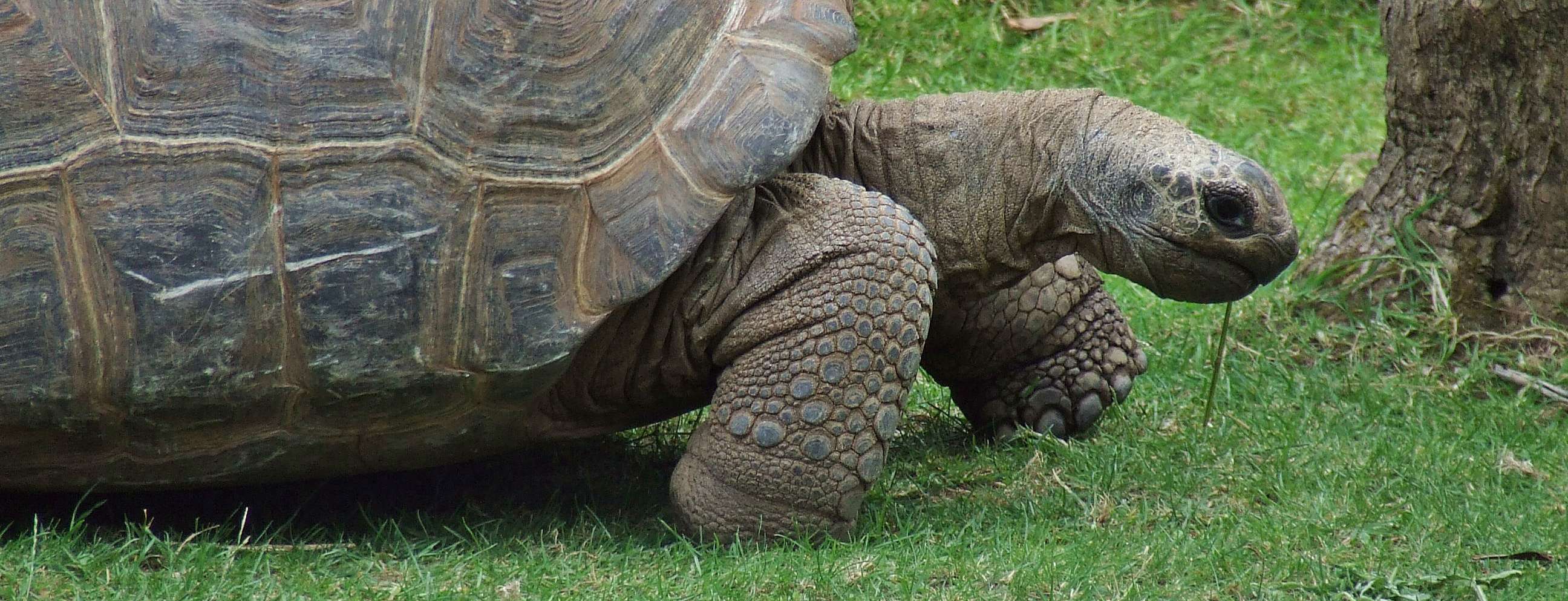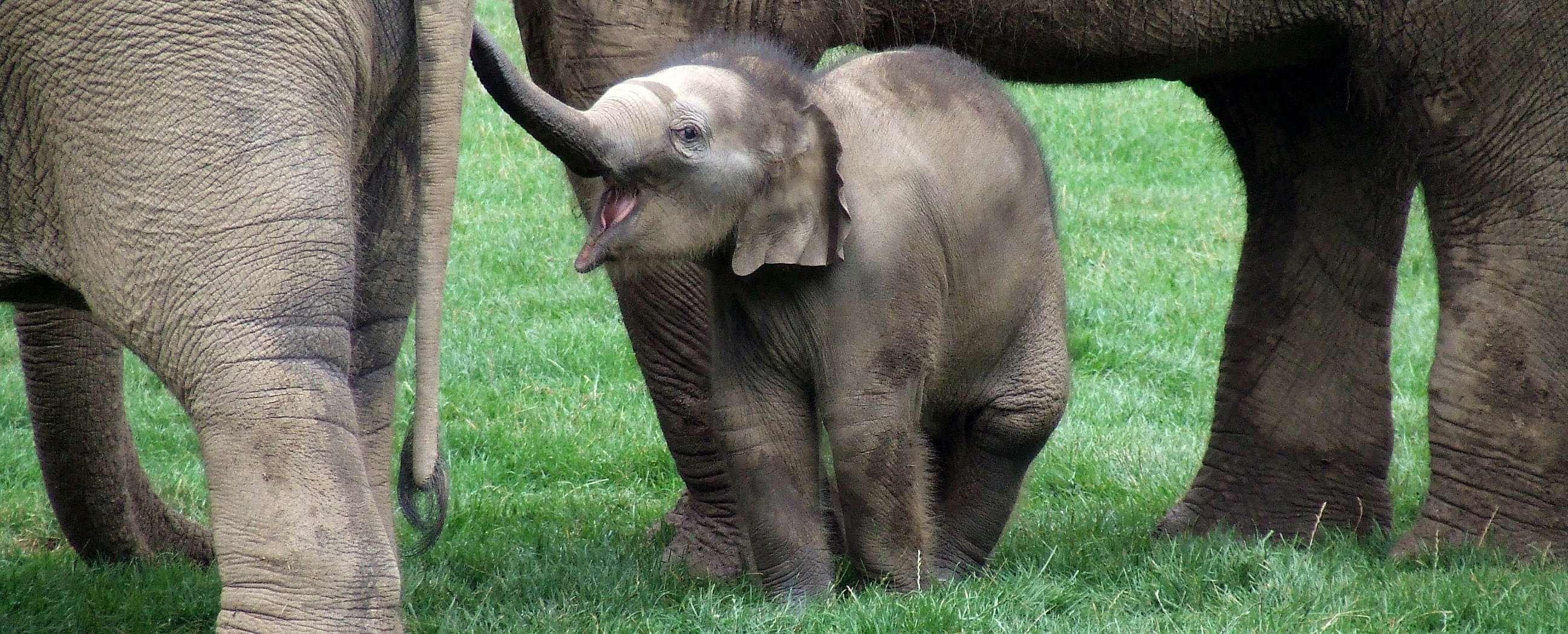Európa állatkertjei
ZOOlogical Gardens of EuROPE
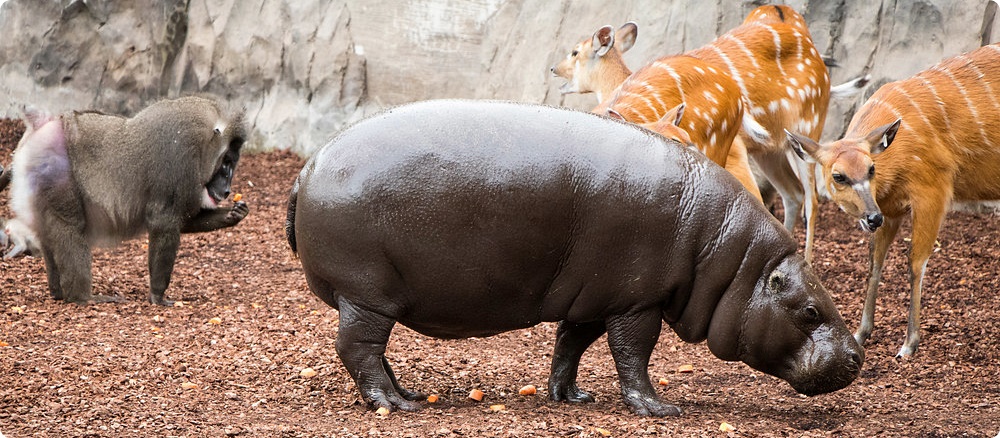
Mixed-species exhibits with zoo-housed Hippopotamuses (Hippopotamidae)
Written by KRISZTIÁN SVÁBIK
Team Leader, Toni’s Zoo, Rothenburg, Lucerne, Switzerland
15th June 2022
INTRODUCTION
Mixed-species exhibits with different mammals in the last few decades became a major trend. The success of a mixed-species exhibit depends on how we can take general animal husbandry criteria into account in more complex ways in comparison with a single-species exhibit. Those general rules that are important in animal exhibitry are still valid to a greater extent when presenting a multi-species captive environment. As many articles and other publications deal with the subject of general advantages and disadvantages of the mixed-species exhibits, instead of this, here I will assemble a detailed list of mixed exhibits involving at least one member of Hippopotamidae. The main aim of these documents is to summarize data and experiences about this exhibitry type with the hope that these manuals will be a useful supplement for the husbandry guidelines of both species of hippopotamids. Furthermore the study partly focuses on negative experiences in order to improve exhibit management criteria and trying to avoid combinations that have not been proved as successful.
The most important aspects of a successful mixed exhibit are the purposeful use of space and enclosure furnishings, the appropriate feeding techniques, decision-making of which species we want to breed and the right choice of species and individuals.
Use of space and enclosure furnishings
Generally speaking, one of the most critical factors is the size of the area: the larger the enclosure, the fewer the problems. Expanding the size of the whole captive habitat we can greatly increase the chances that the specimens of the different species are able to get out of each other’s way. Although this quantitative factor is also important, the quality of the given enclosure is much more crucial, since these agents can ensure the stress-free socialization of the combined species. It is extremely important to provide a secure outdoor and indoor space for the subdominant specimens whether belonging to the same species or not. The outdoor exhibit should be well-structured with many kinds of enclosure furnishing elements like small mounds, logs, rock formations and heavily planted areas so that the animals can get out of visual contact with others sharing the same enclosure and provide several escape routes in case of an aggressive contact between the different species. The best option is if the subdominant species have their own areas both outdoors and indoors.
Feeding
In terms of the daily routine tasks using the appropriate feeding techniques is one of the key factors of success. The experiences show that in several cases the associated species can be easily competitors of each other in reference to nutrition. Therefore it is necessary to feed the smaller species separately or provide as many feeding stations as possible throughout the whole enclosure and keep the competition to a minimum level, because most of the injuries and fatal accidents are the results of food-related aggression. In general, feeding the different species separately is a participating factor to manage the mixed-species exhibit successfully, but on the other hand this makes it difficult to apply certain food-related environmental enrichment methods in comparison with a single-species enclosure.
Breeding
One of the most important questions is to decide whether we would like to breed the species involved in a multi-species exhibit, or which species we want to breed. The practice of zoos keeping hippopotamids in a mixed exhibit shows that the presence of these large animals means potential danger for the other species when they are dominant in the given coexistence. Providing the abovementioned own areas or total separation can be the solution during the time of rearing the young. Furthermore, the behavioural changes of the adult animals during the breeding season must also be borne in mind which may easily lead to fatal injuries. Therefore it is really important to emphasize the possibility of proper separation. Generally speaking it seems to be true that the proper management of breeding in a mixed-species enclosure is more difficult – or sometimes impossible – than in a single-species exhibit. As a result, there is no aim to breed (all) the animals in this type of exhibitry in many cases, so sterilisation and single-sex grouping are also applied techniques in managing. If any of the species has an important breeding programme like SSP or EEP, it is worth to look over and analyse all the mentioned disadvantages before putting the given animals into a mixed enclosure.
Choice of species and individuals
According to the criteria of species selection, most of the known examples show that zoos exhibit animals together from the same geographic region for educational purposes. In the case of combining species that occupy similar ecological niches in nature the level of competition can be very high, therefore a large difference in body size between the combined species may be part of the solution. Choosing animals with different lifestyles – for example terrestrial-arboreal or diurnal-nocturnal – might be a good option as well. Although considering the theoretical approaches of the appropriate selection of species are also very important, we have to take into account that the success of the combination depends mostly on the individual level, simply because of the diverse individual characteristics of the animals in terms of behaviour. Correct introduction of the different species is a very sensitive issue which depends principally on the method of socialization and age of the animals. Introducing the smaller and subdominant species to the exhibit can be efficient due to exploring the whole area. During the socialization the principle of gradience should be followed, so visual and olfactory stimuli have to be the first before the possibility of physical contact of the animals. In general younger animals can be combined easier, but the experiences have shown us that many adults hippopotamid specimens have successfully been mixed with several other taxa.
List of mixed-species exhibits involving Hippopotamids
This document purposefully focuses on creating a list of mixed-species exhibits with family Hippopotamidae, for further and detailed information it is worth contacting the institutions mentioned below. Only a short summary of the general experiences is given at the end of the document. Many of the listed coexistences are still ongoing at present, but many of them are not anymore.
In the list below you can see that both species of hippopotamids have been kept in mixed exhibits in captivity:
Hippopotamuses, Hippopotamidae
Hippopotamus, Hippopotamus amphibius LINNAEUS, 1758
Pygmy Hippopotamus, Choeropsis liberiensis MORTON, 1849
Mutualism, as a didactic concept in mixed-species exhibitry
Studies have shown that many African birds have been observed to help groom Hippopotamuses by feeding on insects and parasites from the hippo’s back. The most frequently observed bird species are the Common Sandpiper (Actitis hypoleucos), African Pied Wagtail (Motacilla aguimp), Yellow-billed Oxpecker (Buphagus africanus) and Red-billed Oxpecker (Buphagus erythrorynchus) (OLIVIER & LAURIE 1974). Hippopotamuses and oxpeckers are in a mutualistic and parasitic relationship: this is because the oxpecker gets food and protection from the hippo, however, the bird gets food by making little cuts in the Hippopotamus to obtain insects.
Although these birds feed mainly on ticks, several studies have reported that oxpeckers can feed on wounded tissue, mucus, saliva, ear wax, hair and blood as well (BEZUIDENHOUT & STUTTERHEIM 1980, WEEKS 1999, PLANTAN 2009). Some authors definitely think that the interaction between oxpeckers and their mammalian hosts is parasitism, while others support mutualism even though they admit oxpeckers can cause injuries to hosts (SAMISH & REHACEK 1999). In fact the relationship between oxpeckers and large African herbivores could be context-dependent, where birds can be opportunists under particular biotic and abiotic conditions (NUNN et al. 2011, PLANTAN 2009). For example, a mutualistic relationship may develop when the ectoparasite load is high on the host, but oxpeckers may become parasitic when hosts carry few ticks with too many birds, and this leads to numerous open wounds (GAGNON et al. 2019).
The Common Sandpiper has often been reported on the backs of hippos (RICE 1963, THOMSON 1964) foraging from there for aquatic organisms. POOLEY (1967) gives further records of birds fishing off hippos, although CURRY-LINDAHL (1961) records 28 species of birds associating with Hippopotamuses (OLIVIER & LAURIE 1974). It is also worth mentioning that Hippopotamuses have commensally beneficial associations with birds and often they will use the backs of hippos as fishing sites. In nature species of stork, spoonbill, egret and heron – i.e. Goliath Heron (Ardea goliath) – have been observed on a regular basis – and further species such as Little Grebe (Tachybaptus ruficollis), Whistling-duck (Dendrocygna sp.), Egyptian Goose (Alopochen aegyptiaca) and Spur-winged Goose (Plectropterus gambensis) on a less regular basis – looking for plant material that Hippopotamuses displace (ELTRINGHAM 1999).
In zoo environment the mutualistic relationship between Red-billed Oxpecker and large African herbivores could be observed in the former Africa House in Zoo Zürich, where the birds lived together with Hippopotamuses, Southern White Rhinoceroses (Ceratotherium simum simum) and Eastern Black Rhinoceroses (Diceros bicornis michaeli) inside the building.
Those birds which are associated with Hippopotamuses in their natural habitat – i.e. herons, egrets, storks, spoonbills, geese and ducks – can also be seen together with hippos in captivity, many zoological institutions serve as examples for that.
Another important and definitely mutualistic relationship should be mentioned: it has long been known that different species of fish and Hippopotamuses are constant symbiotic companions. Fish clean hippos and are in turn nourished by the algae, parasites and dead skin scraped from the hides of their hosts. The amazing thing is that certain fish species specialize in cleaning specific body parts of the hippos. The Labeo – which is genus of carps – is the main cleaner, using its wide rasping mouth to scour the hippo’s hide. Barbus feeds on dung and cleans the cracks in the soles of the feet. Small cichlids graze around the tail bristles and tiny Garra clean out the wounds. Hippos deliberately splay their toes and spread their legs to provide easy access to the fish. The hippos even visit places where fish congregate in order to solicit cleanings (JOHNSON 2019). The African Cichlids – e.g. those live in Lake Malawi and Lake Victoria – together with another freshwater fish, e.g. different species of Tilapia, feed off the dung of the hippos, while the African Carp (Labeo coubie) feed on the dead skin as it flakes from the Hippopotamus, keeping their bodies clean.
On the other hand, a study was published in 2018 in reference to how the hippos’ presence in the Mara River in East Africa impacts other aquatic creatures and this research shows that vast numbers of fish were being killed downstream by hippo faeces (DUTTON et.al. 2018).
On the basis of the mutualism described above several zoological institutions place African Cichlids in the pond of their Hippopotamus exhibits not only because they both exist in their wild habitats together, but because would like to demonstrate their natural symbiotic relationship where different fish clean the hippos’ bodies which then provides them with a great source of nutrition and additionally help to improve the water quality of the pool.
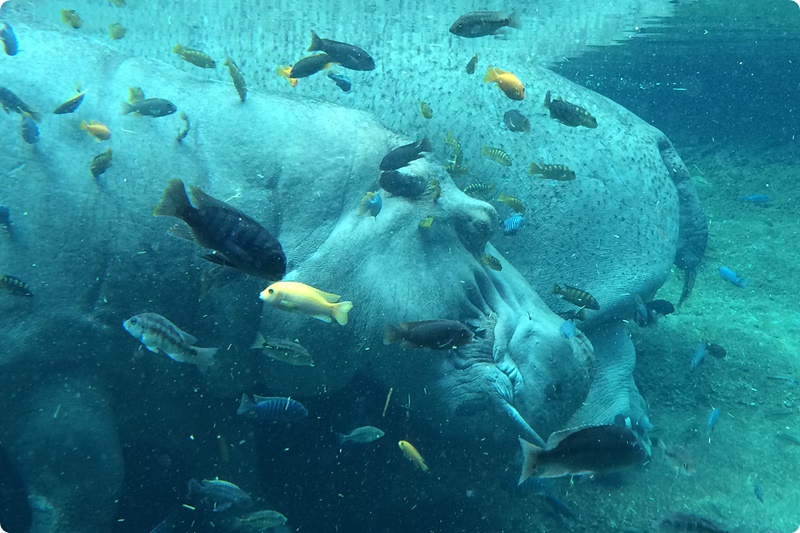
Hippopotamuses (Hippopotamus amphibius) and Lake Malawi Cichlids (Cichlidae)
San Antonio Zoo, San Antonio, Texas, United States of America
Photo © Len Radin
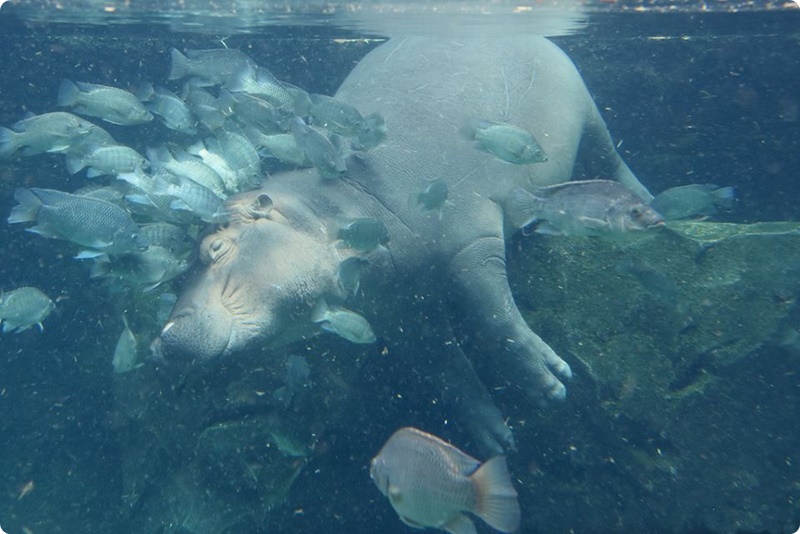
Young Hippopotamus (Hippopotamus amphibius) and Nile Tilapias (Oreochromis niloticus)
Cincinnati Zoo & Botanical Garden, Cincinnati, Ohio, United States of America
Photo © Lisa Hubbard
LIST OF SPECIES COMBINATIONS - HIPPOPOTAMIDAE
The list shows examples of species combinations with at least one hippopotamus species combined with the taxa below
Hippopotamus, Hippopotamus amphibius (Photo © Krisztián Svábik)
Asian Elephant, Elephas maximus
African Elephant, Loxodonta africana
Geoffroy's Spider Monkey, Ateles geoffroyi
Vervet Monkey, Chlorocebus pygerythrus
Capybara, Hydrochoerus hydrochaeris
Cape Porcupine, Hystrix africaeaustralis
Egyptian Fruit Bat, Rousettus aegyptiacus
Rodrigues Flying Fox, Pteropus rodricensis
California Sea Lion, Zalophus californianus
Plains Zebra, Equus quagga
Grant’s Zebra, Equus quagga boehmi
Chapman’s Zebra, Equus quagga chapmani
Grevy’s Zebra, Equus grevyi
Southern White Rhinoceros, Ceratotherium simum simum
Dromedary Camel, Camelus dromedarius
Common Warthog, Phacochoerus africanus
Southern Warthog, Phacochoerus africanus sundevallii
Red River Hog, Potamochoerus porcus
Pygmy Hippopotamus, Choeropsis liberiensis
Chital, Axis axis
Hog Deer, Axis porcinus
Central European Red Deer, Cervus elaphus hippelaphus
Nyala, Tragelaphus angasii
Bushbuck, Tragelaphus scriptus
Southern Bushbuck, Tragelaphus scriptus sylvaticus
Western Sitatunga, Tragelaphus spekii gratus
Greater Kudu, Tragelaphus strepsiceros
Common Eland, Tragelaphus oryx
Addax, Addax nasomaculatus
Red Hartebeest, Alcelaphus buselaphus caama
Blesbok, Damaliscus pygargus phillipsi
Waterbuck, Kobus ellipsiprymnus ellipsiprymnus
Defassa Waterbuck, Kobus ellipsiprymnus defassa
Red Lechwe, Kobus leche leche
Nile Lechwe, Kobus megaceros
Common Impala, Aepyceros melampus melampus
Springbok, Antidorcas marsupialis
Thomson's Gazelle, Eudorcas thomsonii
Fringe-eared Oryx, Oryx beisa callotis
Scimitar-horned Oryx, Oryx dammah
Arabian Oryx, Oryx leucoryx
Roan Antelope, Hippotragus equinus
Sable Antelope, Hippotragus niger niger
Common Wildebeest, Connochaetes taurinus
Eastern White-bearded Wildebeest, Connochaetes taurinus albojubatus
Cape Buffalo, Syncerus caffer
Ankole-Watusi Cattle, Bos primigenius f. taurus
Domesticated Water Buffalo, Bubalus arnee f. bubalis
South African Giraffe, Giraffa camelopardalis giraffa
Reticulated Giraffe, Giraffa camelopardalis reticulata
Rothschild's Giraffe, Giraffa camelopardalis rothschildi
Ostrich, Struthio camelus
North African Ostrich, Struthio camelus camelus
South African Ostrich, Struthio camelus australis
Masai Ostrich, Struthio camelus massaicus
Dalmatian Pelican, Pelecanus crispus
Great White Pelican, Pelecanus onocrotalus
Pink-backed Pelican, Pelecanus rufescens
Great Cormorant, Phalacrocorax carbo
White-breasted Cormorant, Phalacrocorax lucidus
Great White Egret, Ardea alba
Goliath Heron, Ardea goliath
Cattle Egret, Bubulcus ibis
Hamerkop, Scopus umbretta
Abdim’s Stork, Ciconia abdimii
White Stork, Ciconia ciconia
Yellow-billed Stork, Mycteria ibis
African Openbill, Anastomus lamelligerus
Saddle-billed Stork, Ephippiorhynchus senegalensis
Marabou, Leptoptilos crumenifer
African Spoonbill, Platalea alba
White Ibis, Eudocimus albus
Glossy Ibis, Plegadis falcinellus
Hadada Ibis, Bostrychia hagedash
Southern Bald Ibis, Geronticus calvus
African Sacred Ibis, Threskiornis aethiopicus
Greater Flamingo, Phoenicopterus roseus
African Comb Duck, Sarkidiornis melanotos
Black-bellied Whistling-duck, Dendrocygna autumnalis
Fulvous Whistling-duck, Dendrocygna bicolor
White-faced Whistling-duck, Dendrocygna viduata
Ruddy Shelduck, Tadorna ferruginea
Egyptian Goose, Alopochen aegyptiaca
Blue-winged Goose, Cyanochen cyanoptera
Northern Pintail, Anas acuta
Cape Teal, Anas capensis
Red-billed Teal, Anas erythrorhyncha
Mallard, Anas platyrhynchos
Yellow-billed Duck, Anas undulata
White-eyed Duck, Aythya australis
Tufted Duck, Aythya fuligula
Marbled Teal, Marmaronetta angustirostris
Southern Pochard, Netta erythrophthalma
White-headed Duck, Oxyura leucocephala
American Black Vulture, Coragyps atratus
Palm-nut Vulture, Gypohierax angolensis
Hooded Vulture, Necrosyrtes monachus
White-headed Vulture, Trigonoceps occipitalis
Helmeted Guineafowl, Numida meleagris
Domestic Chicken, Gallus gallus f. domestica
Common Coot, Fulica atra
Purple Swamphen, Porphyrio porphyrio
Grey Crowned-crane, Balearica regulorum
South African Grey Crowned-crane, Balearica regulorum regulorum
Wattled Crane, Bugeranus carunculatus
White-bellied Bustard, Eupodotis senegalensis
Spur-winged Lapwing, Vanellus spinosus
Brown-faced Go-away-bird, Corythaixoides personatus
Taveta Golden Weaver, Ploceus castaneiceps
Village Weaver, Ploceus cucullatus
Red-billed Oxpecker, Buphagus erythrorynchus
Aldabra Giant Tortoise, Aldabrachelys gigantea
Black-bellied Slider, Trachemys dorbigni
African Cichlids, Cichlidae
Zebra Tilapia, Heterotilapia buettikoferi
Nile Tilapia, Oreochromis niloticus
Spotted Tilapia, Pelmatolapia mariae
Common Carp, Cyprinus carpio
Grass Carp, Ctenopharyngodon idella
Northern Pike, Esox lucius
Black Pacu, Colossoma macropomum
Green Swordtail, Xiphophorus hellerii
Saltan Fish, Leptobarbus rubripinna
other fish
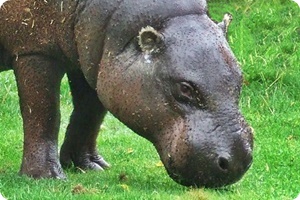 Pygmy Hippopotamus, Choeropsis liberiensis (Photo © Krisztián Svábik)
Pygmy Hippopotamus, Choeropsis liberiensis (Photo © Krisztián Svábik)
African Elephant, Loxodonta africana
Saddleback Tamarin, Leontocebus fuscicollis
Red-chested Mustached Tamarin, Saguinus labiatus
Goeldi’s Monkey, Callimico goeldii
White-faced Saki, Pithecia pithecia
Northern Talapoin Monkey, Miopithecus ogouensis
Sykes’s Monkey, Cercopithecus albogularis
Red-tailed Monkey, Cercopithecus ascanius
Diana Monkey, Cercopithecus diana
Blue Monkey, Cercopithecus mitis
Stuhlmann's Blue Monkey, Cercopithecus mitis stuhlmanni
Mona Monkey, Cercopithecus mona
De Brazza’s Monkey, Cercopithecus neglectus
Spot-nosed Monkey, Cercopithecus petaurista
Roloway Monkey, Cercopithecus roloway
Wolf's Monkey, Cercopithecus wolfi
Sooty Mangabey, Cercocebus atys
Red-capped Mangabey, Cercocebus torquatus
Barbary Macaque, Macaca sylvanus
Drill, Mandrillus leucophaeus
Mandrill, Mandrillus sphinx
Angolan Colobus, Colobus angolensis
Peters' Angolan Colobus, Colobus angolensis palliatus
Guereza, Colobus guereza
Silvery Gibbon, Hylobates moloch
Sumatran Orangutan, Pongo abelii
Western Lowland Gorilla, Gorilla gorilla gorilla
Serval, Leptailurus serval
Plains Zebra, Equus quagga
Grant’s Zebra, Equus quagga boehmi
Grevy’s Zebra, Equus grevyi
Southern White Rhinoceros, Ceratotherium simum simum
Northern White Rhinoceros, Ceratotherium simum cottoni
Black Rhinoceros, Diceros bicornis
Eastern Black Rhinoceros, Diceros bicornis michaeli
Red River Hog, Potamochoerus porcus
Hippopotamus, Hippopotamus amphibius
Southern Pudu, Pudu puda
Mountain Bongo, Tragelaphus eurycerus isaaci
Sitatunga, Tragelaphus spekii
East African Sitatunga, Tragelaphus spekii spekii
Western Sitatunga, Tragelaphus spekii gratus
Greater Kudu, Tragelaphus strepsiceros
Common Eland, Tragelaphus oryx
East African Eland, Tragelaphus oryx pattersonianus
Addax, Addax nasomaculatus
Topi, Damaliscus korrigum jimela
Bontebok, Damaliscus pygargus pygargus
Waterbuck, Kobus ellipsiprymnus
Defassa Waterbuck, Kobus ellipsiprymnus defassa
Kob, Kobus kob
Uganda Kob, Kobus kob thomasi
Southern Lechwe, Kobus leche
Red Lechwe, Kobus leche leche
Kafue Lechwe, Kobus leche kafuensis
Nile Lechwe, Kobus megaceros
Common Impala, Aepyceros melampus
Thomson's Gazelle, Eudorcas thomsonii
Slender-horned Gazelle, Gazella leptoceros
Dama Gazelle, Nanger dama
Grant's Gazelle, Nanger granti
Scimitar-horned Oryx, Oryx dammah
Fringe-eared Oryx, Oryx beisa callotis
Gemsbok, Oryx gazella
Roan Antelope, Hippotragus equinus
Angolan Roan Antelope, Hippotragus equinus cottoni
Common Wildebeest, Connochaetes taurinus
Eastern White-Bearded Wildebeest, Connochaetes taurinus albojubatus
Cape Buffalo, Syncerus caffer
Aoudad, Ammotragus lervia
Red-flanked Duiker, Cephalophus rufilatus
Cape Blue Duiker, Philantomba monticola monticola
Congo Blue Duiker, Philantomba monticola congica
Rothschild's Giraffe, Giraffa camelopardalis rothschildi
Ostrich, Struthio camelus
Great White Pelican, Pelecanus onocrotalus
Goliath Heron, Ardea goliath
Black-crowned Night-heron, Nycticorax nycticorax
Cattle Egret, Bubulcus ibis
Hamerkop, Scopus umbretta
White Stork, Ciconia ciconia
Yellow-billed Stork, Mycteria ibis
Marabou, Leptoptilos crumenifer
African Spoonbill, Platalea alba
Hadada Ibis, Bostrychia hagedash
Black Swan, Cygnus atratus
Mute Swan, Cygnus olor
Greylag Goose, Anser anser
Hawaiian Goose, Branta sandvicensis
Egyptian Goose, Alopochen aegyptiaca
Fulvous Whistling-duck, Dendrocygna bicolor
African Black Duck, Anas sparsa
Hartlaub's Duck, Pteronetta hartlaubii
Rüppell's Vulture, Gyps rueppelli
Domestic Helmeted Guineafowl, Numida meleagris f. domestica
Blue Crane, Anthropoides paradiseus
Grey Crowned-crane, Balearica regulorum
Violet Turaco, Musophaga violacea
African Grey Hornbill, Lophoceros nasutus
Red-billed Hornbill, Tockus erythrorhynchus
Jackson's Hornbill, Tockus jacksoni
Trumpeter Hornbill, Bycanistes bucinator
Grey-cheeked Hornbill, Bycanistes subcylindricus
Speckled Mousebird, Colius striatus
Lilac-breasted Roller, Coracias caudatus
Bearded Barbet, Pogonornis dubius
Eastern Yellow-billed Barbet, Trachylaemus purpuratus
Eastern Black-headed Oriole, Oriolus larvatus
Purple Starling, Lamprotornis purpureus
Superb Starling, Lamprotornis superbus
Cape White-eye, Zosterops virens
Buff-throated Sunbird, Chalcomitra adelberti
Olive Sunbird, Cyanomitra olivacea
Green-headed Sunbird, Cyanomitra verticalis
Red-tailed Bristlebill, Bleda syndactylus
Blue-shouldered Robin-chat, Cossypha cyanocampter
Green Twinspot, Mandingoa nitidula
Grey-headed Nigrita, Nigrita canicapillus
White-headed Buffalo-weaver, Dinemellia dinemelli
Black-billed Weaver, Ploceus melanogaster
African Spurred Tortoise, Centrochelys sulcata
African Softshell Turtle, Trionyx triunguis
African Cichlids, Cichlidae
Zebra Tilapia, Heterotilapia buettikoferi
Spotted Tilapia, Pelmatolapia mariae
Nile Perch, Lates niloticus
Common Carp, Cyprinus carpio
Koi, Cyprinus carpio f. domestica
Grass Carp, Ctenopharyngodon idella
African Catfish, Clarias gariepinus
other fish
LIST OF MIXED-SPECIES EXHIBITS WITH LOCATIONS - HIPPOPOTAMIDAE
The list shows specific examples of current and historic mixed-species exhibits involving at least one hippopotamus species combined with the taxa below, with indication of the institution(s) where they have been tried out
Hippopotamus, Hippopotamus amphibius
Combined species:
- Hippopotamus, Hippopotamus amphibius
- Asian Elephant, Elephas maximus
- Domesticated Water Buffalo, Bubalus arnee f. bubalis
- Black-bellied Whistling-duck, Dendrocygna autumnalis
- White-faced Whistling-duck, Dendrocygna viduata
- Black-bellied Slider, Trachemys dorbigni
Institution(s): Zooparque Itatiba (Itatiba, São Paulo, Brazil)
Combined species:
- Hippopotamus, Hippopotamus amphibius
- African Elephant, Loxodonta africana
- Grant’s Zebra, Equus quagga boehmi
- Grevy’s Zebra, Equus grevyi
- Southern White Rhinoceros, Ceratotherium simum simum
- Greater Kudu, Tragelaphus strepsiceros
- Common Eland, Tragelaphus oryx
- Red Hartebeest, Alcelaphus buselaphus caama
- Common Impala, Aepyceros melampus
- Springbok, Antidorcas marsupialis
- Roan Antelope, Hippotragus equinus
- Cape Buffalo, Syncerus caffer
- Ankole-Watusi Cattle, Bos primigenius f. taurus
- Reticulated Giraffe, Giraffa camelopardalis reticulata
- Ostrich, Struthio camelus
Institution(s): Parque Zoológico Nacional (Havana, Cuba)
![]()
Hippopotamuses (Hippopotamus amphibius) and Grant’s Zebras (Equus quagga boehmi)
Parque Zoológico Nacional, Havana, Cuba
Photo © Hector Jozami
Combined species:
- Hippopotamus, Hippopotamus amphibius
- Geoffroy's Spider Monkey, Ateles geoffroyi
- Capybara, Hydrochoerus hydrochaeris
- birds
Institution(s): Jardín Zoológico de la Habana (Havana, Cuba)
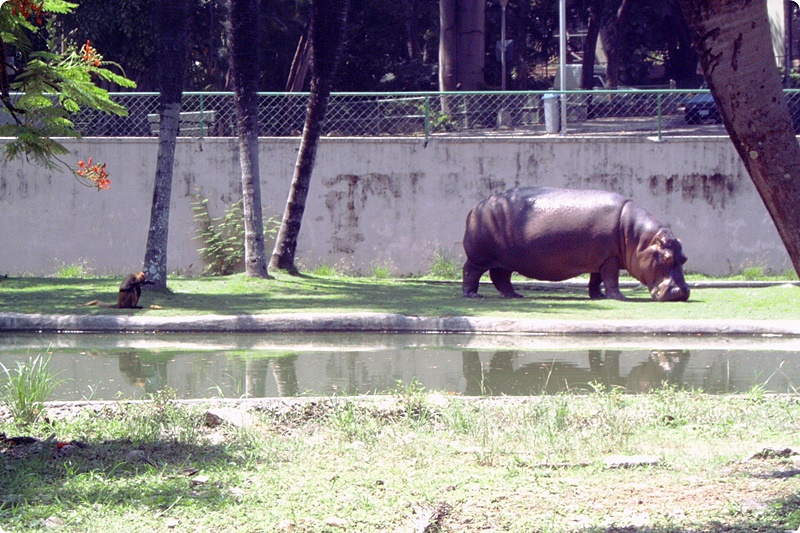
Hippopotamus (Hippopotamus amphibius) and Geoffroy's Spider Monkey (Ateles geoffroyi)
Jardín Zoológico de la Habana, Havana, Cuba
Photo © Nick Hadad
Combined species:
- Hippopotamus, Hippopotamus amphibius
- Vervet Monkey, Chlorocebus pygerythrus
- Common Eland, Tragelaphus oryx
- Fringe-eared Oryx, Oryx beisa callotis
- Cape Buffalo, Syncerus caffer
- African Sacred Ibis, Threskiornis aethiopicus
- Egyptian Goose, Alopochen aegyptiaca
- Grey Crowned-crane, Balearica regulorum
- other birds
Institution(s): Haller Park (Mombasa, Kenya)
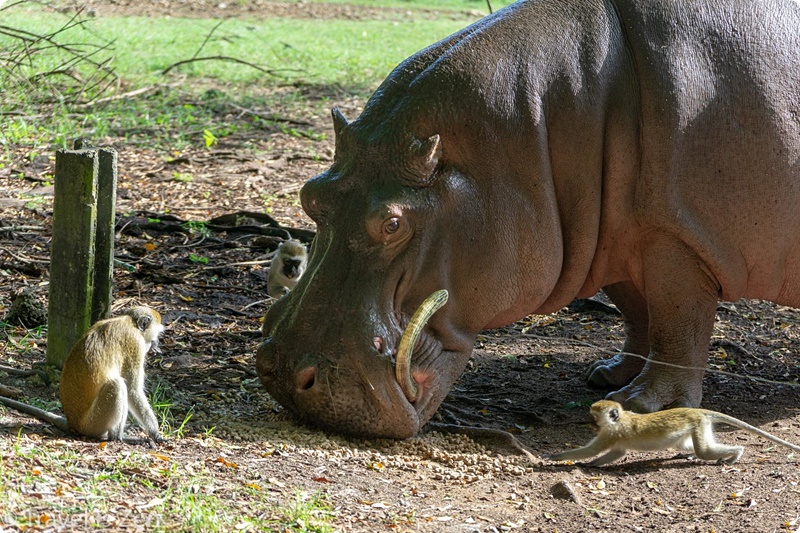
Hippopotamus (Hippopotamus amphibius) and Vervet Monkeys (Chlorocebus pygerythrus)
Haller Park, Mombasa, Kenya
Photo © www.traveliszen.com
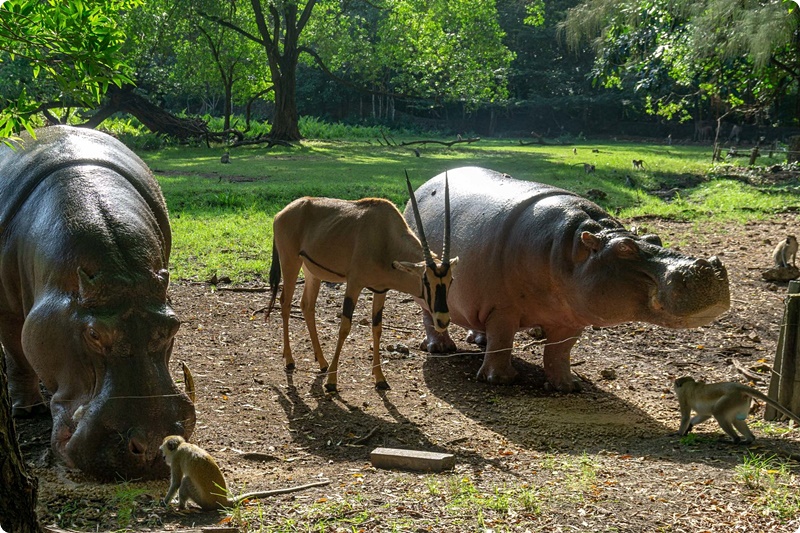
Hippopotamuses (Hippopotamus amphibius), Vervet Monkeys (Chlorocebus pygerythrus) and Fringe-eared Oryx (Oryx beisa callotis)
Haller Park, Mombasa, Kenya
Photo © www.traveliszen.com
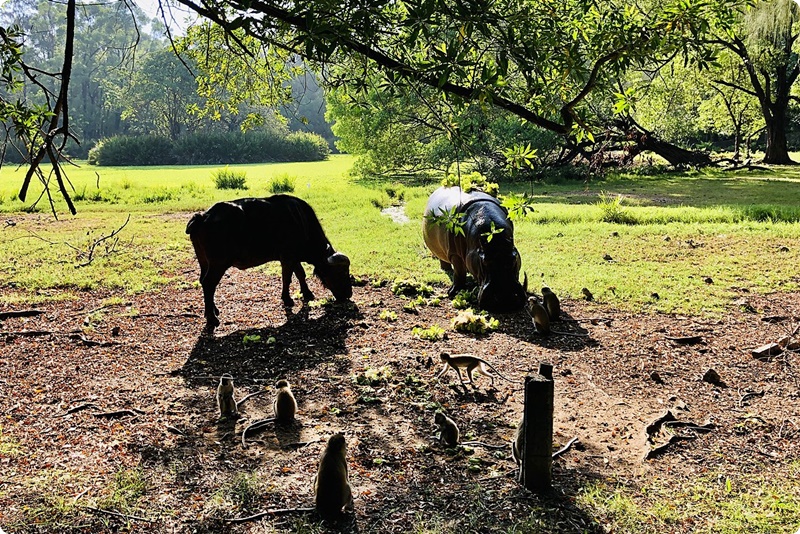
Hippopotamus (Hippopotamus amphibius), Vervet Monkeys (Chlorocebus pygerythrus) and Cape Buffalo (Syncerus caffer)
Haller Park, Mombasa, Kenya
Photo © Ruzam Namor
Combined species:
- Hippopotamus, Hippopotamus amphibius
- Cape Porcupine, Hystrix africaeaustralis
- Cattle Egret, Bubulcus ibis
- Hamerkop, Scopus umbretta
- Abdim’s Stork, Ciconia abdimii
- Taveta Golden Weaver, Ploceus castaneiceps
- previously duck (assorted species)
- previously Purple Swamphen, Porphyrio porphyrio
- previously Crowned-crane, Balearica sp.
- previously White-bellied Bustard, Eupodotis senegalensis
- African Cichlids, Cichlidae
Institution(s): Adventure Aquarium (Camden, New Jersey, United States of America)
Combined species:
- Hippopotamus, Hippopotamus amphibius
- Cape Porcupine, Hystrix africaeaustralis
- African Cichlids, Cichlidae
Institution(s): Adventure Aquarium (Camden, New Jersey, United States of America)
Combined species:
- Hippopotamus, Hippopotamus amphibius
- Egyptian Fruit Bat, Rousettus aegyptiacus
Institution(s): Tiergarten Schönbrunn (Vienna, Austria)
Combined species:
- Hippopotamus, Hippopotamus amphibius
- Rodrigues Flying Fox, Pteropus rodricensis
- Western Sitatunga, Tragelaphus spekii gratus
- previously Fulvous Whistling-duck, Dendrocygna bicolor
- White-faced Whistling-duck, Dendrocygna viduata (only indoor)
- Helmeted Guineafowl, Numida meleagris
- previously Grey Crowned-crane, Balearica regulorum
- Wattled Crane, Bugeranus carunculatus
- Nile Tilapia, Oreochromis niloticus
Institution(s): Kölner Zoo (Cologne, Germany)
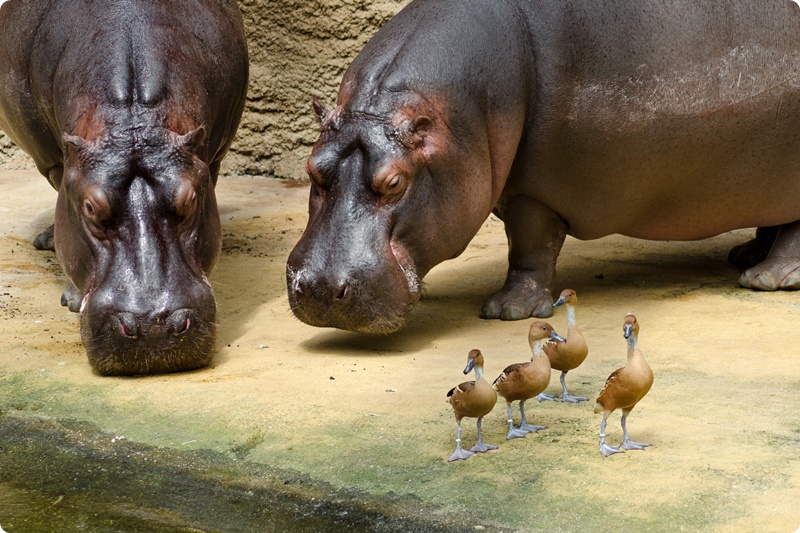
Hippopotamuses (Hippopotamus amphibius) and Fulvous Whistling-ducks (Dendrocygna bicolor)
Kölner Zoo, Cologne, Germany
Photo © Patrick Dannewitz
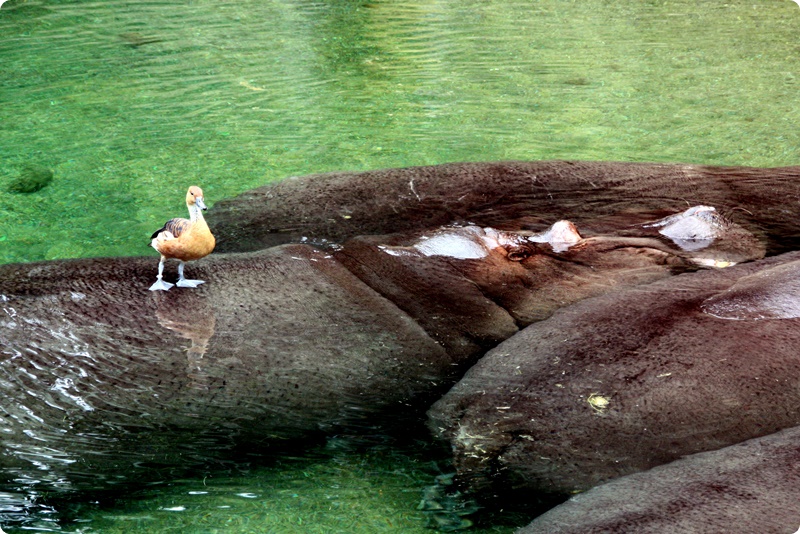
Hippopotamuses (Hippopotamus amphibius) and Fulvous Whistling-duck (Dendrocygna bicolor)
Kölner Zoo, Cologne, Germany
Photo © Martin Fisch
Hippopotamus (Hippopotamus amphibius) and bird indoor mixed-species exhibit
Kölner Zoo, Cologne, Germany
Photo © Ben Gilbert
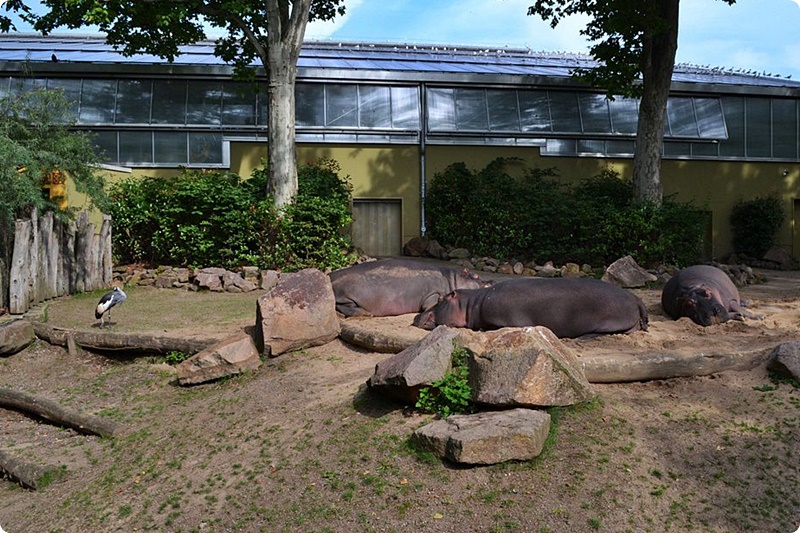
Hippopotamuses (Hippopotamus amphibius) and Grey Crowned-crane (Balearica regulorum)
Kölner Zoo, Cologne, Germany
Photo © Antal Nagy
Combined species:
- Hippopotamus, Hippopotamus amphibius
- California Sea Lion, Zalophus californianus
Institution(s): Longleat (Warminster, United Kingdom)
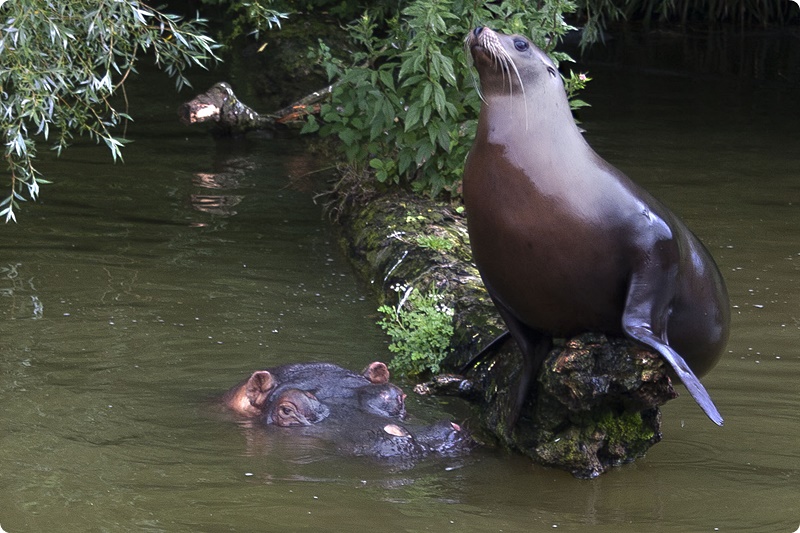
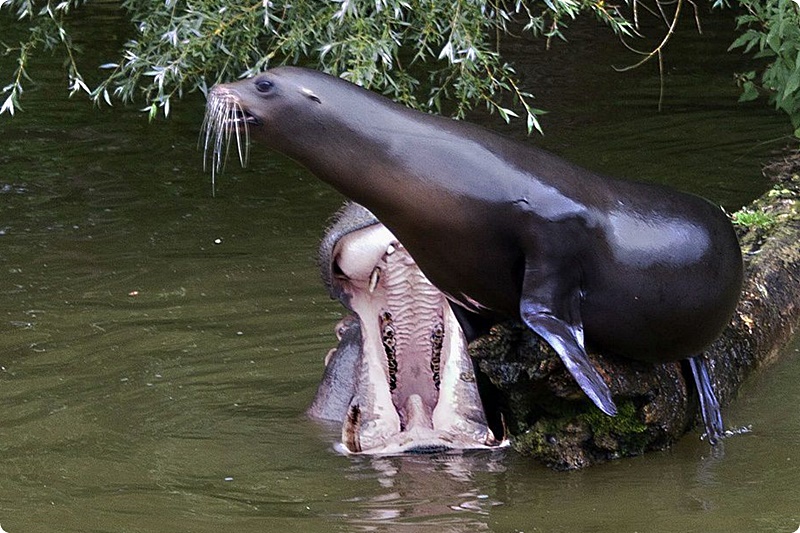
Hippopotamus (Hippopotamus amphibius) and California Sea Lion (Zalophus californianus)
Longleat, Warminster, United Kingdom
Photos © Keith Park
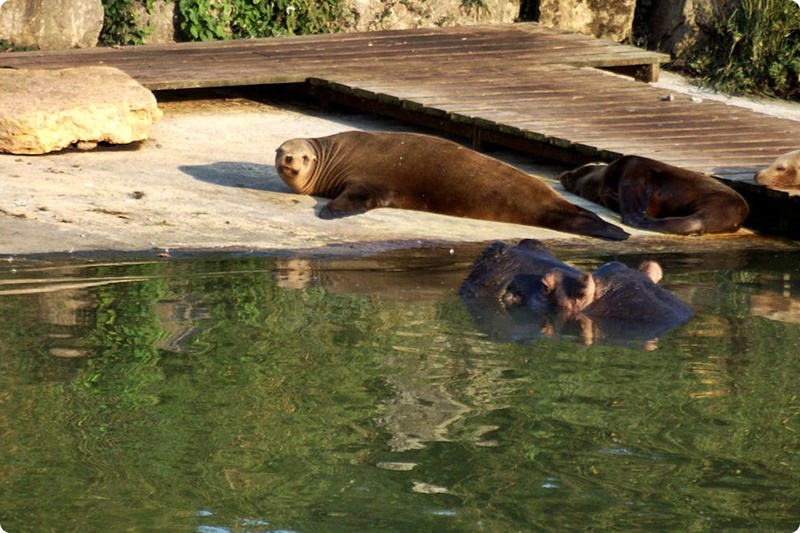
Hippopotamus (Hippopotamus amphibius) and California Sea Lions (Zalophus californianus)
Longleat, Warminster, United Kingdom
Photo © www.hiveminer.com
Hippopotamus (Hippopotamus amphibius) and California Sea Lion (Zalophus californianus) mixed exhibit
Longleat, Warminster, United Kingdom
Photo © Ben Gilbert
Combined species:
- Hippopotamus, Hippopotamus amphibius
- Grant’s Zebra, Equus quagga boehmi
- Southern White Rhinoceros, Ceratotherium simum simum
- Common Eland, Tragelaphus oryx
- Defassa Waterbuck, Kobus ellipsiprymnus defassa
- Thomson's Gazelle, Eudorcas thomsonii
- Scimitar-horned Oryx, Oryx dammah
- Arabian Oryx, Oryx leucoryx
- Eastern White-bearded Wildebeest, Connochaetes taurinus albojubatus
- North African Ostrich, Struthio camelus camelus
- Pelican, Pelecanus sp.
- White Stork, Ciconia ciconia
- Marabou, Leptoptilos crumenifer
- Glossy Ibis, Plegadis falcinellus
- Greater Flamingo, Phoenicopterus roseus
- Egyptian Goose, Alopochen aegyptiaca
- Mallard, Anas platyrhynchos
- Common Coot, Fulica atra
- Grey Crowned-crane, Balearica regulorum
- Spur-winged Lapwing, Vanellus spinosus
- other birds
Institution(s): Zoological Center Tel Aviv – Safari Ramat Gan (Ramat Gan, Israel)
Large group of Hippopotamus (Hippopotamus amphibius) in a mixed-species exhibit
Zoological Center Tel Aviv – Safari Ramat Gan, Ramat Gan, Israel
Photo © Alex Kantorovich
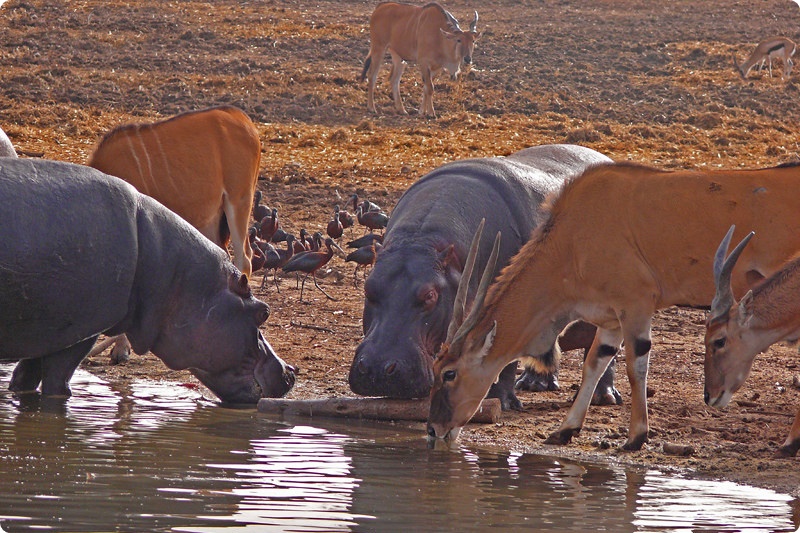
Hippopotamuses (Hippopotamus amphibius) and Common Elands (Tragelaphus oryx)
Zoological Center Tel Aviv – Safari Ramat Gan, Ramat Gan, Israel
Photo © Zachi Evenor
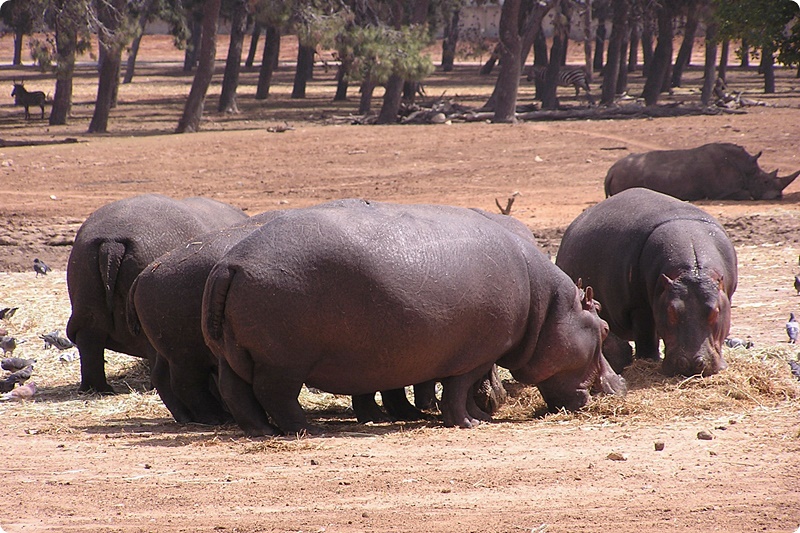
Hippopotamuses (Hippopotamus amphibius) and Southern White Rhinoceros (Ceratotherium simum simum)
Zoological Center Tel Aviv – Safari Ramat Gan, Ramat Gan, Israel
Photo © Asaf Keisar
Hippopotamuses (Hippopotamus amphibius), Grant's Zebra (Equus quagga boehmi), Arabian Oryx (Oryx leucoryx) and Eastern White-bearded Wildebeest (Connochaetes taurinus albojubatus)
Zoological Center Tel Aviv – Safari Ramat Gan, Ramat Gan, Israel
Photo © Alex Kantorovich
Hippopotamuses (Hippopotamus amphibius), Grant's Zebras (Equus quagga boehmi), Southern White Rhinoceroses (Ceratotherium simum simum), Scimitar-horned Oryxes (Oryx dammah) and Arabian Oryxes (Oryx leucoryx)
Zoological Center Tel Aviv – Safari Ramat Gan, Ramat Gan, Israel
Photo © Alex Kantorovich
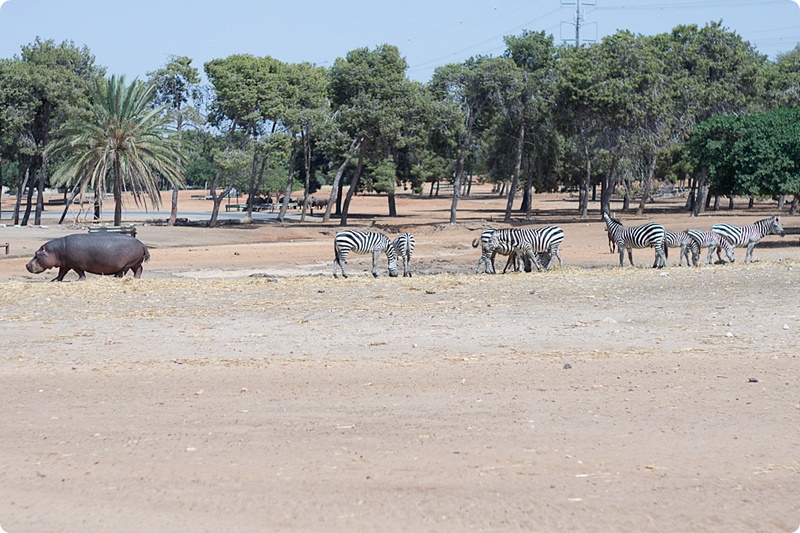
Hippopotamus (Hippopotamus amphibius) and Grant's Zebras (Equus quagga boehmi)
Zoological Center Tel Aviv – Safari Ramat Gan, Ramat Gan, Israel
Photo © Eugene Nikiforov
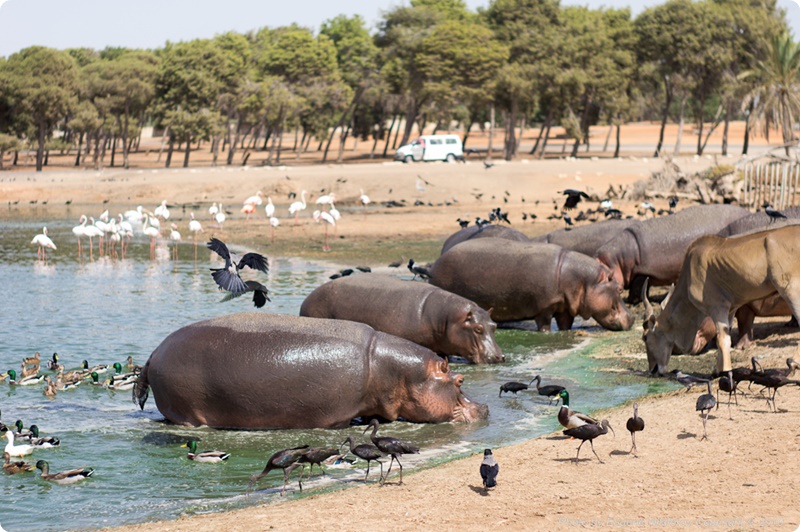
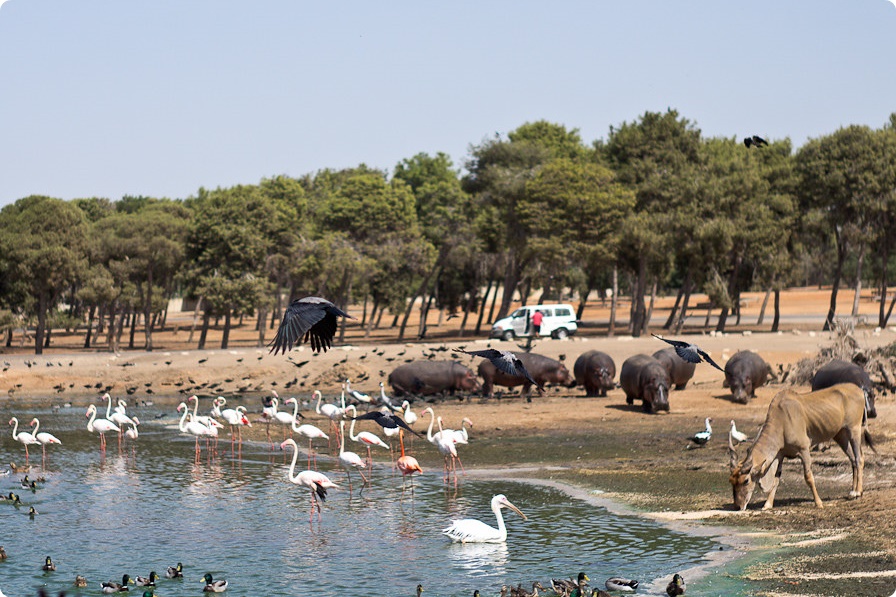
Hippopotamuses (Hippopotamus amphibius), Common Eland (Tragelaphus oryx) and birds
Zoological Center Tel Aviv – Safari Ramat Gan, Ramat Gan, Israel
Photos © Eugene Nikiforov
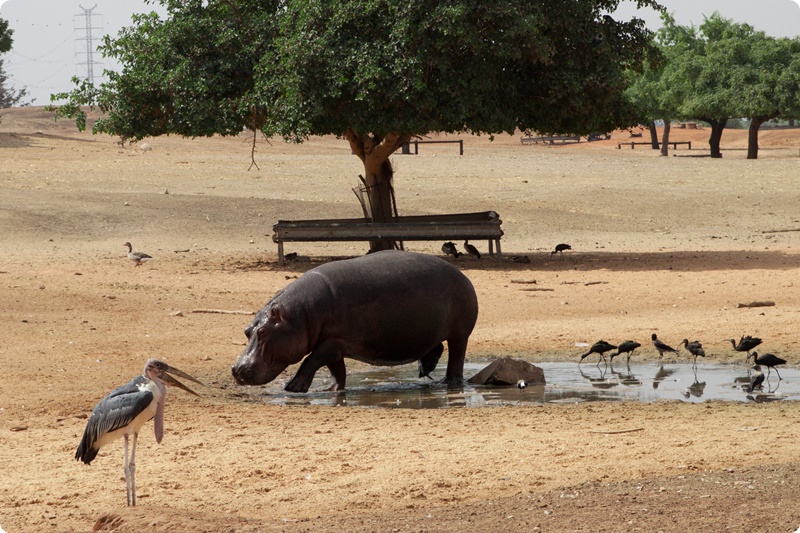
Hippopotamus (Hippopotamus amphibius), Marabou (Leptoptilos crumenifer) and other birds
Zoological Center Tel Aviv – Safari Ramat Gan, Ramat Gan, Israel
Photo © Oren Rozen
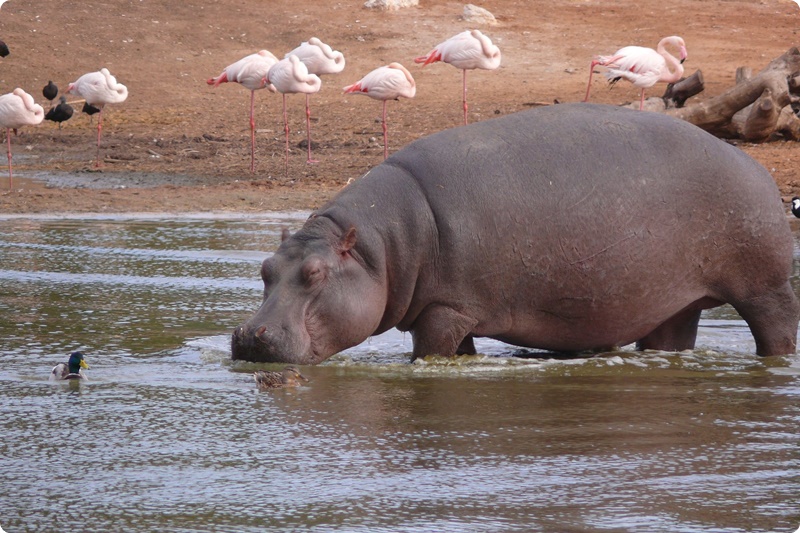
Hippopotamus (Hippopotamus amphibius), Greater Flamingos (Phoenicopterus roseus) and other birds
Zoological Center Tel Aviv – Safari Ramat Gan, Ramat Gan, Israel
Photo © Zachi Evenor
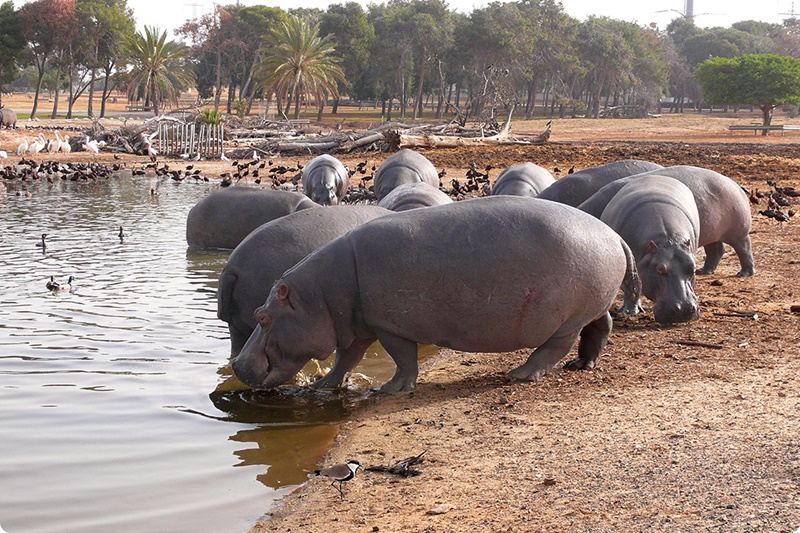
Hippopotamuses (Hippopotamus amphibius) and birds
Zoological Center Tel Aviv – Safari Ramat Gan, Ramat Gan, Israel
Photo © Zachi Evenor
Hippopotamuses (Hippopotamus amphibius) and birds
Zoological Center Tel Aviv – Safari Ramat Gan, Ramat Gan, Israel
Photo © Alex Kantorovich
Combined species:
- Hippopotamus, Hippopotamus amphibius
- Grant’s Zebra, Equus quagga boehmi
- Southern White Rhinoceros, Ceratotherium simum simum
- Addax, Addax nasomaculatus
- South African Giraffe, Giraffa camelopardalis giraffa
- Masai Ostrich, Struthio camelus massaicus
- Marabou, Leptoptilos crumenifer
Institution(s): The Tisch Family Zoological Gardens – Jerusalem Biblical Zoo (Jerusalem, Israel)
Hippopotamus (Hippopotamus amphibius) and Grant's Zebra (Equus quagga boehmi)
The Tisch Family Zoological Gardens – Jerusalem Biblical Zoo, Jerusalem, Israel
Photo © Jerusalem Biblical Zoo
Hippopotamus (Hippopotamus amphibius) in a mixed-species exhibit
The Tisch Family Zoological Gardens – Jerusalem Biblical Zoo, Jerusalem, Israel
Photo © Alex Kantorovich
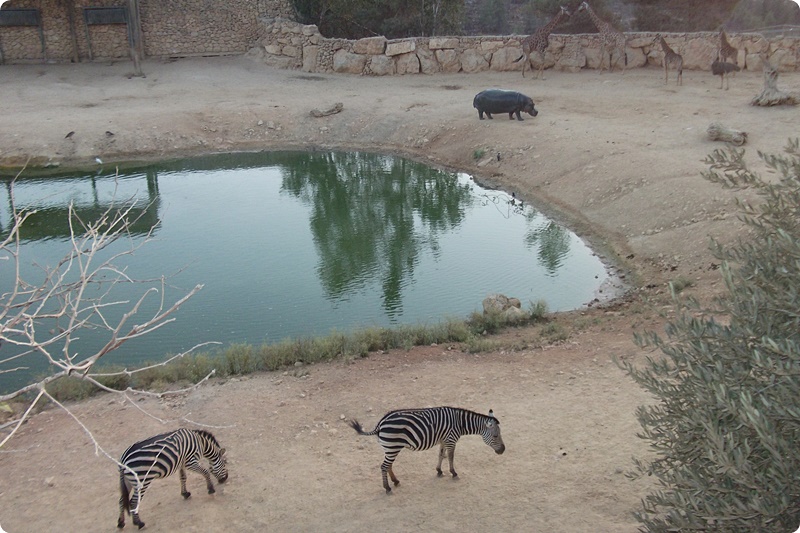
Hippopotamus (Hippopotamus amphibius) in a mixed-species exhibit
The Tisch Family Zoological Gardens – Jerusalem Biblical Zoo, Jerusalem, Israel
Photo © Wikimedia Commons
Combined species:
- Hippopotamus, Hippopotamus amphibius
- Grant’s Zebra, Equus quagga boehmi
- Dromedary Camel, Camelus dromedarius
- Common Eland, Tragelaphus oryx
- Ostrich, Struthio camelus
Institution(s): Taronga Western Plains Zoo (Dubbo, New South Wales, Australia)
Combined species:
- Hippopotamus, Hippopotamus amphibius
- Chapman’s Zebra, Equus quagga chapmani
- Common Warthog, Phacochoerus africanus
- Nyala, Tragelaphus angasii
- Greater Kudu, Tragelaphus strepsiceros
- Common Eland, Tragelaphus oryx
- Blesbok, Damaliscus pygargus phillipsi
- Waterbuck, Kobus ellipsiprymnus ellipsiprymnus
- Red Lechwe, Kobus leche leche
- Common Impala, Aepyceros melampus melampus
- Scimitar-horned Oryx, Oryx dammah
- Sable Antelope, Hippotragus niger niger
- Common Wildebeest, Connochaetes taurinus taurinus
- Ankole-Watusi Cattle, Bos primigenius f. taurus
- Rothschild's Giraffe, Giraffa camelopardalis rothschildi
- South African Ostrich, Struthio camelus australis
- Egyptian Goose, Alopochen aegyptiaca
- Helmeted Guineafowl, Numida meleagris
- South African Grey Crowned-crane, Balearica regulorum regulorum
Institution(s): Monde Sauvage Safari Parc (Aywaille, Belgium)
Combined species:
- Hippopotamus, Hippopotamus amphibius
- Plains Zebra, Equus quagga
- Common Eland, Tragelaphus oryx
- Cape Buffalo, Syncerus caffer
- Ankole-Watusi Cattle, Bos primigenius f. taurus
- other ungulates
Institution(s): ZooSafari de Thoiry (Thoiry, France)
Combined species:
- Hippopotamus, Hippopotamus amphibius
- Plains Zebra, Equus quagga
- Defassa Waterbuck, Kobus ellipsiprymnus defassa
- South African Ostrich, Struthio camelus australis
Institution(s): Taman Safari Indonesia (Bogor, Indonesia)
Hippopotamus (Hippopotamus amphibius) and Defassa Waterbucks (Kobus ellipsiprymnus defassa)
Taman Safari Indonesia, Bogor, Indonesia
Photo © Alexander Meyer
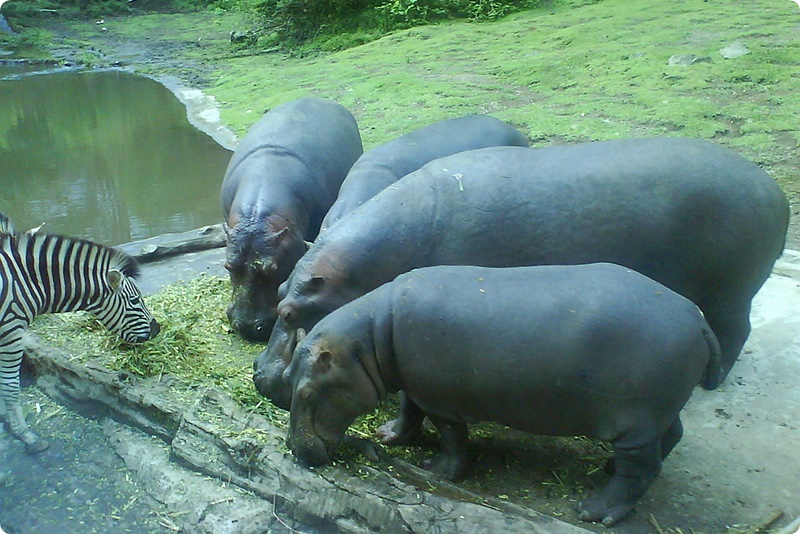
Hippopotamuses (Hippopotamus amphibius) and Plains Zebra (Equus quagga)
Taman Safari Indonesia, Bogor, Indonesia
Photo © Eka Priatna
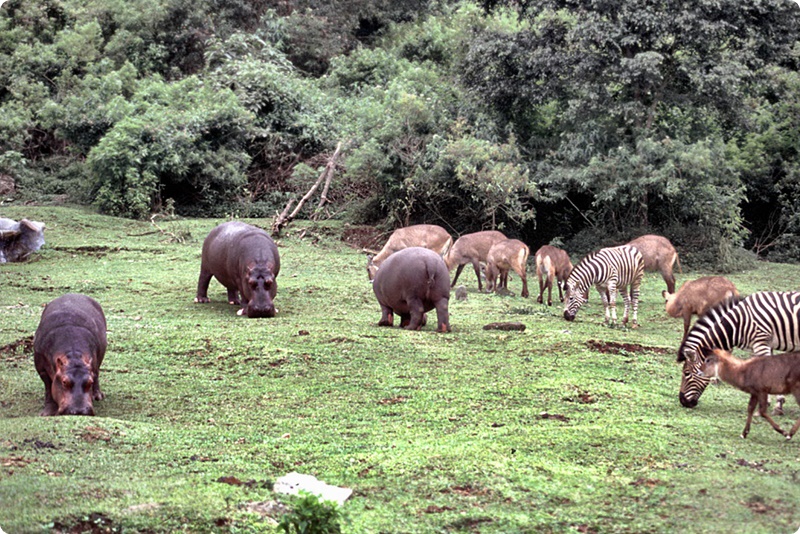
Hippopotamuses (Hippopotamus amphibius), Plains Zebras (Equus quagga) and Defassa Waterbucks (Kobus ellipsiprymnus defassa)
Taman Safari Indonesia, Bogor, Indonesia
Photo © Dr. Peter Dollinger
Combined species:
- Hippopotamus, Hippopotamus amphibius
- Grant’s Zebra, Equus quagga boehmi
- Ostrich, Struthio camelus
Institution(s): Zoo Basel (Basel, Switzerland)
Combined species:
- Hippopotamus, Hippopotamus amphibius
- Southern White Rhinoceros, Ceratotherium simum simum
- Nyala, Tragelaphus angasii
- Egyptian Goose, Alopochen aegyptiaca
Institution(s): Parco Natura Viva (Bussolengo, Italy)
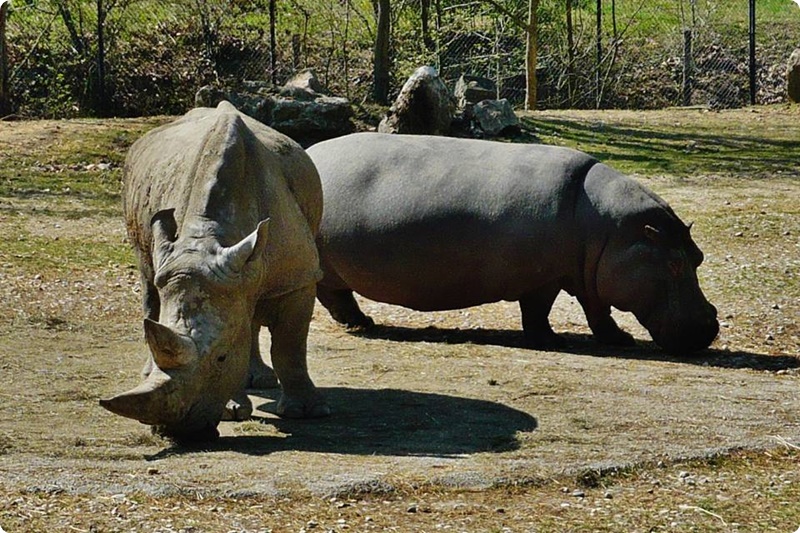
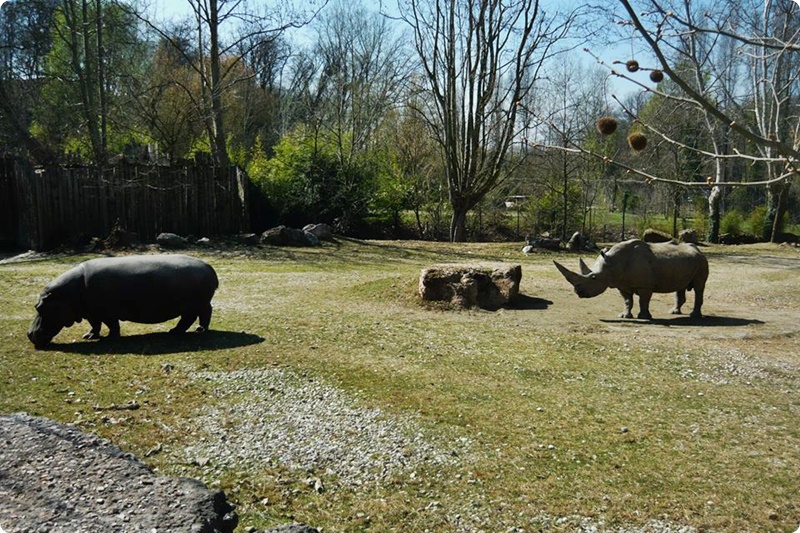
Hippopotamus (Hippopotamus amphibius) and Southern White Rhinoceros (Ceratotherium simum simum)
Parco Natura Viva, Bussolengo, Italy
Photos © Stefano Capomagi
Combined species:
- Hippopotamus, Hippopotamus amphibius
- Southern Warthog, Phacochoerus africanus sundevallii
- Chital, Axis axis
- Hog Deer, Axis porcinus
- Southern Bushbuck, Tragelaphus scriptus sylvaticus
- Red Lechwe, Kobus leche leche
- Common Impala, Aepyceros melampus
- Scimitar-horned Oryx, Oryx dammah
Institution(s): Bothongo Rhino & Lion Nature Reserve (Krugersdorp, South Africa)
Combined species:
- Hippopotamus, Hippopotamus amphibius
- Red River Hog, Potamochoerus porcus
Institution(s): Zoo du Bassin d'Arcachon (La Teste-de-Buch, France)
Combined species:
- Hippopotamus, Hippopotamus amphibius
- Pygmy Hippopotamus, Choeropsis liberiensis
unknown institution
Combined species:
- Hippopotamus, Hippopotamus amphibius
- Central European Red Deer, Cervus elaphus hippelaphus
- other ungulates
Institution(s): Safari Ravenna (Ravenna, Italy)
Combined species:
- Hippopotamus, Hippopotamus amphibius
- Nyala, Tragelaphus angasii
- Waterbuck, Kobus ellipsiprymnus ellipsiprymnus
- Common Impala, Aepyceros melampus melampus
- Pink-backed Pelican, Pelecanus rufescens
- Ruddy Shelduck, Tadorna ferruginea
- Egyptian Goose, Alopochen aegyptiaca
- Mallard, Anas platyrhynchos
- Helmeted Guineafowl, Numida meleagris
Institution(s): ZOO Dvůr Králové (Dvůr Králové nad Labem, Czech Republic)
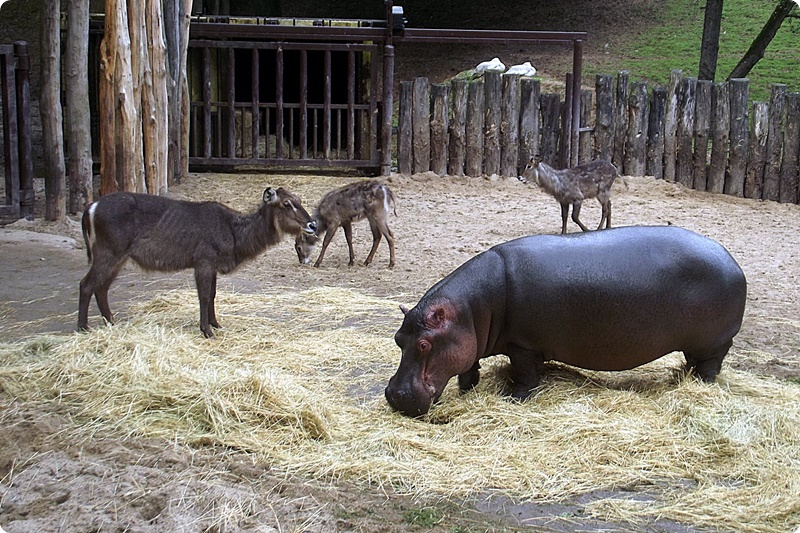
Hippopotamus (Hippopotamus amphibius) and Waterbucks (Kobus ellipsiprymnus ellipsiprymnus)
ZOO Dvůr Králové, Dvůr Králové nad Labem, Czech Republic
Photo © Antal Nagy
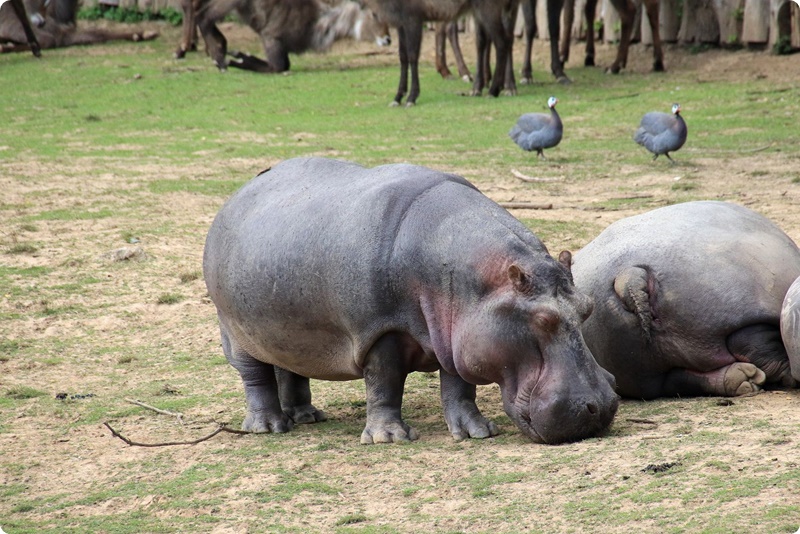
Hippopotamuses (Hippopotamus amphibius), Waterbucks (Kobus ellipsiprymnus ellipsiprymnus) and Helmeted Guineafowls (Numida meleagris)
ZOO Dvůr Králové, Dvůr Králové nad Labem, Czech Republic
Photo © Jiří Hladík
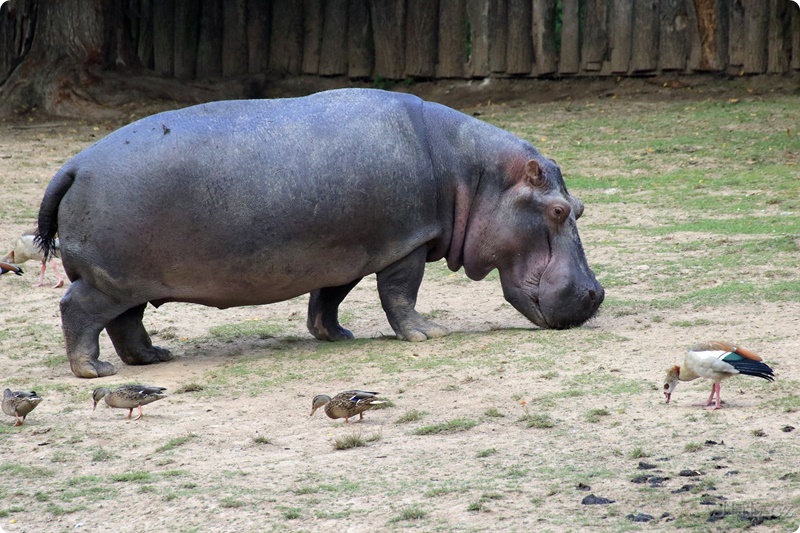
Hippopotamuses (Hippopotamus amphibius), Egyptian Geese (Alopochen aegyptiaca) and Mallards (Anas platyrhynchos)
ZOO Dvůr Králové, Dvůr Králové nad Labem, Czech Republic
Photo © Jiří Hladík
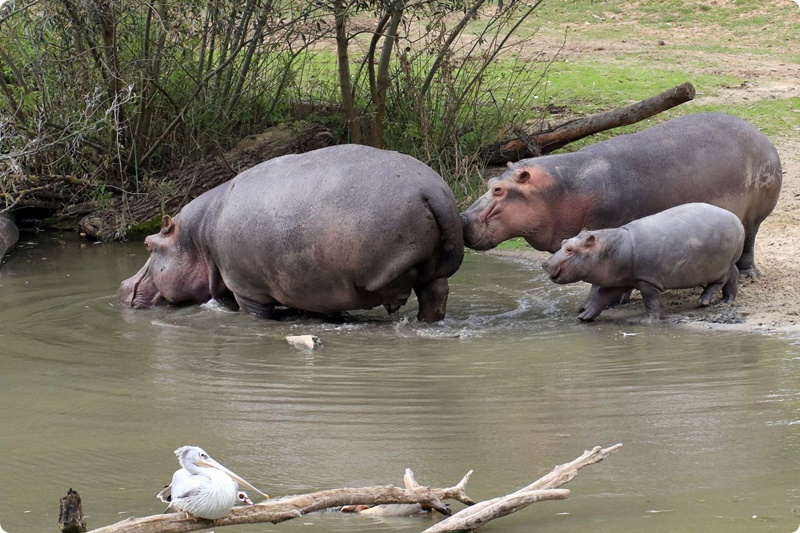
Hippopotamuses (Hippopotamus amphibius) and Pink-backed Pelican (Pelecanus rufescens)
ZOO Dvůr Králové, Dvůr Králové nad Labem, Czech Republic
Photo © Jiří Hladík
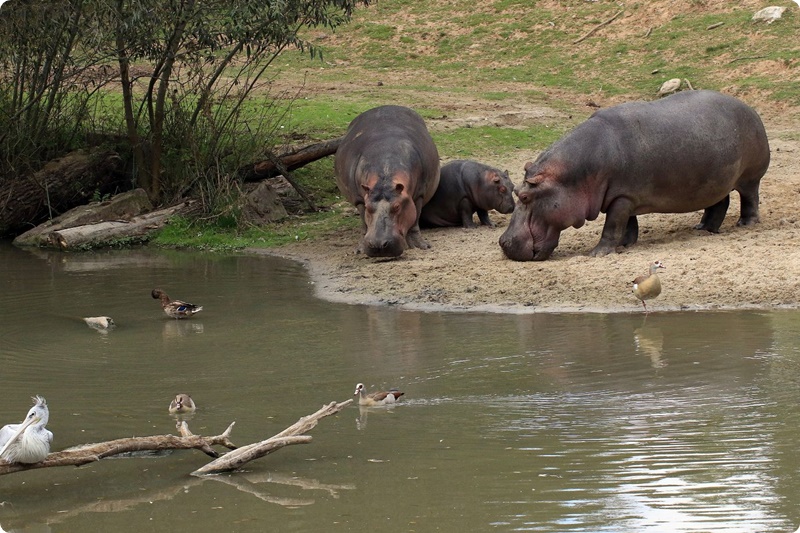
Hippopotamuses (Hippopotamus amphibius), Pink-backed Pelican (Pelecanus rufescens), Egyptian Geese (Alopochen aegyptiaca) and Mallards (Anas platyrhynchos)
ZOO Dvůr Králové, Dvůr Králové nad Labem, Czech Republic
Photo © Jiří Hladík
Combined species:
- Hippopotamus, Hippopotamus amphibius
- Nyala, Tragelaphus angasii
- Egyptian Goose, Alopochen aegyptiaca
- other birds, i.e. Mallard, Anas platyrhynchos and Southern Pochard, Netta erythrophthalma
- fish, i.e. Grass Carp, Ctenopharyngodon idella
Institution(s): Zoologischer Garten Berlin (Berlin, Germany)
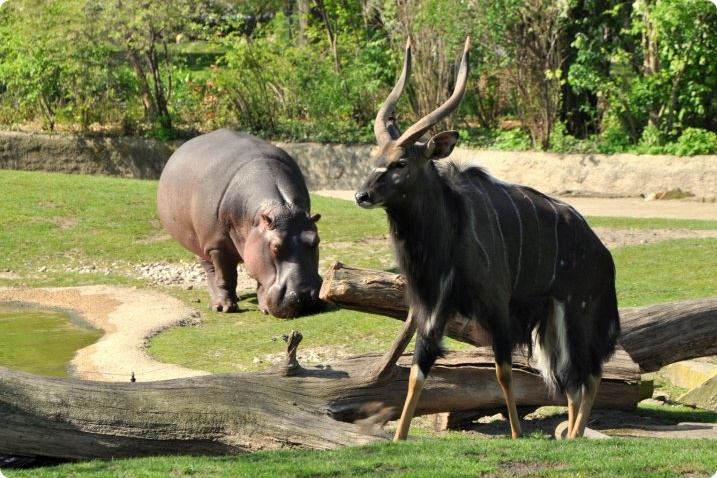
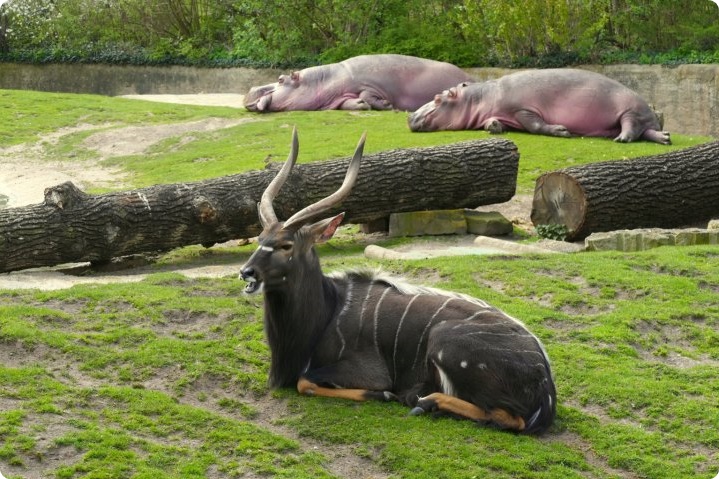
Hippopotamuses (Hippopotamus amphibius) and Nyala (Tragelaphus angasii)
Zoologischer Garten Berlin, Berlin, Germany
Photos © Klaus Rudloff
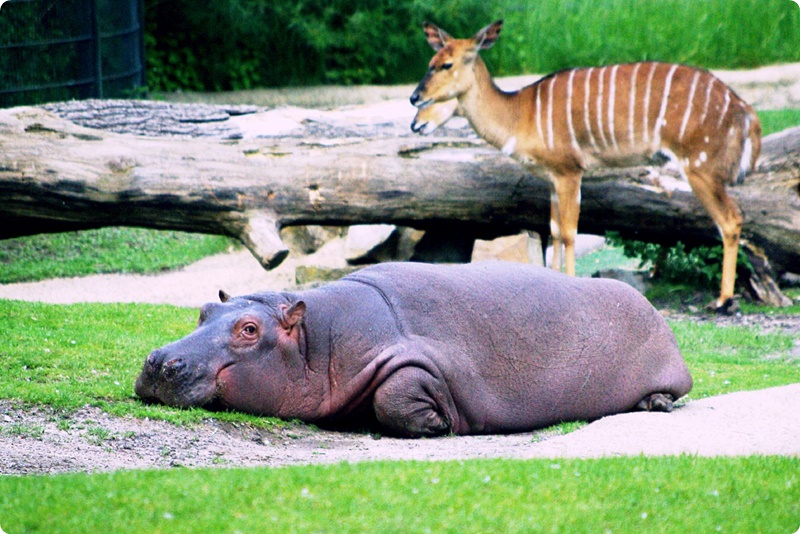
Hippopotamus (Hippopotamus amphibius) and Nyalas (Tragelaphus angasii)
Zoologischer Garten Berlin, Berlin, Germany
Photo © David Robert
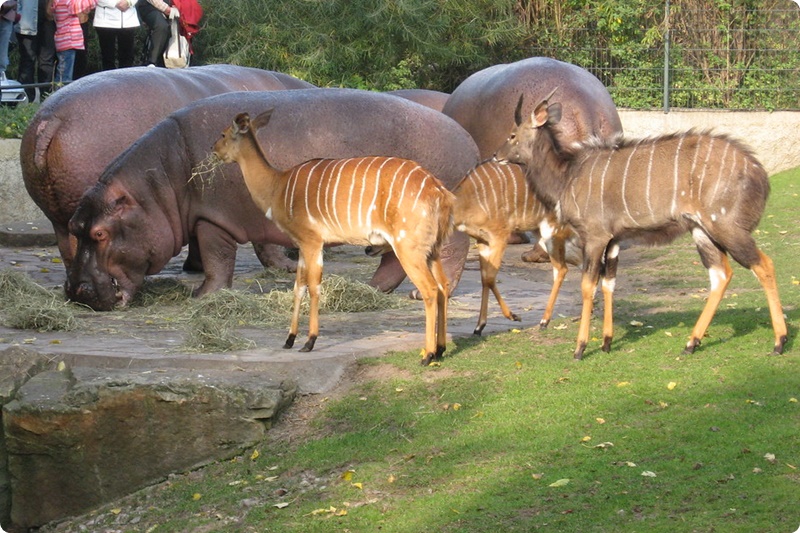
Hippopotamuses (Hippopotamus amphibius) and Nyalas (Tragelaphus angasii)
Zoologischer Garten Berlin, Berlin, Germany
Photo © Magnus Niemann
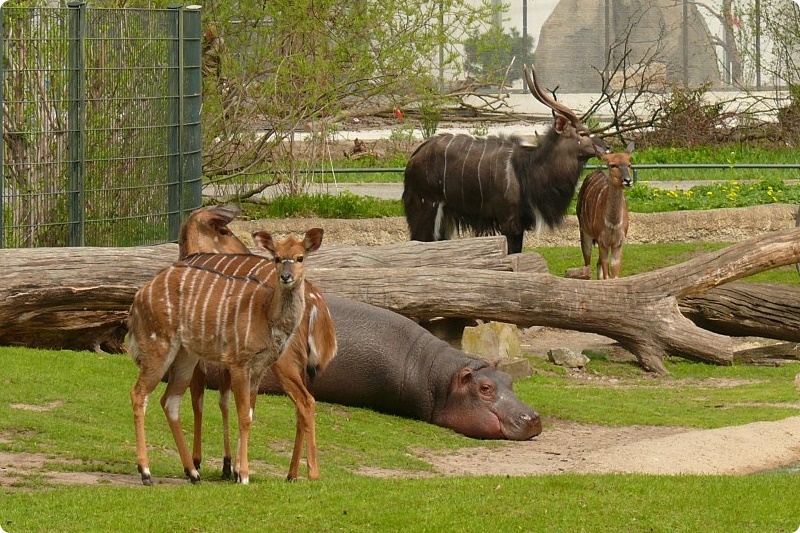
Hippopotamus (Hippopotamus amphibius) and Nyalas (Tragelaphus angasii)
Zoologischer Garten Berlin, Berlin, Germany
Photo © Christina Meier
Hippopotamuses (Hippopotamus amphibius) and Nyalas (Tragelaphus angasii)
Zoologischer Garten Berlin, Berlin, Germany
Photo © David Evans
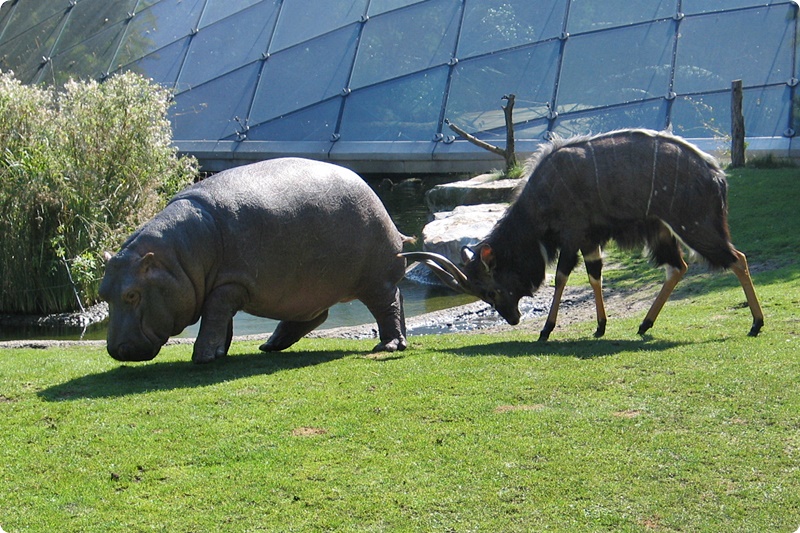
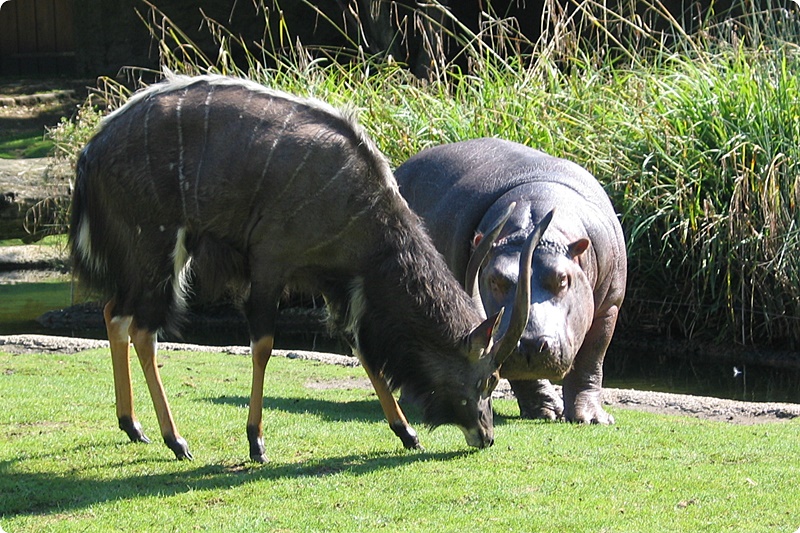
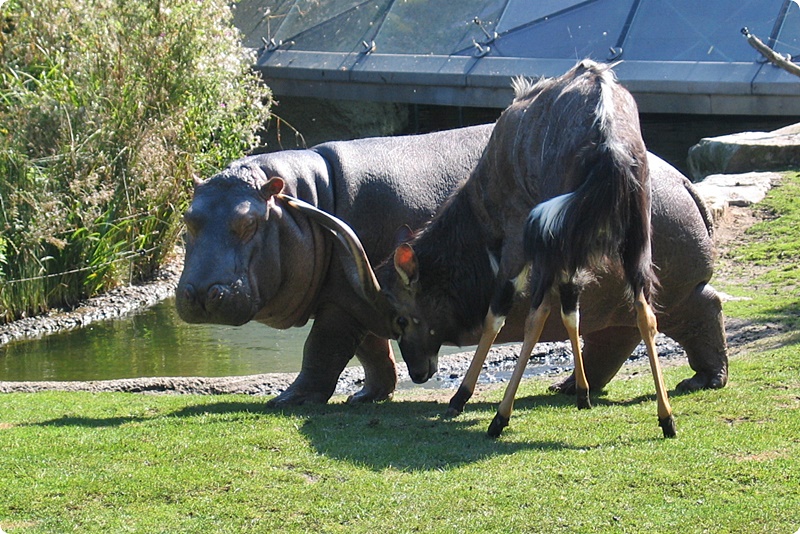
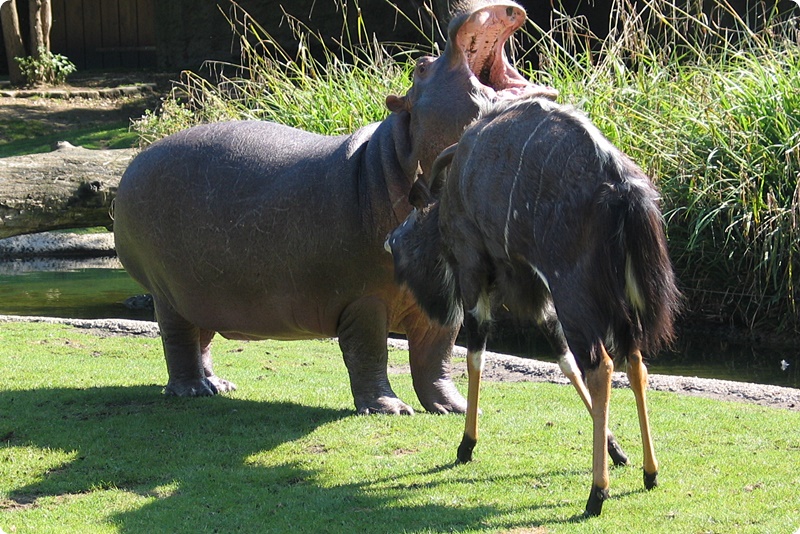
Interaction between young Hippopotamus (Hippopotamus amphibius) and Nyala bull (Tragelaphus angasii)
Zoologischer Garten Berlin, Berlin, Germany
Photos © Dr. Leszek Solski
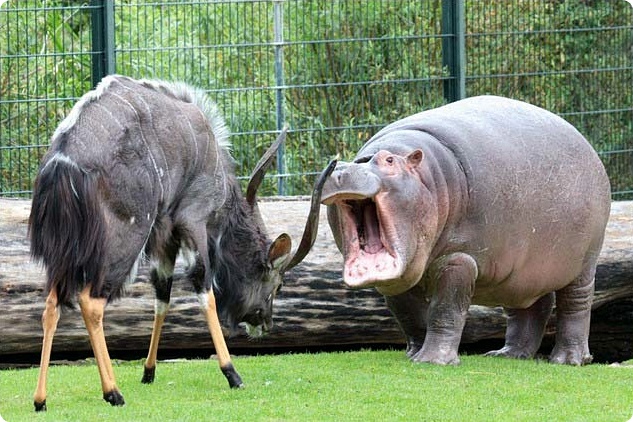
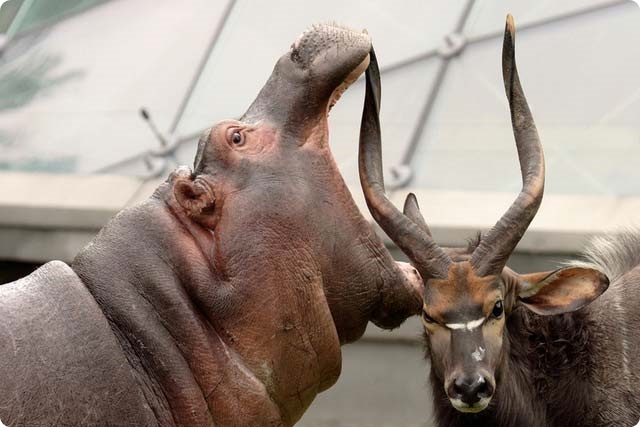
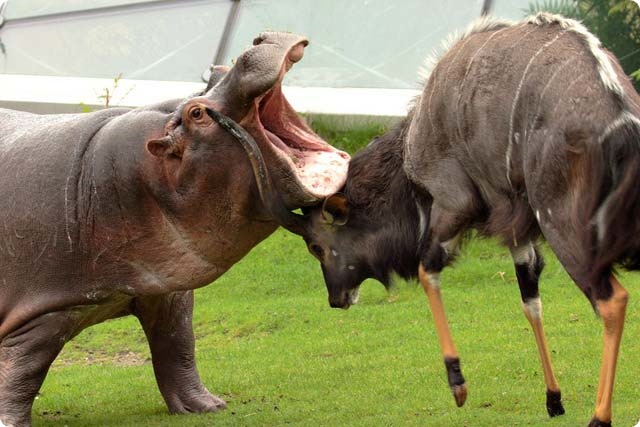
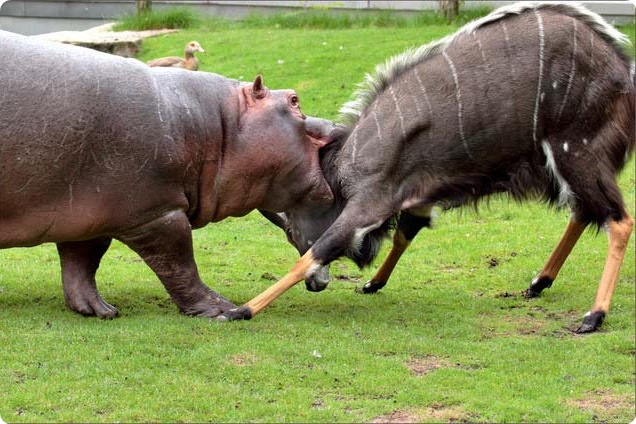
Interaction between young Hippopotamus (Hippopotamus amphibius) and Nyala bull (Tragelaphus angasii)
Zoologischer Garten Berlin, Berlin, Germany
Photos © Ulrich Brodde
Hippopotamus (Hippopotamus amphibius) and Nyala (Tragelaphus angasii) mixed exhibit
Zoologischer Garten Berlin, Berlin, Germany
Photo © William Bezodis
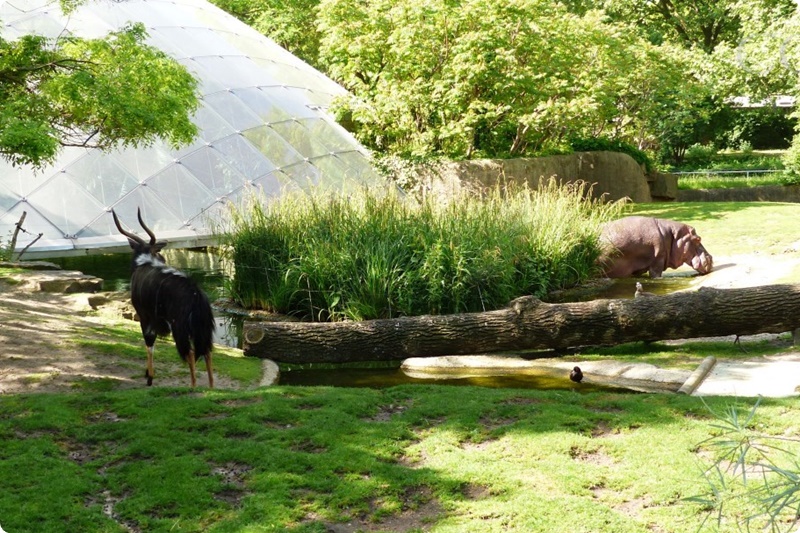
Hippopotamus (Hippopotamus amphibius) and Nyala (Tragelaphus angasii) mixed exhibit
Zoologischer Garten Berlin, Berlin, Germany
Photo © Christina Meier
Hippopotamus (Hippopotamus amphibius) and Nyala (Tragelaphus angasii) mixed exhibit
Zoologischer Garten Berlin, Berlin, Germany
Photo © Alex Kantorovich
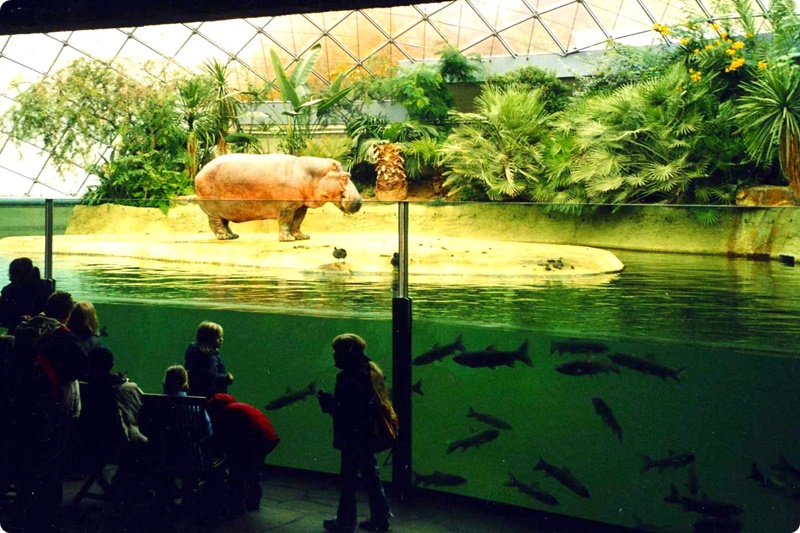
Hippopotamus (Hippopotamus amphibius), bird and fish indoor mixed-species exhibit
Zoologischer Garten Berlin, Berlin, Germany
Photo © Wikimedia Commons
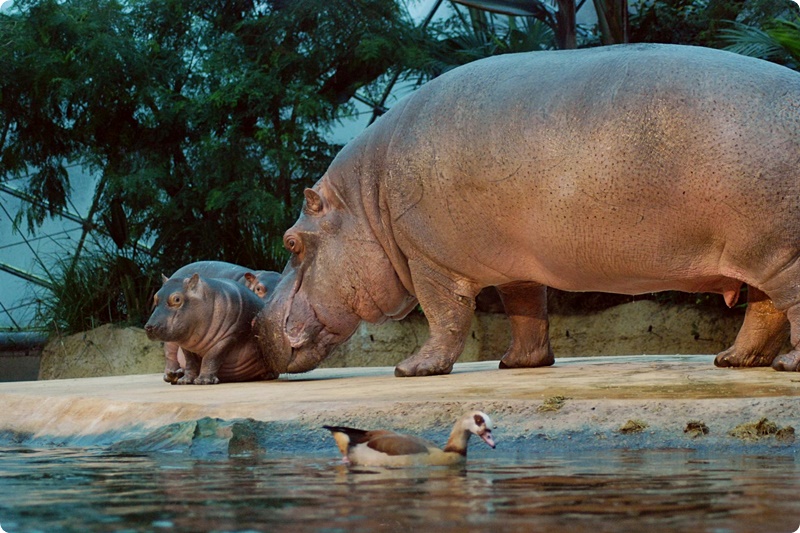
Hippopotamuses (Hippopotamus amphibius) and Egyptian Goose (Alopochen aegyptiaca)
Zoologischer Garten Berlin, Berlin, Germany
Photo © Ulli Joerres
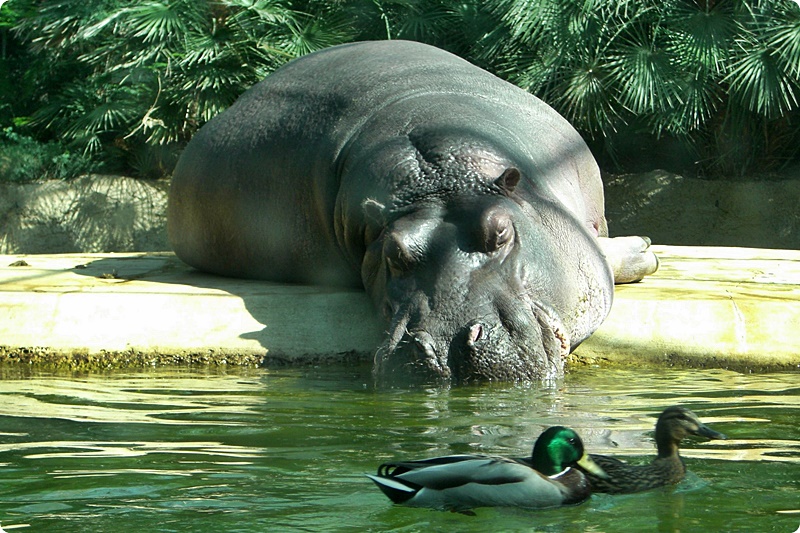
Hippopotamus (Hippopotamus amphibius) and Mallards (Anas platyrhynchos)
Zoologischer Garten Berlin, Berlin, Germany
Photo © Dan Reynolds
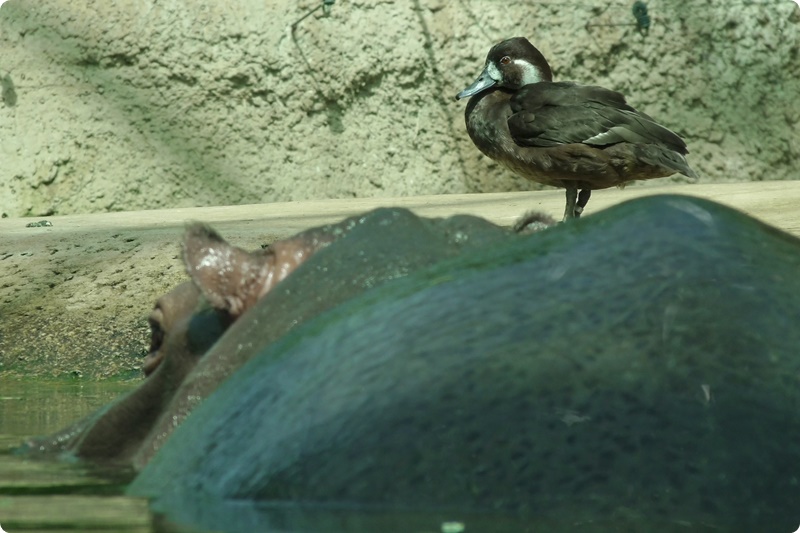
Hippopotamus (Hippopotamus amphibius) and Southern Pochard (Netta erythrophthalma)
Zoologischer Garten Berlin, Berlin, Germany
Photo © Judith Richmann
Combined species:
- Hippopotamus, Hippopotamus amphibius
- Bushbuck, Tragelaphus scriptus
- Aldabra Giant Tortoise, Aldabrachelys gigantea
Institution(s): Haller Park (Mombasa, Kenya)
Combined species:
- Hippopotamus, Hippopotamus amphibius
- Western Sitatunga, Tragelaphus spekii gratus
- Nile Lechwe, Kobus megaceros
- Marabou, Leptoptilos crumenifer
Institution(s): Safaripark Beekse Bergen (Hivarenbeek, the Netherlands)
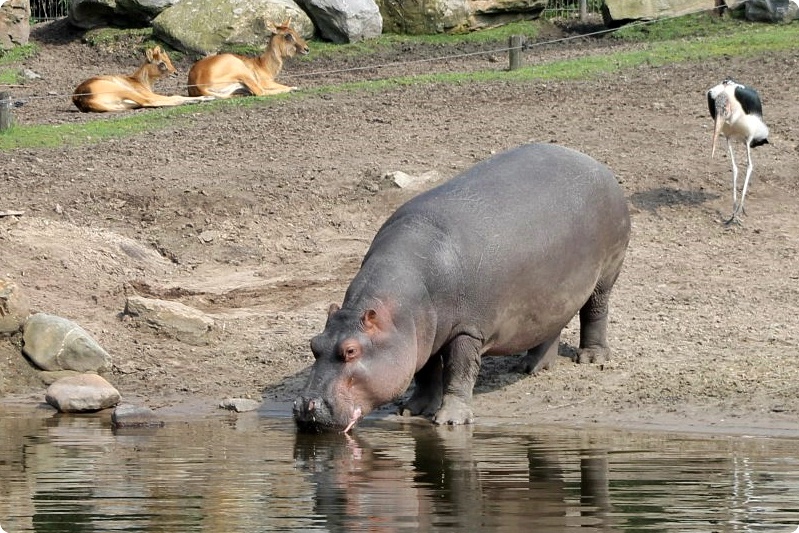
Hippopotamus (Hippopotamus amphibius), Nile Lechwes (Kobus megaceros) and Marabou (Leptoptilos crumenifer)
Safaripark Beekse Bergen, Hivarenbeek, the Netherlands
Photo © Maarten de Ruiter
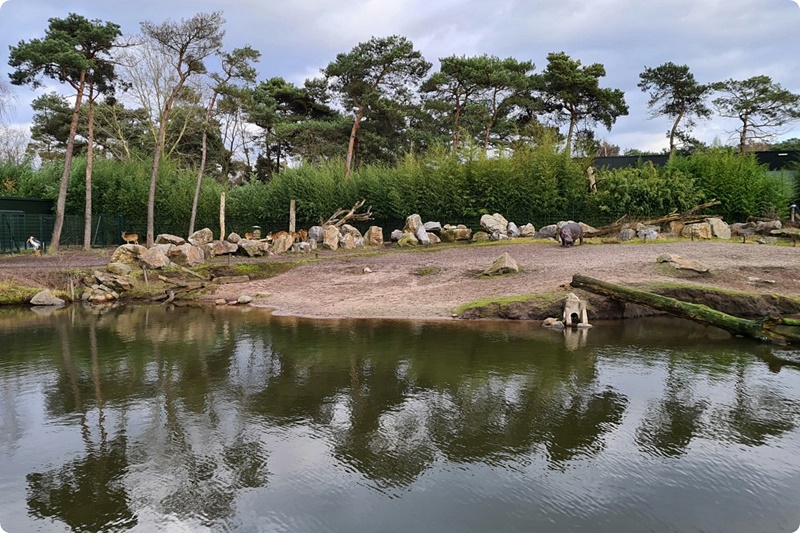
Hippopotamus (Hippopotamus amphibius) in a mixed-species exhibit
Safaripark Beekse Bergen, Hivarenbeek, the Netherlands
Photo © Ties Kooistra
Combined species:
- Hippopotamus, Hippopotamus amphibius
- Western Sitatunga, Tragelaphus spekii gratus
- Saddle-billed Stork, Ephippiorhynchus senegalensis
Institution(s): ZOOM Erlebniswelt Gelsenkirchen (Gelsenkirchen, Germany)
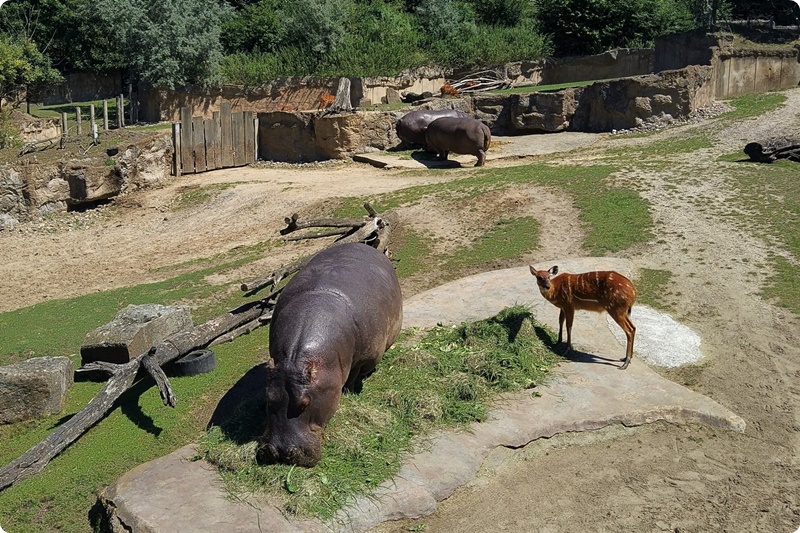
Hippopotamuses (Hippopotamus amphibius) and Western Sitatunga (Tragelaphus spekii gratus)
ZOOM Erlebniswelt Gelsenkirchen, Gelsenkirchen, Germany
Photo © Joshua Wilkes
Combined species:
- Hippopotamus, Hippopotamus amphibius
- Greater Kudu, Tragelaphus strepsiceros
- Sable Antelope, Hippotragus niger niger
Institution(s): Zoo du Bassin d'Arcachon (La Teste-de-Buch, France)
Combined species:
- Hippopotamus, Hippopotamus amphibius
- Ostrich, Struthio camelus
Institution(s): Zoo du Bassin d'Arcachon (La Teste-de-Buch, France)
Combined species:
- Hippopotamus, Hippopotamus amphibius
- Dalmatian Pelican, Pelecanus crispus
- Great Cormorant, Phalacrocorax carbo
Institution(s): ZOO Antwerpen (Antwerp, Belgium)
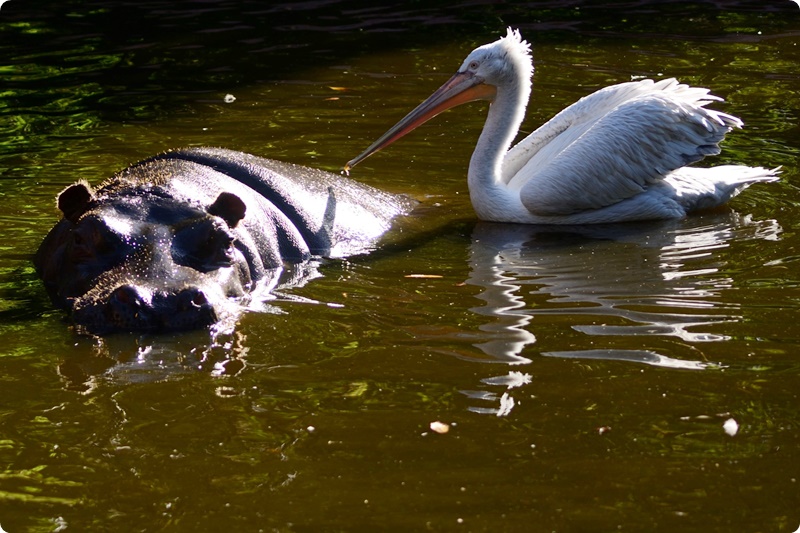
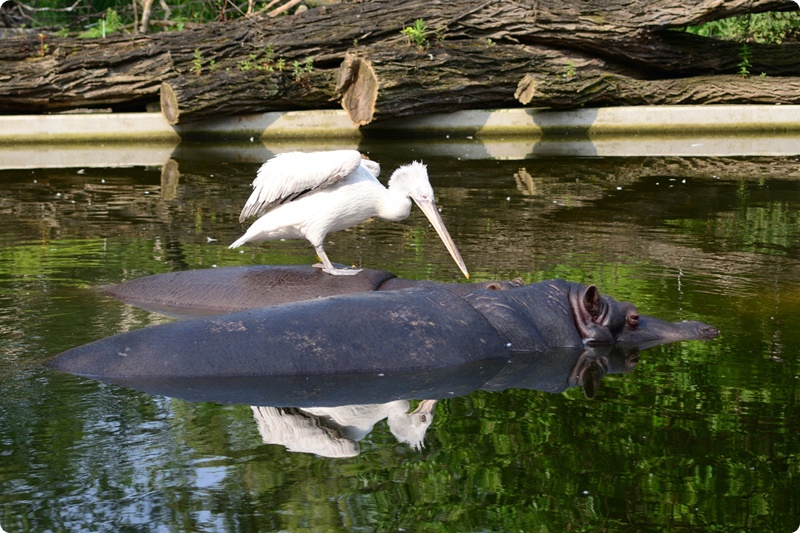
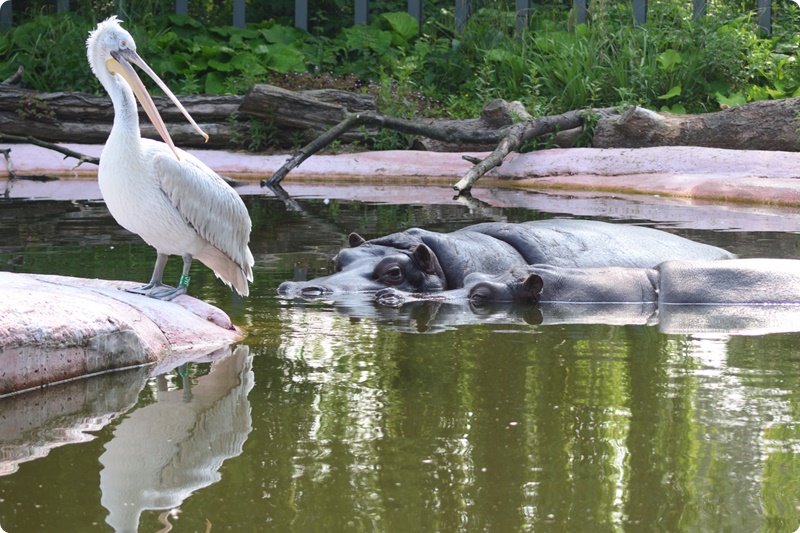
Hippopotamuses (Hippopotamus amphibius) and Dalmatian Pelican (Pelecanus crispus)
ZOO Antwerpen, Antwerp, Belgium
Photos © Tom van Deuren
Combined species:
- Hippopotamus, Hippopotamus amphibius
- Great White Pelican, Pelecanus onocrotalus
Institution(s): Le PAL - Parc d’Attractions et Animalier (Saint-Pourçain-sur-Besbre, France)
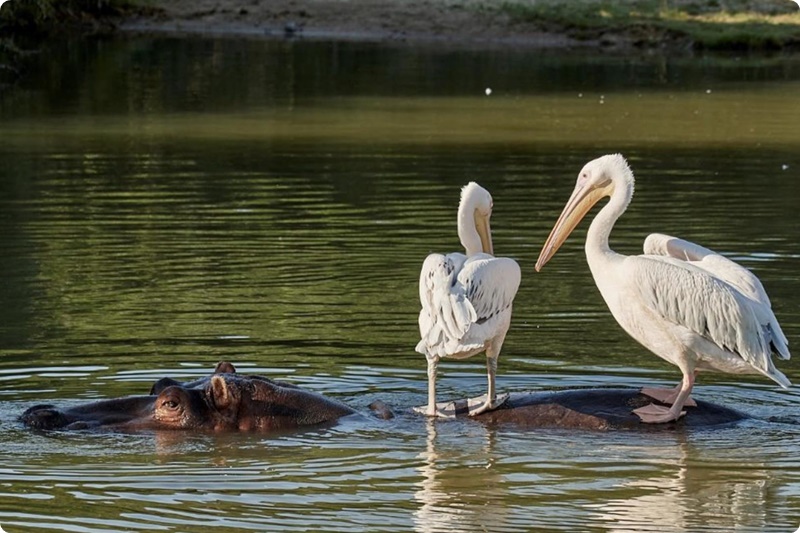
Hippopotamus (Hippopotamus amphibius) and Great White Pelicans (Pelecanus onocrotalus)
Le PAL - Parc d’Attractions et Animalier, Saint-Pourçain-sur-Besbre, France
Photo © Nicolas Géli
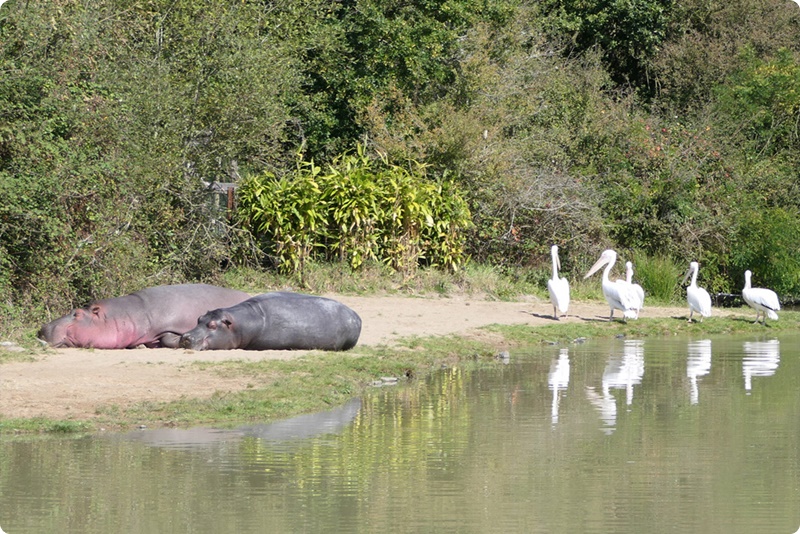
Hippopotamuses (Hippopotamus amphibius) and Great White Pelicans (Pelecanus onocrotalus)
Le PAL - Parc d’Attractions et Animalier, Saint-Pourçain-sur-Besbre, France
Photo © Dr. Peter Dollinger
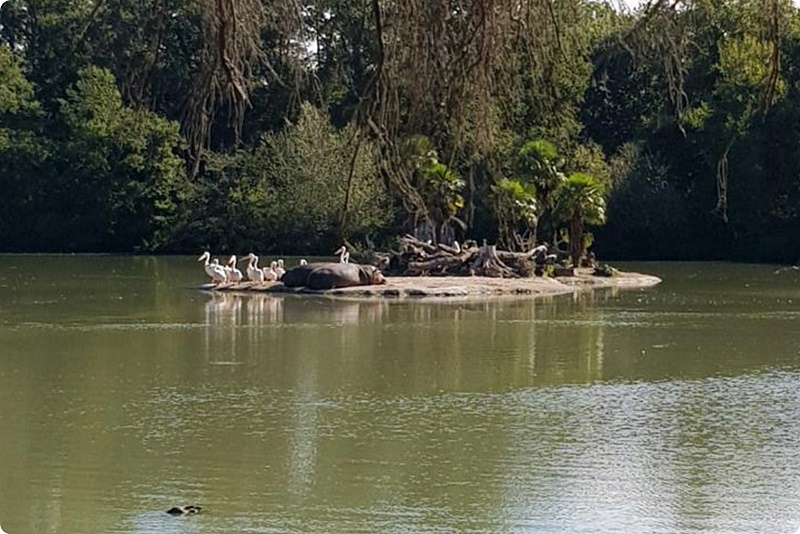
Hippopotamus (Hippopotamus amphibius) and Great White Pelican (Pelecanus onocrotalus) mixed exhibit
Le PAL - Parc d’Attractions et Animalier, Saint-Pourçain-sur-Besbre, France
Photo © Nicolas Géli
Combined species:
- Hippopotamus, Hippopotamus amphibius
- Pink-backed Pelican, Pelecanus rufescens
- White-breasted Cormorant, Phalacrocorax lucidus
- Great White Egret, Ardea alba
- White Ibis, Eudocimus albus
- White-faced Whistling-duck, Dendrocygna viduata
- Egyptian Goose, Alopochen aegyptiaca
- Northern Pintail, Anas acuta
- Yellow-billed Duck, Anas undulata
- American Black Vulture, Coragyps atratus
Institution(s): Disney's Animal Kingdom Theme Park (Bay Lake, Florida, United States of America)
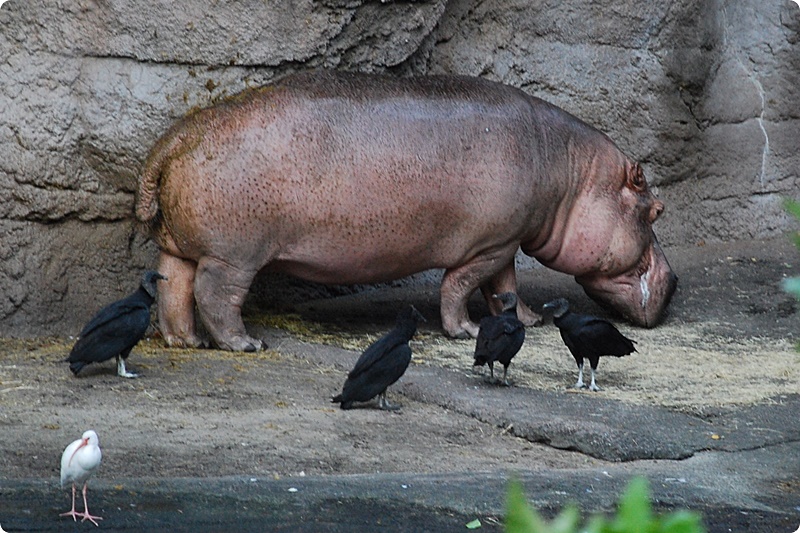
Hippopotamus (Hippopotamus amphibius), White Ibis (Eudocimus albus) and American Black Vultures (Coragyps atratus)
Kilimanjaro Safaris, Disney's Animal Kingdom Theme Park, Bay Lake, Florida, United States of America
Photo © Adam Fagen
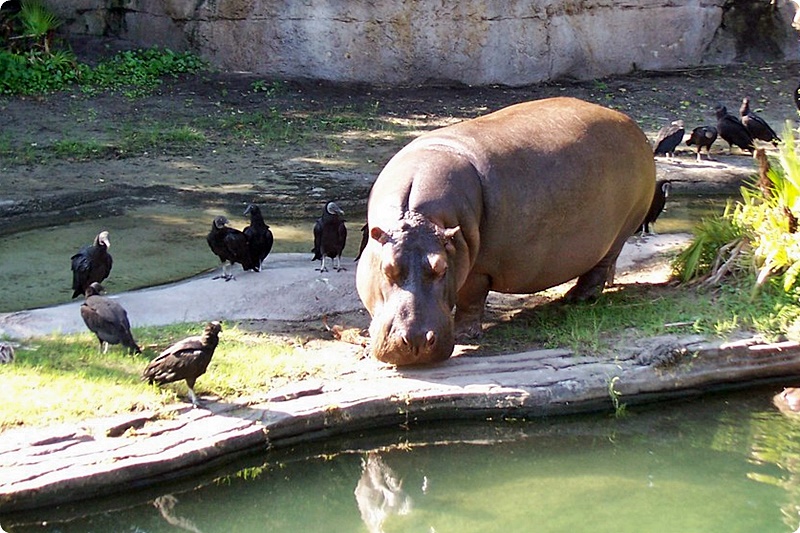
Hippopotamus (Hippopotamus amphibius) and American Black Vultures (Coragyps atratus)
Kilimanjaro Safaris, Disney's Animal Kingdom Theme Park, Bay Lake, Florida, United States of America
Photo © Jeremiah Good
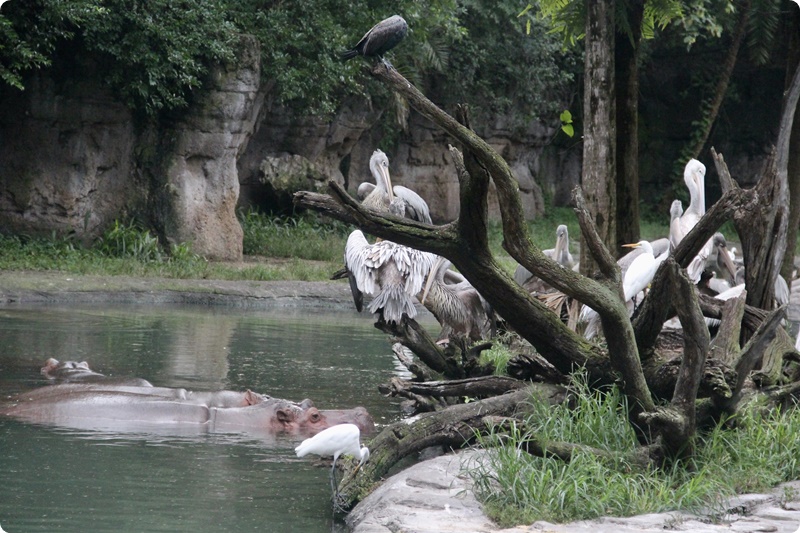
Hippopotamuses (Hippopotamus amphibius), Pink-backed Pelicans (Pelecanus rufescens) and Great White Egrets (Ardea alba)
Kilimanjaro Safaris, Disney's Animal Kingdom Theme Park, Bay Lake, Florida, United States of America
Photo © Jerry Hendricks
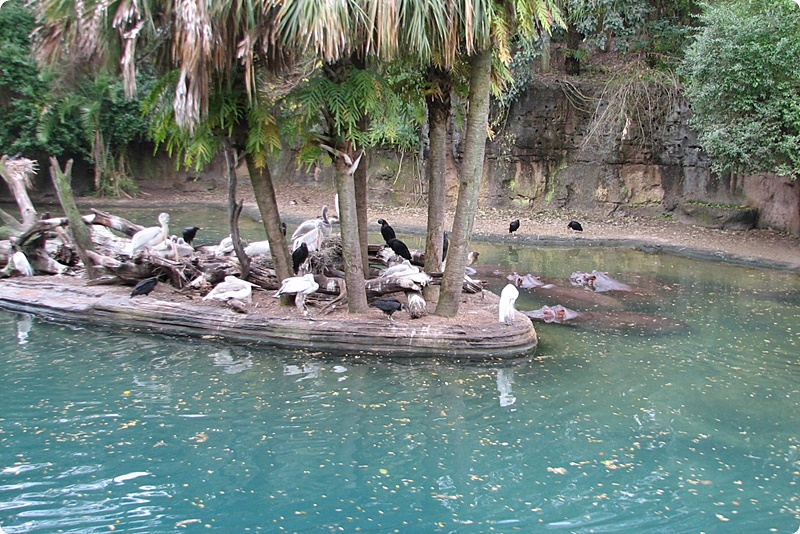
Hippopotamuses (Hippopotamus amphibius) in a mixed-species exhibit
Kilimanjaro Safaris, Disney's Animal Kingdom Theme Park, Bay Lake, Florida, United States of America
Photo © David Freely

Hippopotamuses (Hippopotamus amphibius) in a mixed-species exhibit
Kilimanjaro Safaris, Disney's Animal Kingdom Theme Park, Bay Lake, Florida, United States of America
Photo © Scott Thomas
Combined species:
- Hippopotamus, Hippopotamus amphibius
- Pink-backed Pelican, Pelecanus rufescens
- Hamerkop, Scopus umbretta
- Abdim’s Stork, Ciconia abdimii
- Yellow-billed Stork, Mycteria ibis
- African Openbill, Anastomus lamelligerus
- African Spoonbill, Platalea alba
- Hadada Ibis, Bostrychia hagedash
- Southern Bald Ibis, Geronticus calvus
- African Sacred Ibis, Threskiornis aethiopicus
- African Comb Duck, Sarkidiornis melanotos
- Blue-winged Goose, Cyanochen cyanoptera
- Cape Teal, Anas capensis
- White-headed Duck, Oxyura leucocephala
- Palm-nut Vulture, Gypohierax angolensis
- Hooded Vulture, Necrosyrtes monachus
- White-headed Vulture, Trigonoceps occipitalis
- South African Grey Crowned-crane, Balearica regulorum regulorum
- fish, e.g. Common Carp, Cyprinus carpio, Grass Carp, Ctenopharyngodon idella, Northern Pike, Esox lucius
Institution(s): ZooParc de Beauval (Saint-Aignan, France)
Hippopotamuses (Hippopotamus amphibius), Pink-backed Pelicans (Pelecanus rufescens) and Yellow-billed Storks (Mycteria ibis)
ZooParc de Beauval, Saint-Aignan, France
Photo © Ben Gilbert
Hippopotamuses (Hippopotamus amphibius) in a mixed-species exhibit
ZooParc de Beauval, Saint-Aignan, France
Photos © Ben Gilbert
Hippopotamuses (Hippopotamus amphibius), Common Carps (Cyprinus carpio) and Grass Carps (Ctenopharyngodon idella)
ZooParc de Beauval, Saint-Aignan, France
Photo © Theo Linders
Combined species:
- Hippopotamus, Hippopotamus amphibius
- Goliath Heron, Ardea goliath
Institution(s): Cleveland Metroparks Zoo (Cleveland, Ohio, United States of America)
Combined species:
- Hippopotamus, Hippopotamus amphibius
- Cattle Egret, Bubulcus ibis
- Hamerkop, Scopus umbretta
- White-faced Whistling-duck, Dendrocygna viduata
- Red-billed Teal, Anas erythrorhyncha
- Marbled Teal, Marmaronetta angustirostris
- Brown-faced Go-away-bird, Corythaixoides personatus
- Village Weaver, Ploceus cucullatus
- fish
Institution(s): ZOO Wrocław (Wrocław, Poland)
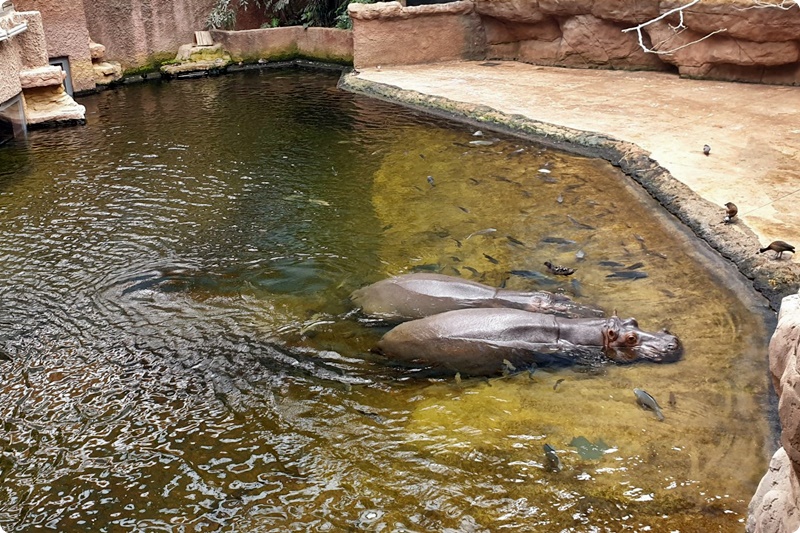
Hippopotamus (Hippopotamus amphibius), bird and fish indoor mixed-species exhibit
ZOO Wrocław, Wrocław, Poland
Photo © Konstantin Yordanov
Hippopotamus (Hippopotamus amphibius), bird and fish indoor mixed-species exhibit
ZOO Wrocław, Wrocław, Poland
Photo © Krisztián Svábik
Combined species:
- Hippopotamus, Hippopotamus amphibius
- Cattle Egret, Bubulcus ibis
- Red-billed Oxpecker, Buphagus erythrorynchus
Institution(s): Zoo Zürich (Zürich, Switzerland)
Combined species:
- Hippopotamus, Hippopotamus amphibius
- Hamerkop, Scopus umbretta
Institution(s): København Zoo (Copenhagen, Denmark)
Combined species:
- Hippopotamus, Hippopotamus amphibius
- African Sacred Ibis, Threskiornis aethiopicus
Institution(s): Yekaterinburgskiy Zoopark (Yekaterinburg, Russia)
Hippopotamus (Hippopotamus amphibius) and African Sacred Ibis (Threskiornis aethiopicus) mixed exhibit
Yekaterinburgskiy Zoopark, Yekaterinburg, Russia
Photo © Alex Kantorovich
Combined species:
- Hippopotamus, Hippopotamus amphibius
- White-eyed Duck, Aythya australis
- Tufted Duck, Aythya fuligula
Institution(s): Disney's Animal Kingdom Theme Park (Bay Lake, Florida, United States of America)
Combined species:
- Hippopotamus, Hippopotamus amphibius
- Domestic Chicken, Gallus gallus f. domestica
Institution(s): Cheyenne Mountain Zoo (Colorado Springs, Colorado, United States of America)
Combined species:
- Hippopotamus, Hippopotamus amphibius
- African Cichlids, Cichlidae
Institution(s): Saint Louis Zoo (Saint Louis, Missouri, United States of America) (with Zebra Tilapia, Heterotilapia buettikoferi and Spotted Tilapia, Pelmatolapia mariae), San Antonio Zoo (San Antonio, Texas, United States of America) (with Lake Malawi Cichlids), Disney's Animal Kingdom Theme Park (Bay Lake, Florida, United States of America) (with Lake Victoria Cichlids), Cincinnati Zoo & Botanical Garden (Cincinnati, Ohio, United States of America) (with Nile Tilapia, Oreochromis niloticus), ZooTampa at Lowry Park (Tampa, Florida, United States of America), BREC's Baton Rouge Zoo (Baton Rouge, Louisiana, United States of America), Memphis Zoo (Memphis, Tennessee, United States of America), San Diego Zoo (San Diego, California, United States of America), Calgary Zoo (Calgary, Alberta, Canada) (with Tilapia), Zoom Torino (Cumiana, Italy) (with Lake Malawi Cichlids), Erlebnis-Zoo Hannover (Hanover, Germany), Bioparc Valéncia (Valencia, Spain) (with Lake Malawi Cichlids)
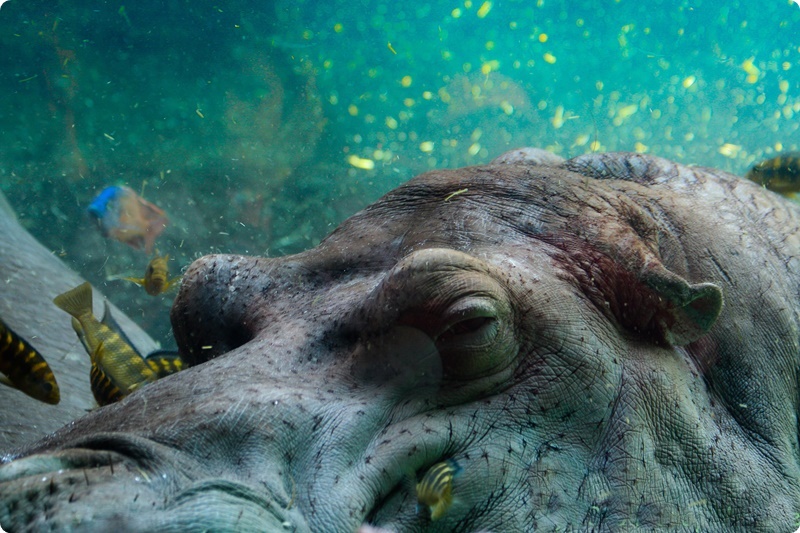
Hippopotamus (Hippopotamus amphibius) and Lake Malawi Cichlids (Cichlidae)
San Antonio Zoo, San Antonio, Texas, United States of America
Photo © Nancy Merolle
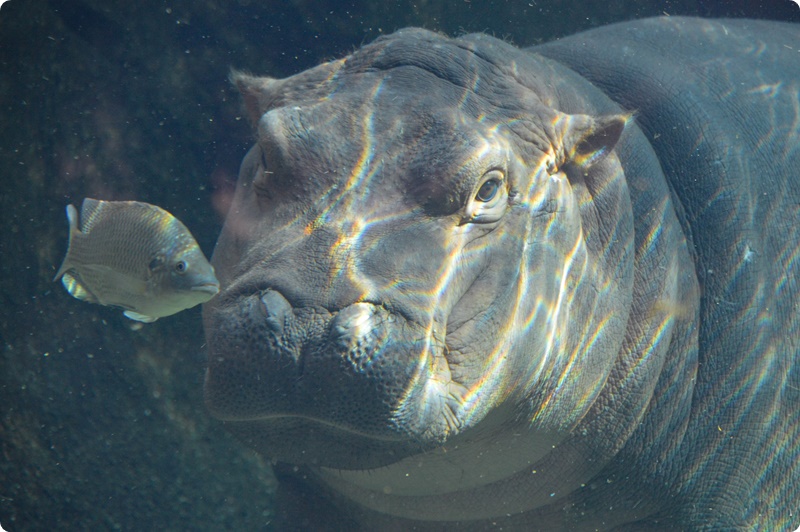
Hippopotamus (Hippopotamus amphibius) and Nile Tilapia (Oreochromis niloticus)
Cincinnati Zoo & Botanical Garden, Cincinnati, Ohio, United States of America
Photo © Lisa Hubbard
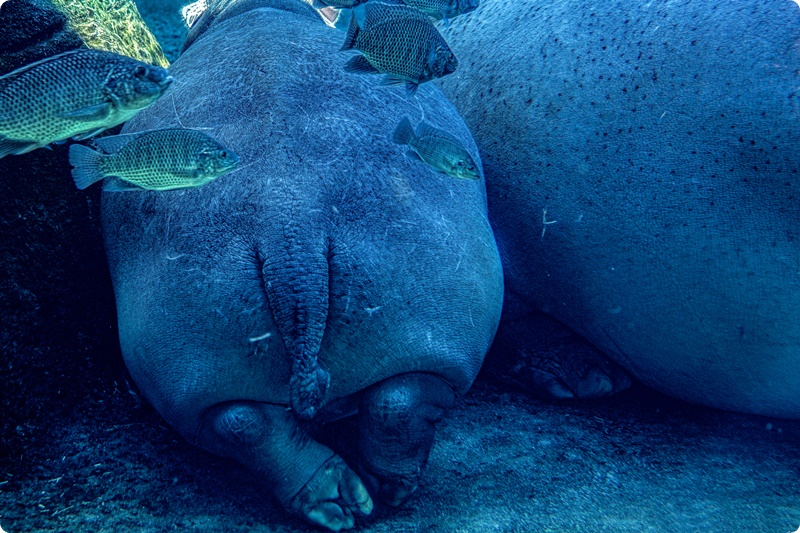
Hippopotamuses (Hippopotamus amphibius) and Nile Tilapias (Oreochromis niloticus)
Cincinnati Zoo & Botanical Garden, Cincinnati, Ohio, United States of America
Photo © Robert Streithorst
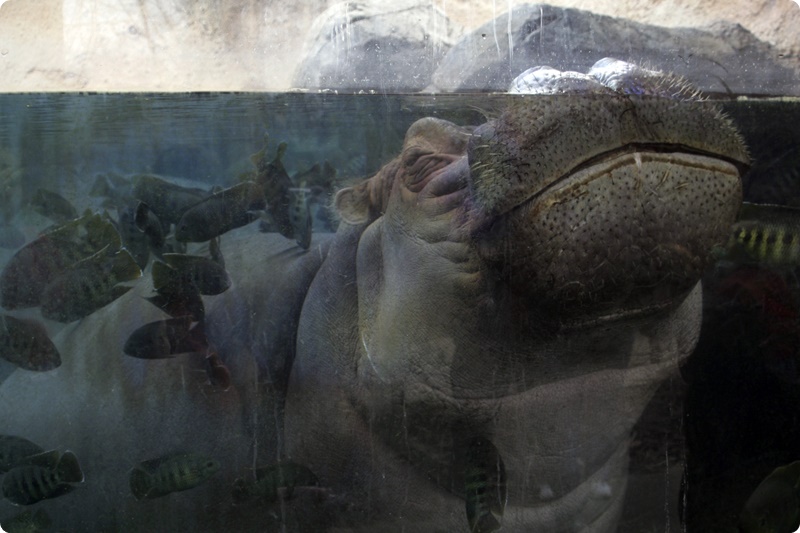
Hippopotamus (Hippopotamus amphibius), Zebra Tilapias (Heterotilapia buettikoferi) and Spotted Tilapias (Pelmatolapia mariae)
Saint Louis Zoo, Saint Louis, Missouri, United States of America
Photo © Kimberly Brown-Azzarello
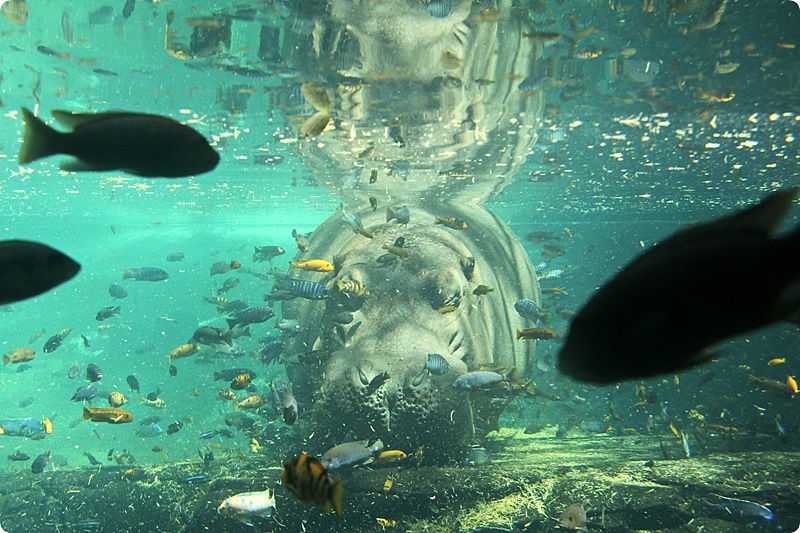
Hippopotamus (Hippopotamus amphibius) and Lake Victoria Cichlids (Cichlidae)
Pangani Forest Exploration Trail, Disney's Animal Kingdom Theme Park, Bay Lake, Florida, United States of America
Photo © Alain Secratan
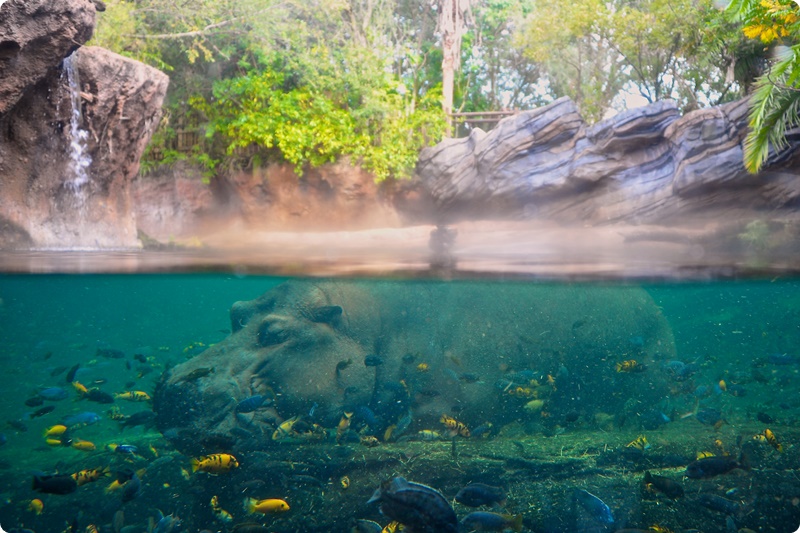
Hippopotamus (Hippopotamus amphibius) and Lake Victoria Cichlids (Cichlidae)
Pangani Forest Exploration Trail, Disney's Animal Kingdom Theme Park, Bay Lake, Florida, United States of America
Photo © Scott Thomas
Hippopotamus (Hippopotamus amphibius) and Lake Malawi Cichlids (Cichlidae)
Bioparc Valéncia, Valencia, Spain
Photo © Alan Torres Dwyer
Hippopotamus (Hippopotamus amphibius), Lake Malawi Cichlids (Cichlidae) and other fish
Bioparc Valéncia, Valencia, Spain
Photo © Alex Kantorovich
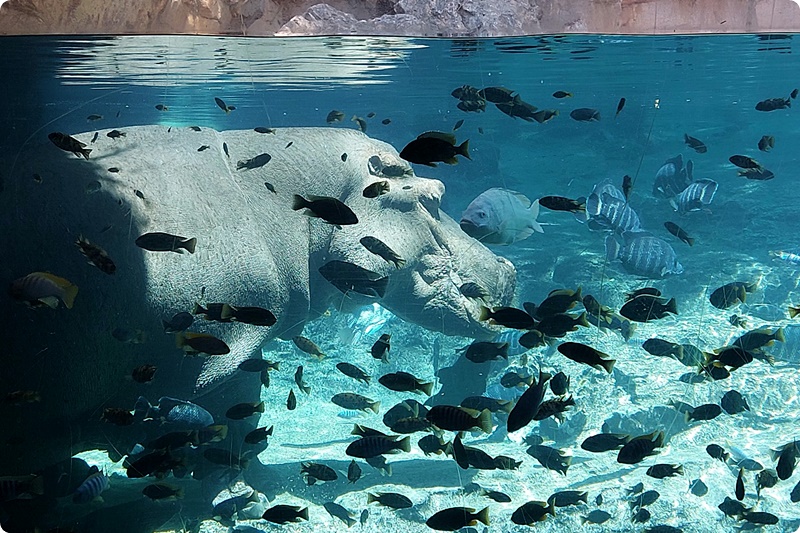
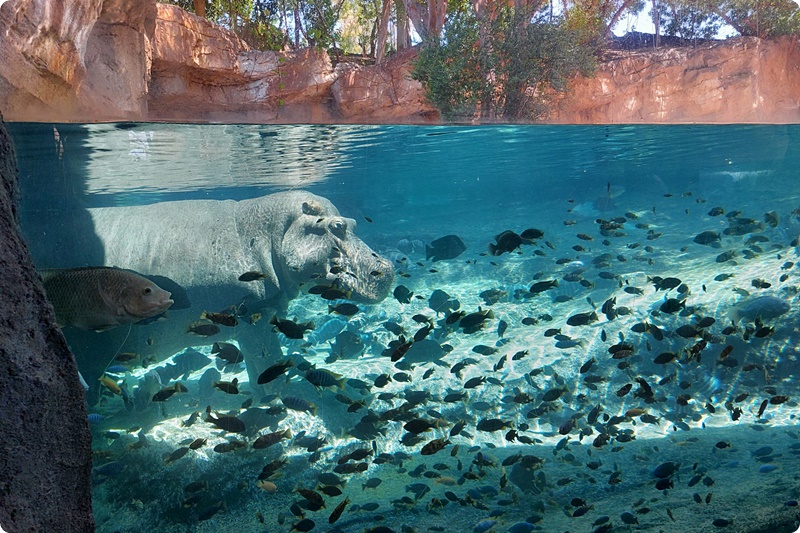
Hippopotamus (Hippopotamus amphibius) and Lake Malawi Cichlids (Cichlidae)
Bioparc Valéncia, Valencia, Spain
Photos © Davide Colaianni
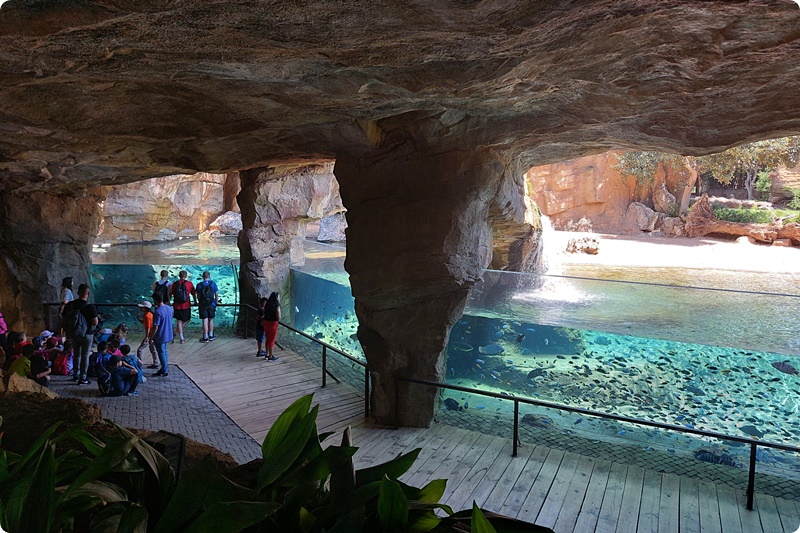
Hippopotamus (Hippopotamus amphibius) and Lake Malawi Cichlids (Cichlidae) mixed pool
Bioparc Valéncia, Valencia, Spain
Photo © Davide Colaianni
Combined species:
- Hippopotamus, Hippopotamus amphibius
- Common Carp, Cyprinus carpio
- Grass Carp, Ctenopharyngodon idella
Institution(s): WILDLANDS Adventure Zoo Emmen (Emmen, the Netherlands)
Combined species:
- Hippopotamus, Hippopotamus amphibius
- Grass Carp, Ctenopharyngodon idella
- other fish
Institution(s): Pairi Daiza (Brugelette, Belgium)
Combined species:
- Hippopotamus, Hippopotamus amphibius
- Black Pacu, Colossoma macropomum
- Green Swordtail, Xiphophorus hellerii
- Saltan Fish, Leptobarbus rubripinna
Institution(s): Zoo Warszawa (Warsaw, Poland)
 Pygmy Hippopotamus, Choeropsis liberiensis
Pygmy Hippopotamus, Choeropsis liberiensis
Combined species:
- Pygmy Hippopotamus, Choeropsis liberiensis
- African Elephant, Loxodonta africana
unknown institution
Combined species:
- Pygmy Hippopotamus, Choeropsis liberiensis
- Saddleback Tamarin, Leontocebus fuscicollis
- Red-chested Mustached Tamarin, Saguinus labiatus
- Goeldi’s Monkey, Callimico goeldii
Institution(s): Zoologischer Garten Halle – Bergzoo (Halle, Germany)
Combined species:
- Pygmy Hippopotamus, Choeropsis liberiensis
- White-faced Saki, Pithecia pithecia
Institution(s): Zoologischer Garten Halle – Bergzoo (Halle, Germany)
Combined species:
- Pygmy Hippopotamus, Choeropsis liberiensis
- Talapoin Monkey, Miopithecus sp.
- Sykes’s Monkey, Cercopithecus albogularis
- Red-tailed Monkey, Cercopithecus ascanius
- Sooty Mangabey, Cercocebus atys
- Red-capped Mangabey, Cercocebus torquatus
- Mandrill, Mandrillus sphinx
- Guereza, Colobus guereza
- birds (23 species): Cattle Egret, Bubulcus ibis, African Spoonbill, Platalea alba, Hadada Ibis, Bostrychia hagedash, Violet Turaco, Musophaga violacea, Red-billed Hornbill, Tockus erythrorhynchus, Jackson's Hornbill, Tockus jacksoni, Trumpeter Hornbill, Bycanistes bucinator, Grey-cheeked Hornbill, Bycanistes subcylindricus, Speckled Mousebird, Colius striatus, Lilac-breasted Roller, Coracias caudatus, Eastern Yellow-billed Barbet, Trachylaemus purpuratus, Eastern Black-headed Oriole, Oriolus larvatus, Superb Starling, Lamprotornis superbus, Cape White-eye, Zosterops virens, Buff-throated Sunbird, Chalcomitra adelberti, Olive Sunbird, Cyanomitra olivacea, Green-headed Sunbird, Cyanomitra verticalis, Red-tailed Bristlebill, Bleda syndactylus, Blue-shouldered Robin-chat, Cossypha cyanocampter, Green Twinspot, Mandingoa nitidula, Grey-headed Nigrita, Nigrita canicapillus, White-headed Buffalo-weaver, Dinemellia dinemelli, Black-billed Weaver, Ploceus melanogaster
Institution(s): Brookfield Zoo (Brookfield, Illinois, United States of America)
Combined species:
- Pygmy Hippopotamus, Choeropsis liberiensis
- Red-tailed Monkey, Cercopithecus ascanius
- Blue Monkey, Cercopithecus mitis
Institution(s): Brookfield Zoo (Brookfield, Illinois, United States of America)
Combined species:
- Pygmy Hippopotamus, Choeropsis liberiensis
- Red-capped Mangabey, Cercocebus torquatus
- Mandrill, Mandrillus sphinx
- Guereza, Colobus guereza
Institution(s): Brookfield Zoo (Brookfield, Illinois, United States of America)
Combined species:
- Pygmy Hippopotamus, Choeropsis liberiensis
- Northern Talapoin Monkey, Miopithecus ogouensis
- previously Mona Monkey, Cercopithecus mona
- Drill, Mandrillus leucophaeus
- Western Sitatunga, Tragelaphus spekii gratus
- Great White Pelican, Pelecanus onocrotalus
- Egyptian Goose, Alopochen aegyptiaca
- African Black Duck, Anas sparsa
- fish
Institution(s): Bioparc Valéncia (Valencia, Spain)
Pygmy Hippopotamuses (Choeropsis liberiensis) and Western Sitatungas (Tragelaphus spekii gratus)
Bioparc Valéncia, Valencia, Spain
Photo © Edward Breeze
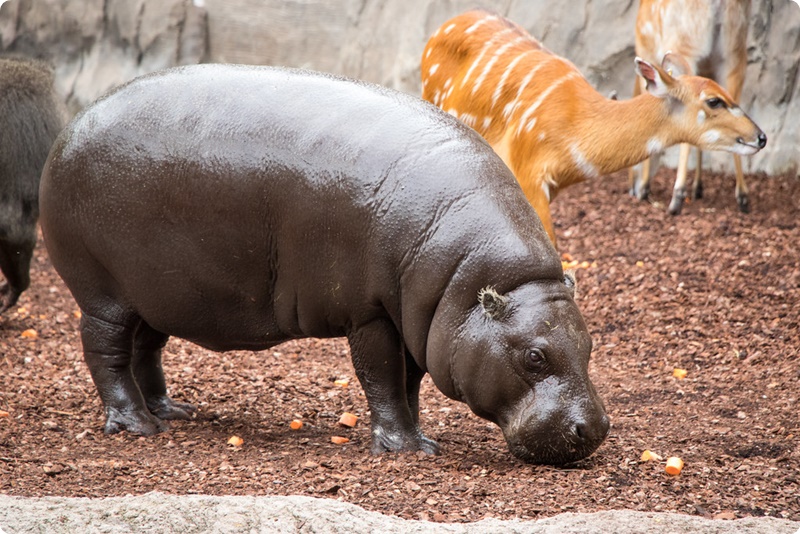
Pygmy Hippopotamus (Choeropsis liberiensis) and Western Sitatunga (Tragelaphus spekii gratus)
Bioparc Valéncia, Valencia, Spain
Photo © Noémi Dalma Soós
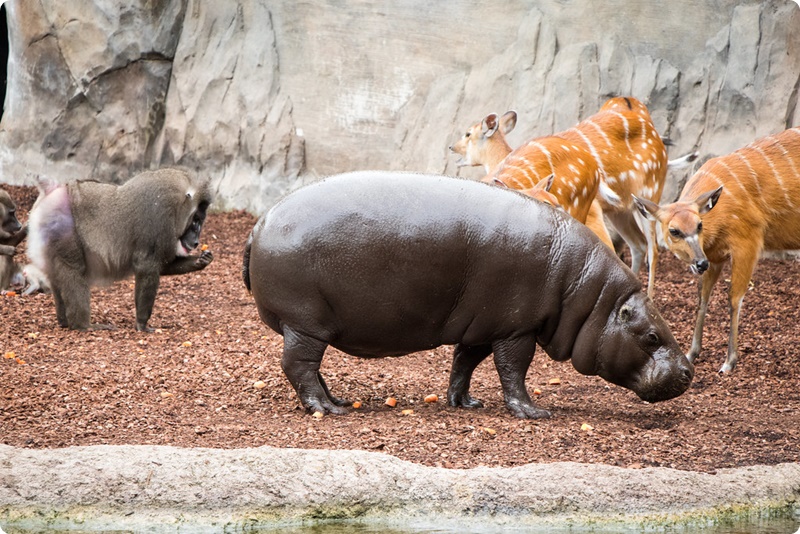
Pygmy Hippopotamus (Choeropsis liberiensis), Drill (Mandrillus leucophaeus) and Western Sitatungas (Tragelaphus spekii gratus)
Bioparc Valéncia, Valencia, Spain
Photo © Noémi Dalma Soós
Pygmy Hippopotamus (Choeropsis liberiensis) and Drill (Mandrillus leucophaeus)
Bioparc Valéncia, Valencia, Spain
Photo © Alexander Meyer
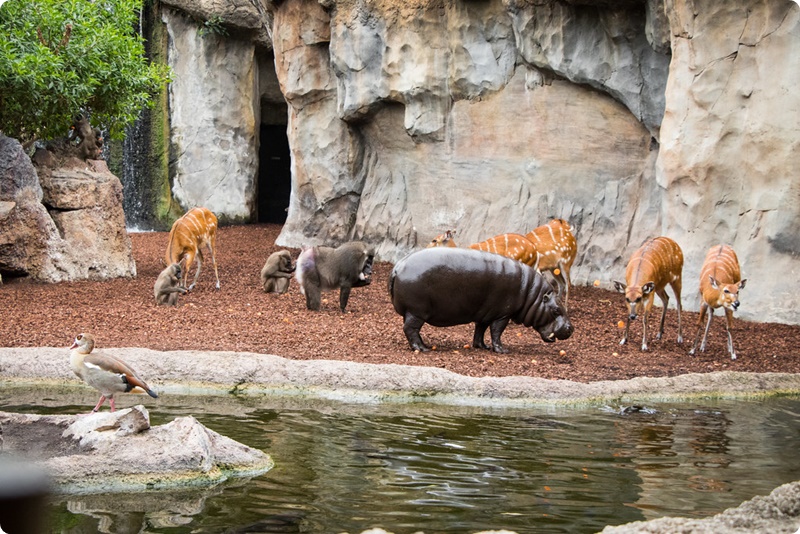
Pygmy Hippopotamus (Choeropsis liberiensis), Drills (Mandrillus leucophaeus), Western Sitatungas (Tragelaphus spekii gratus) and Egyptian Goose (Alopochen aegyptiaca)
Bioparc Valéncia, Valencia, Spain
Photo © Noémi Dalma Soós
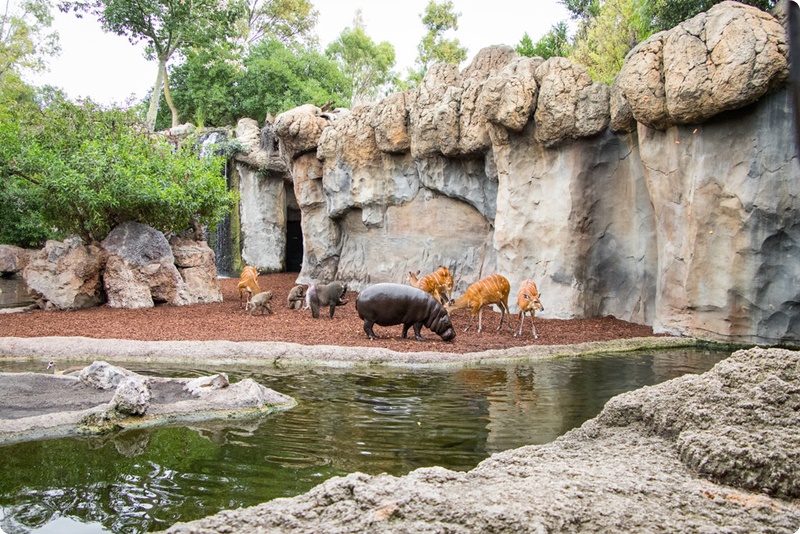
Pygmy Hippopotamus (Choeropsis liberiensis) in a mixed-species exhibit
Bioparc Valéncia, Valencia, Spain
Photo © Noémi Dalma Soós
Pygmy Hippopotamus (Choeropsis liberiensis) in a mixed-species exhibit
Bioparc Valéncia, Valencia, Spain
Photo © Alex Kantorovich
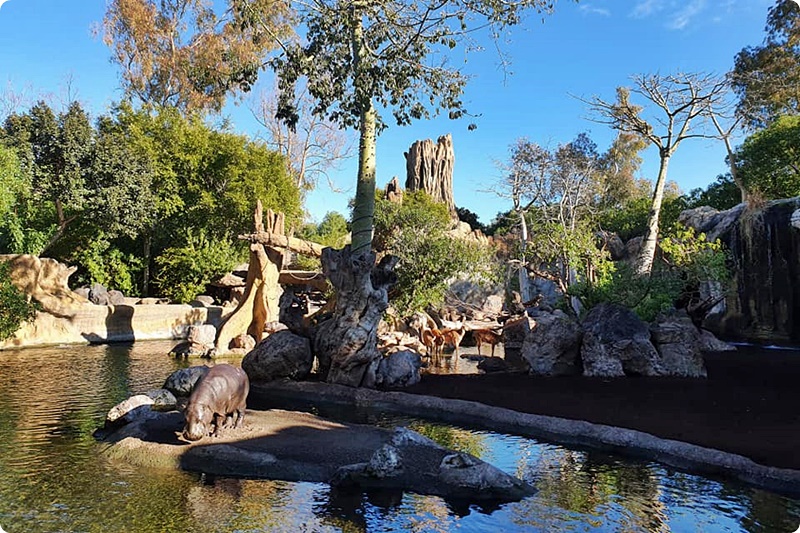
Pygmy Hippopotamus (Choeropsis liberiensis) in a mixed-species exhibit
Bioparc Valéncia, Valencia, Spain
Photo © Juanjo Po
Pygmy Hippopotamus (Choeropsis liberiensis) in a mixed-species exhibit
Bioparc Valéncia, Valencia, Spain
Photo © Fabian Schmidt
Pygmy Hippopotamus (Choeropsis liberiensis) in a mixed-species exhibit
Bioparc Valéncia, Valencia, Spain
Photo © Alex Kantorovich
Combined species:
- Pygmy Hippopotamus, Choeropsis liberiensis
- Diana Monkey, Cercopithecus diana
- Zebra Tilapia, Heterotilapia buettikoferi
- Spotted Tilapia, Pelmatolapia mariae
- Nile Perch, Lates niloticus
Institution(s): Zoo Leipzig (Leipzig, Germany)
Pygmy Hippopotamus (Choeropsis liberiensis) and Diana Monkey (Cercopithecus diana)
Zoo Leipzig, Leipzig, Germany
Photo © Fabian Schmidt
Pygmy Hippopotamus (Choeropsis liberiensis) and Diana Monkeys (Cercopithecus diana)
Zoo Leipzig, Leipzig, Germany
Photo © William Bezodis
Pygmy Hippopotamus (Choeropsis liberiensis) and Spotted Tilapias (Pelmatolapia mariae)
Zoo Leipzig, Leipzig, Germany
Photo © Fabian Schmidt
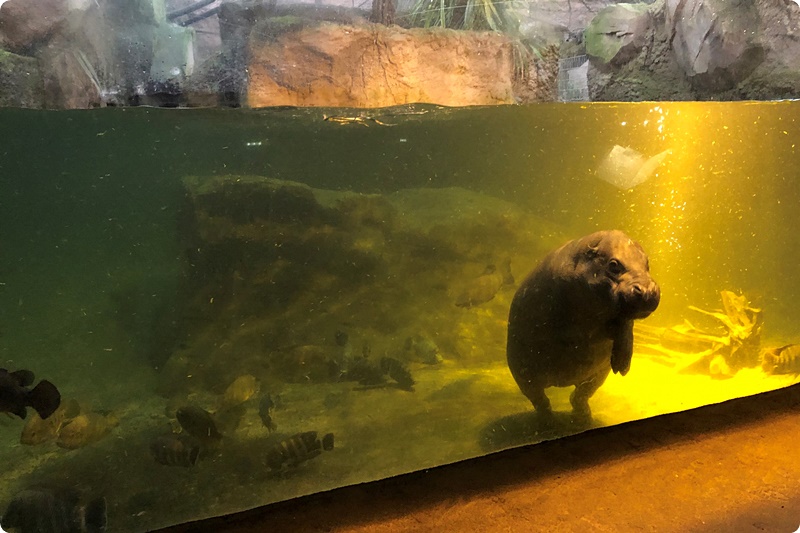
Pygmy Hippopotamus (Choeropsis liberiensis), Zebra Tilapias (Heterotilapia buettikoferi) and Spotted Tilapias (Pelmatolapia mariae)
Zoo Leipzig, Leipzig, Germany
Photo © Ariel Jacken
Combined species:
- Pygmy Hippopotamus, Choeropsis liberiensis
- Diana Monkey, Cercopithecus diana
- De Brazza’s Monkey, Cercopithecus neglectus
- Wolf's Monkey, Cercopithecus wolfi
- African Softshell Turtle, Trionyx triunguis
- fish
Institution(s): Omaha’s Henry Doorly Zoo and Aquarium (Omaha, Nebraska, United States of America)
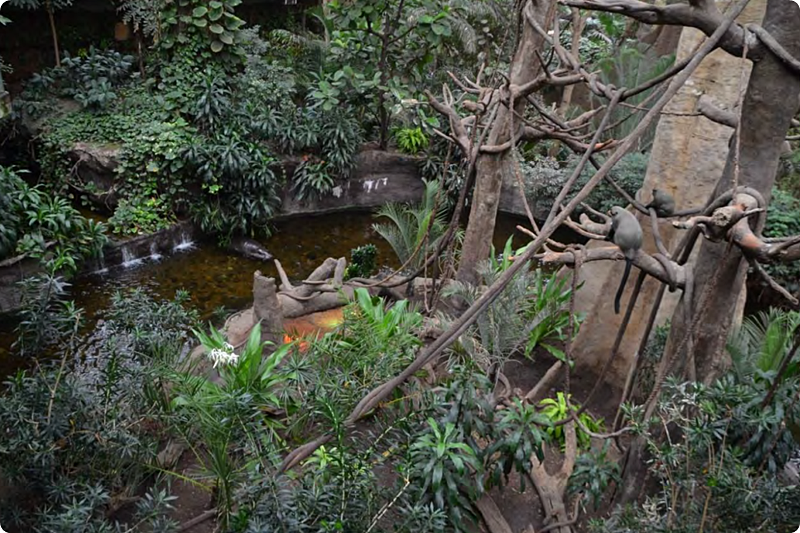
Pygmy Hippopotamus (Choeropsis liberiensis) and primates indoor mixed-species exhibit
Omaha’s Henry Doorly Zoo and Aquarium, Omaha, Nebraska, United States of America
Photo © Fabian Schmidt
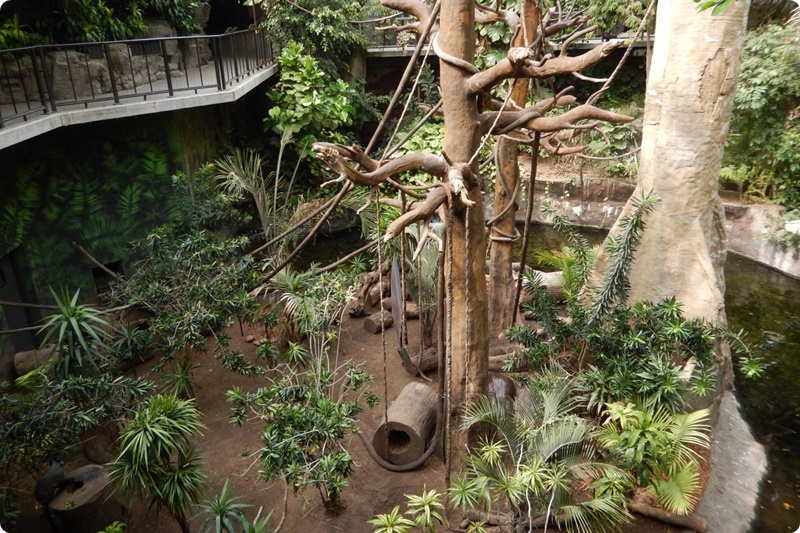
Pygmy Hippopotamus (Choeropsis liberiensis) and primates indoor mixed-species exhibit
Omaha’s Henry Doorly Zoo and Aquarium, Omaha, Nebraska, United States of America
Photo © Josh Chamberlain
Combined species:
- Pygmy Hippopotamus, Choeropsis liberiensis
- Blue Monkey, Cercopithecus mitis
Institution(s): Omaha’s Henry Doorly Zoo and Aquarium (Omaha, Nebraska, United States of America)
Combined species:
- Pygmy Hippopotamus, Choeropsis liberiensis
- Stuhlmann’s Blue Monkey, Cercopithecus mitis stuhlmanni
- Angolan Colobus, Colobus angolensis
- African Softshell Turtle, Trionyx triunguis
Institution(s): Omaha’s Henry Doorly Zoo and Aquarium (Omaha, Nebraska, United States of America)
Combined species:
- Pygmy Hippopotamus, Choeropsis liberiensis
- De Brazza’s Monkey, Cercopithecus neglectus
Institution(s): Parc Zoologique de CERZA (Hermival-les-Vaux, France)
Combined species:
- Pygmy Hippopotamus, Choeropsis liberiensis
- Roloway Monkey, Cercopithecus roloway
Institution(s): Parc Zoologique de CERZA (Hermival-les-Vaux, France)
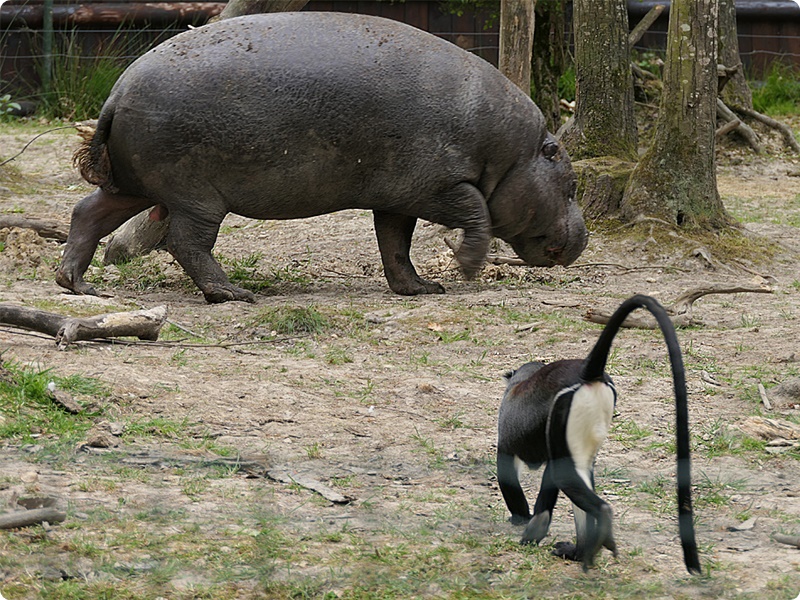
Pygmy Hippopotamus (Choeropsis liberiensis) and Roloway Monkey (Cercopithecus roloway)
Parc Zoologique de CERZA, Hermival-les-Vaux, France
Photo © Dr. Peter Dollinger
Combined species:
- Pygmy Hippopotamus, Choeropsis liberiensis
- Spot-nosed Monkey, Cercopithecus petaurista
- Wolf's Monkey, Cercopithecus wolfi
- African Cichlids, Cichlidae
Institution(s): San Diego Zoo (San Diego, California, United States of America)
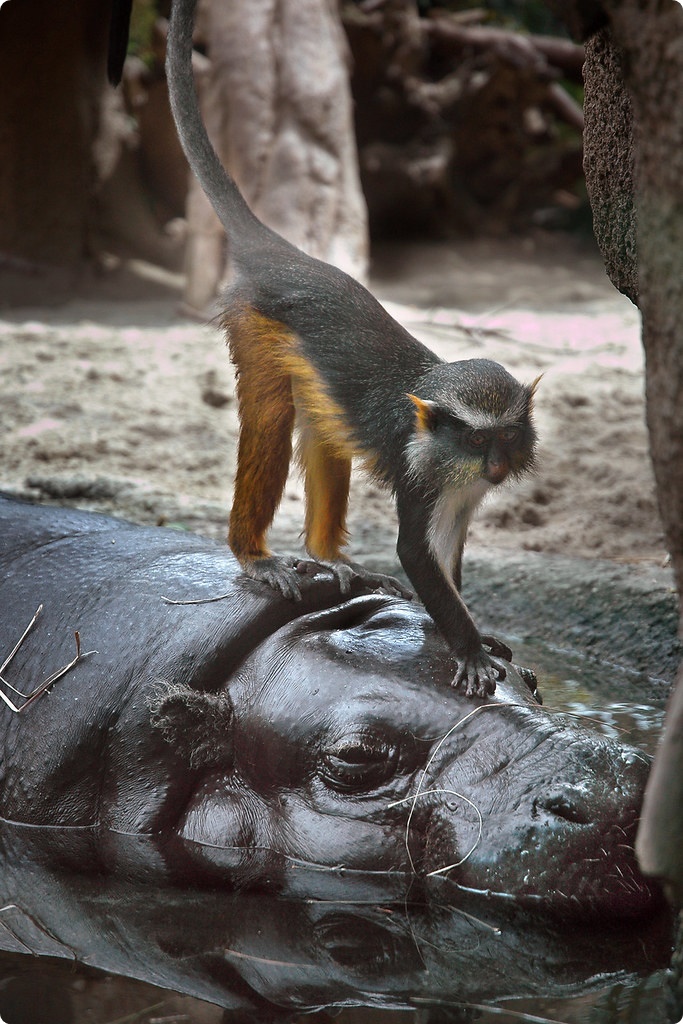
Pygmy Hippopotamus (Choeropsis liberiensis) and Wolf's Monkey (Cercopithecus wolfi)
San Diego Zoo, San Diego, California, United States of America
Photo © Peter Csanadi
Pygmy Hippopotamus (Choeropsis liberiensis) and Wolf's Monkey (Cercopithecus wolfi)
San Diego Zoo, San Diego, California, United States of America
Photo © Edward Breeze
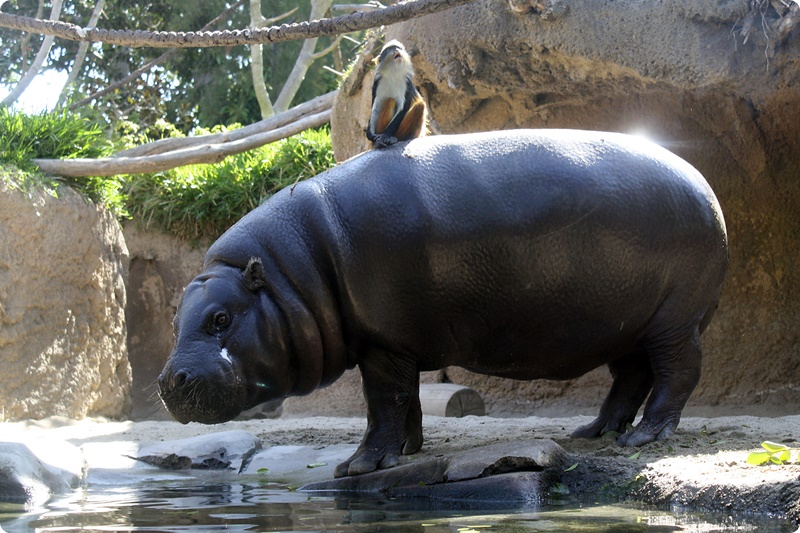
Pygmy Hippopotamus (Choeropsis liberiensis) and Wolf's Monkey (Cercopithecus wolfi)
San Diego Zoo, San Diego, California, United States of America
Photo © Deane D.
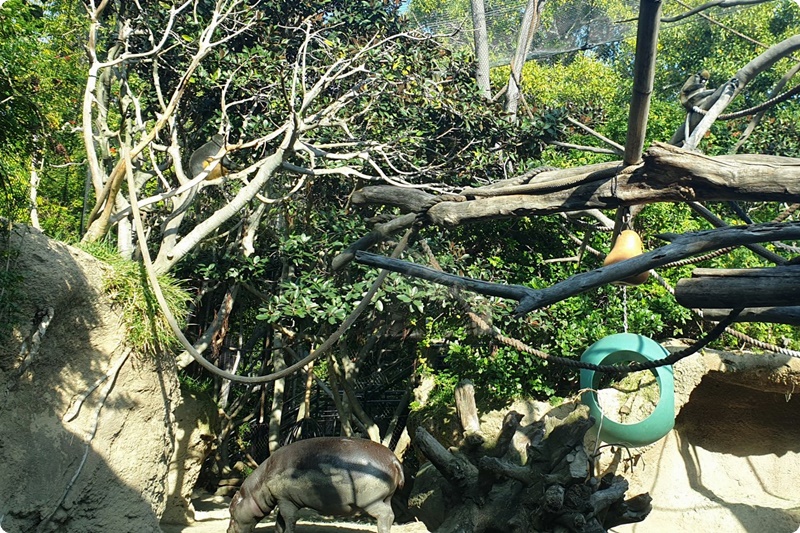
Pygmy Hippopotamus (Choeropsis liberiensis) and primates mixed exhibit
San Diego Zoo, San Diego, California, United States of America
Photo © Konstantin Yordanov
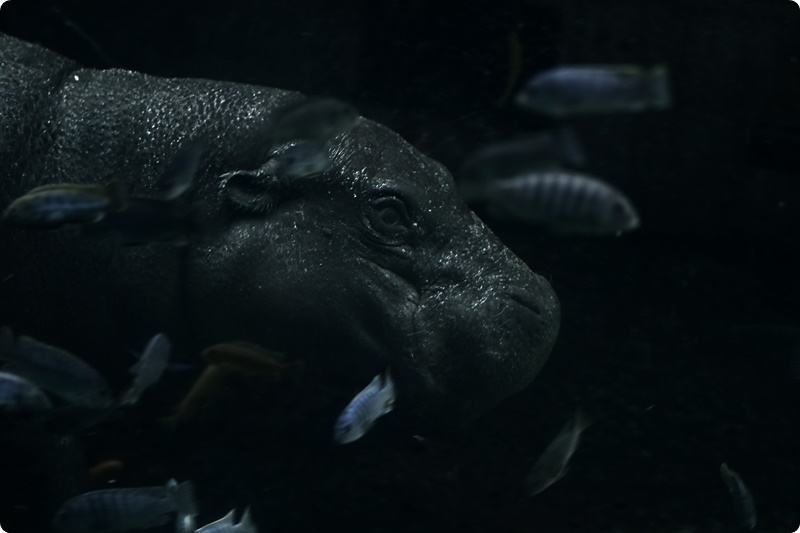
Pygmy Hippopotamus (Choeropsis liberiensis) and African Cichlids (Cichlidae)
San Diego Zoo, San Diego, California, United States of America
Photo © Julio Cesar Castro Garcia
Combined species:
- Pygmy Hippopotamus, Choeropsis liberiensis
- Wolf's Monkey, Cercopithecus wolfi
- Red-flanked Duiker, Cephalophus rufilatus
- Cape Blue Duiker, Philantomba monticola monticola
Institution(s): San Diego Zoo (San Diego, California, United States of America)
Combined species:
- Pygmy Hippopotamus, Choeropsis liberiensis
- Red-capped Mangabey, Cercocebus torquatus
Institution(s): Zoologischer Garten Halle – Bergzoo (Halle, Germany)
Combined species:
- Pygmy Hippopotamus, Choeropsis liberiensis
- Barbary Macaque, Macaca sylvanus
unknown institution
Combined species:
- Pygmy Hippopotamus, Choeropsis liberiensis
- Mandrill, Mandrillus sphinx
Institution(s): South Lakes Safari Zoo (Lindal-in-Furness, United Kingdom), Zoologischer Garten Halle – Bergzoo (Halle, Germany), Bioparc Fuengirola (Fuengirola, Spain), Melbourne Zoo (Melbourne, Victoria, Australia)
Pygmy Hippopotamus (Choeropsis liberiensis) and Mandrill (Mandrillus sphinx)
South Lakes Safari Zoo, Lindal-in-Furness, United Kingdom
Photo © www.zoochat.com
Pygmy Hippopotamus (Choeropsis liberiensis) and Mandrill (Mandrillus sphinx) mixed exhibit
South Lakes Safari Zoo, Lindal-in-Furness, United Kingdom
Photo © www.zoochat.com
Combined species:
- Pygmy Hippopotamus, Choeropsis liberiensis
- Colobus, Colobus sp.
Institution(s): San Diego Zoo (San Diego, California, United States of America)
Combined species:
- Pygmy Hippopotamus, Choeropsis liberiensis
- Peters' Angolan Colobus, Colobus angolensis palliatus
- Great White Pelican, Pelecanus onocrotalus
Institution(s): Zoologická a botanická zahrada města Plzně (Pilsen, Czech Republic)
Combined species:
- Pygmy Hippopotamus, Choeropsis liberiensis
- Silvery Gibbon, Hylobates moloch
Institution(s): Zoologischer Garten Halle – Bergzoo (Halle, Germany)
Combined species:
- Pygmy Hippopotamus, Choeropsis liberiensis
- Sumatran Orangutan, Pongo abelii
Institution(s): Taman Safari Indonesia (Bogor, Indonesia)
Combined species:
- Pygmy Hippopotamus, Choeropsis liberiensis
- Western Lowland Gorilla, Gorilla gorilla gorilla
Institution(s): Louisville Zoo (Louisville, Kentucky, United States of America)
Combined species:
- Pygmy Hippopotamus, Choeropsis liberiensis
- Serval, Leptailurus serval
Institution(s): Bioparc Fuengirola (Fuengirola, Spain)
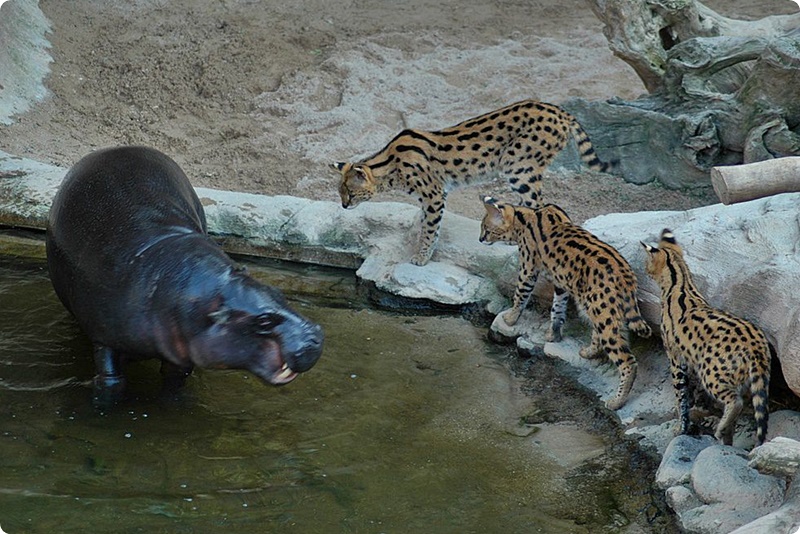
Pygmy Hippopotamus (Choeropsis liberiensis) and Servals (Leptailurus serval)
Bioparc Fuengirola, Fuengirola, Spain
Photo © Jonas Livet
Combined species:
- Pygmy Hippopotamus, Choeropsis liberiensis
- Grant’s Zebra, Equus quagga boehmi
- Grevy’s Zebra, Equus grevyi
- Northern White Rhinoceros, Ceratotherium simum cottoni
- Eastern Black Rhinoceros, Diceros bicornis michaeli
- East African Sitatunga, Tragelaphus spekii spekii
- East African Eland, Tragelaphus oryx pattersonianus
- Topi, Damaliscus korrigum jimela
- Defassa Waterbuck, Kobus ellipsiprymnus defassa
- Uganda Kob, Kobus kob thomasi
- Red Lechwe, Kobus leche leche
- Nile Lechwe, Kobus megaceros
- Common Impala, Aepyceros melampus
- Thomson's Gazelle, Eudorcas thomsonii
- Slender-horned Gazelle, Gazella leptoceros
- Grant's Gazelle, Nanger granti
- Fringe-eared Oryx, Oryx beisa callotis
- Angolan Roan Antelope, Hippotragus equinus cottoni
- Eastern White-Bearded Wildebeest, Connochaetes taurinus albojubatus
- Cape Buffalo, Syncerus caffer
- Rothschild's Giraffe, Giraffa camelopardalis rothschildi
Institution(s): San Diego Zoo Safari Park (Escondido, California, United States of America)
Combined species:
- Pygmy Hippopotamus, Choeropsis liberiensis
- Grant’s Zebra, Equus quagga boehmi
- Greater Kudu, Tragelaphus strepsiceros
- Bontebok, Damaliscus pygargus pygargus
- Slender-horned Gazelle, Gazella leptoceros
- Dama Gazelle, Nanger dama
- Marabou, Leptoptilos crumenifer
- Grey Crowned-crane, Balearica regulorum
Institution(s): Montgomery Zoo and Mann Wildlife Learning Museum (Montgomery, Alabama, United States of America)
Combined species:
- Pygmy Hippopotamus, Choeropsis liberiensis
- Plains Zebra, Equus quagga
- Ostrich, Struthio camelus
Institution(s): Givskud Zoo – Zootopia (Givskud, Denmark)
Combined species:
- Pygmy Hippopotamus, Choeropsis liberiensis
- Grevy’s Zebra, Equus grevyi
- Addax, Addax nasomaculatus
- Scimitar-horned Oryx, Oryx dammah
- Rothschild's Giraffe, Giraffa camelopardalis rothschildi
- Ostrich, Struthio camelus
Institution(s): Aalborg Zoo (Aalborg Zoo, Denmark)
Combined species:
- Pygmy Hippopotamus, Choeropsis liberiensis
- Red River Hog, Potamochoerus porcus
- Addax, Addax nasomaculatus
- Domestic Helmeted Guineafowl, Numida meleagris f. domestica
Institution(s): Szegedi Vadaspark (Szeged, Hungary)
Combined species:
- Pygmy Hippopotamus, Choeropsis liberiensis
- Red River Hog, Potamochoerus porcus
- Nile Lechwe, Kobus megaceros
- Domestic Helmeted Guineafowl, Numida meleagris f. domestica
Institution(s): Szegedi Vadaspark (Szeged, Hungary)
Combined species:
- Pygmy Hippopotamus, Choeropsis liberiensis
- Hippopotamus, Hippopotamus amphibius
unknown institution
Combined species:
- Pygmy Hippopotamus, Choeropsis liberiensis
- Southern Pudu, Pudu puda
Institution(s): ZSL London Zoo (London, United Kingdom)
Combined species:
- Pygmy Hippopotamus, Choeropsis liberiensis
- Mountain Bongo, Tragelaphus eurycerus isaaci
- Grey Crowned-crane, Balearica regulorum
Institution(s): Le Zoo de La Flèche (La Fléche, France)
Pygmy Hippopotamus (Choeropsis liberiensis) and Mountain Bongos (Tragelaphus eurycerus isaaci)
Le Zoo de La Flèche, La Fléche, France
Photo © Fabian Schmidt
Combined species:
- Pygmy Hippopotamus, Choeropsis liberiensis
- Sitatunga, Tragelaphus spekii
Institution(s): Réserve Zoologique de Calviac (Calviac-en-Périgord, France), Batu Secret Zoo (Batu, Indonesia)
Combined species:
- Pygmy Hippopotamus, Choeropsis liberiensis
- Kafue Lechwe, Kobus leche kafuensis
- Black Swan, Cygnus atratus
- Mute Swan, Cygnus olor
- Koi, Cyprinus carpio
Institution(s): Limassol Zoo (Limassol, Cyprus)
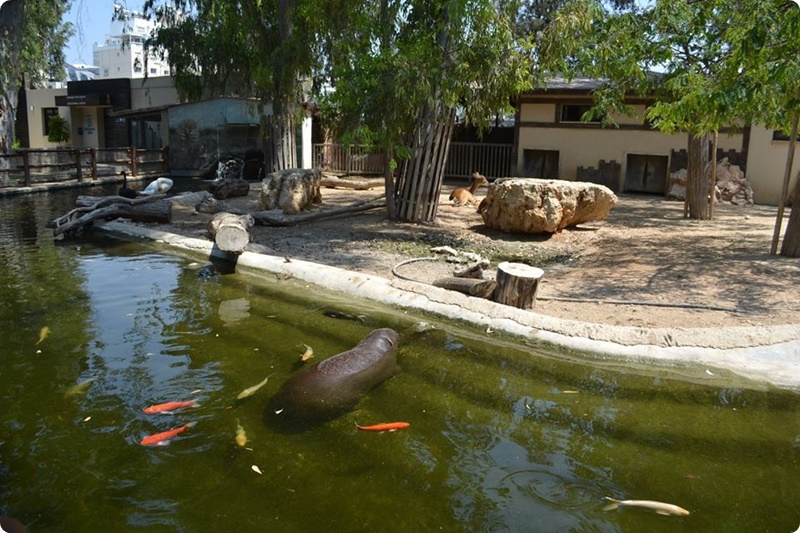
Pygmy Hippopotamus (Choeropsis liberiensis) in a mixed-species exhibit
Limassol Zoo, Limassol, Cyprus
Photo © Joshua Förg
Combined species:
- Pygmy Hippopotamus, Choeropsis liberiensis
- Aoudad, Ammotragus lervia
Institution(s): Nyíregyházi Állatpark (Nyíregyháza, Hungary)
Combined species:
- Pygmy Hippopotamus, Choeropsis liberiensis
- Red-flanked Duiker, Cephalophus rufilatus
Institution(s): Houston Zoo (Houston, Texas, United States of America)
Combined species:
- Pygmy Hippopotamus, Choeropsis liberiensis
- Congo Blue Duiker, Philantomba monticola congica
Institution(s): Koninklijke Burgers' Zoo (Arnhem, the Netherlands)
Pygmy Hippopotamuses (Choeropsis liberiensis) and Congo Blue Duikers (Philantomba monticola congica)
Koninklijke Burgers' Zoo, Arnhem, the Netherlands
Photos © Marc Damen
Combined species:
- Pygmy Hippopotamus, Choeropsis liberiensis
- Great White Pelican, Pelecanus onocrotalus
Institution(s): Pairi Daiza (Brugelette, Belgium)
Combined species:
- Pygmy Hippopotamus, Choeropsis liberiensis
- Goliath Heron, Ardea goliath (only indoor)
Institution(s): Zoologická a botanická zahrada města Plzně (Pilsen, Czech Republic)
Combined species:
- Pygmy Hippopotamus, Choeropsis liberiensis
- Goliath Heron, Ardea goliath
- Black-crowned Night-heron, Nycticorax nycticorax
- Cattle Egret, Bubulcus ibis
- White Stork, Ciconia ciconia
- Yellow-billed Stork, Mycteria ibis
- Marabou, Leptoptilos crumenifer
- African Spoonbill, Platalea alba
- Fulvous Whistling-duck, Dendrocygna bicolor
- other birds
Institution(s): Zoo du Bassin d'Arcachon (La Teste-de-Buch, France)
Combined species:
- Pygmy Hippopotamus, Choeropsis liberiensis
- Cattle Egret, Bubulcus ibis
- Hamerkop, Scopus umbretta
- Violet Turaco, Musophaga violacea
- African Grey Hornbill, Lophoceros nasutus
- Bearded Barbet, Pogonornis dubius
- White-headed Buffalo-weaver, Dinemellia dinemelli
Institution(s): Zoo Zürich (Zürich, Switzerland)
Pygmy Hippopotamus (Choeropsis liberiensis) and bird indoor mixed-species exhibit
Zoo Zürich, Zürich, Switzerland
Photo © Krisztián Svábik
Combined species:
- Pygmy Hippopotamus, Choeropsis liberiensis
- Hamerkop, Scopus umbretta
- Red-billed Hornbill, Tockus erythrorhynchus
- Purple Starling, Lamprotornis purpureus
- Superb Starling, Lamprotornis superbus
- African Catfish, Clarias gariepinus
Institution(s): Aalborg Zoo (Aalborg, Denmark)
Pygmy Hippopotamus (Choeropsis liberiensis) and African Catfish (Clarias gariepinus)
Aalborg Zoo, Aalborg, Denmark
Photo © Fabian Schmidt
Combined species:
- Pygmy Hippopotamus, Choeropsis liberiensis
- Marabou, Leptoptilos crumenifer
Institution(s): Givskud Zoo – Zootopia (Givskud, Denmark)
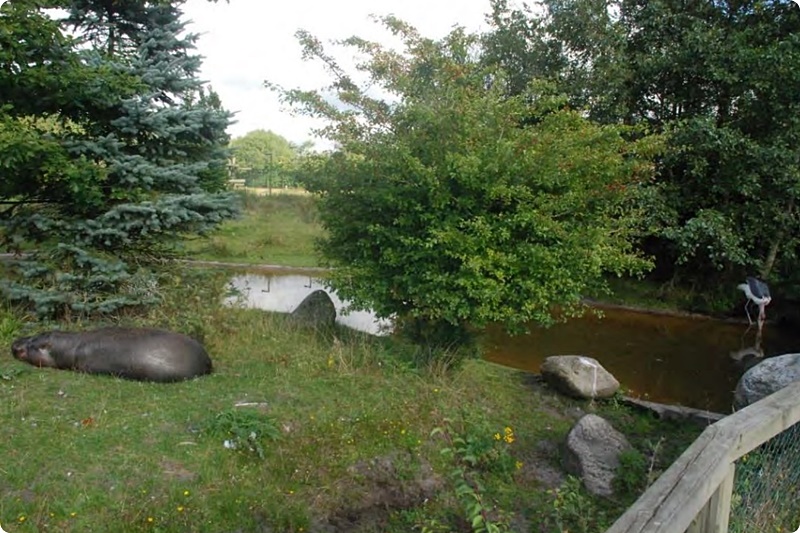
Pygmy Hippopotamus (Choeropsis liberiensis) and Marabou (Leptoptilos crumenifer)
Givskud Zoo – Zootopia, Givskud, Denmark
Photo © Fabian Schmidt
Pygmy Hippopotamus (Choeropsis liberiensis) and Marabous (Leptoptilos crumenifer)
Givskud Zoo – Zootopia, Givskud, Denmark
Photo © Kåre Jensen
Combined species:
- Pygmy Hippopotamus, Choeropsis liberiensis
- Marabou, Leptoptilos crumenifer
- African Spurred Tortoise, Centrochelys sulcata
Institution(s): Xantus János Állatkert (Győr, Hungary)
Combined species:
- Pygmy Hippopotamus, Choeropsis liberiensis
- Greylag Goose, Anser anser
Institution(s): Zoologická zahrada Jihlava (Jihlava, Czech Republic)
Combined species:
- Pygmy Hippopotamus, Choeropsis liberiensis
- Hawaiian Goose, Branta sandvicensis
Institution(s): Zoologická zahrada Jihlava (Jihlava, Czech Republic)
Combined species:
- Pygmy Hippopotamus, Choeropsis liberiensis
- Egyptian Goose, Alopochen aegyptiaca
Institution(s): Bioparc Fuengirola (Fuengirola, Spain), Zoologická zahrada Jihlava (Jihlava, Czech Republic), Melbourne Zoo (Melbourne, Victoria, Australia) (plus other birds)
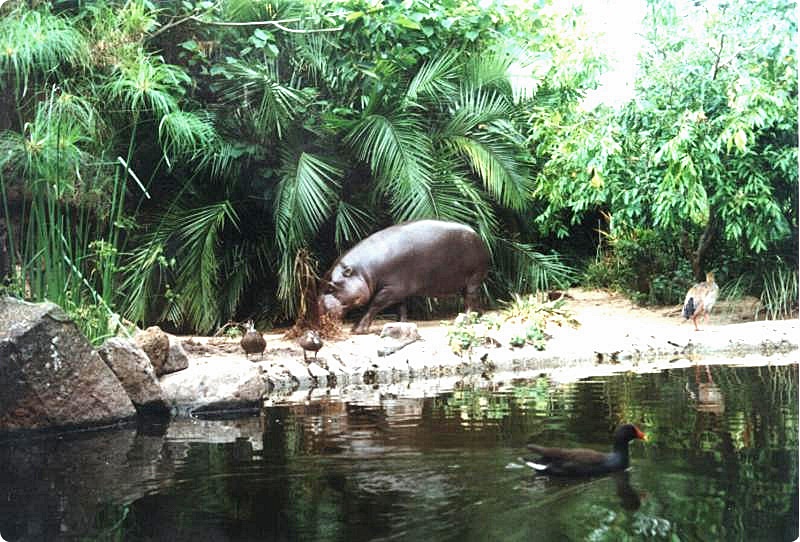
Pygmy Hippopotamus (Choeropsis liberiensis) and birds
Melbourne Zoo, Melbourne, Victoria, Australia
Photo © Monika Fiby
Combined species:
- Pygmy Hippopotamus, Choeropsis liberiensis
- Hartlaub's Duck, Pteronetta hartlaubii
- Rüppell's Vulture, Gyps rueppelli
Institution(s): Franklin Park Zoo – Zoo New England (Boston, Massachusetts, United States of America)
Combined species:
- Pygmy Hippopotamus, Choeropsis liberiensis
- Hartlaub's Duck, Pteronetta hartlaubii
- fish
Institution(s): Zoologischer Garten Berlin (Berlin, Germany)
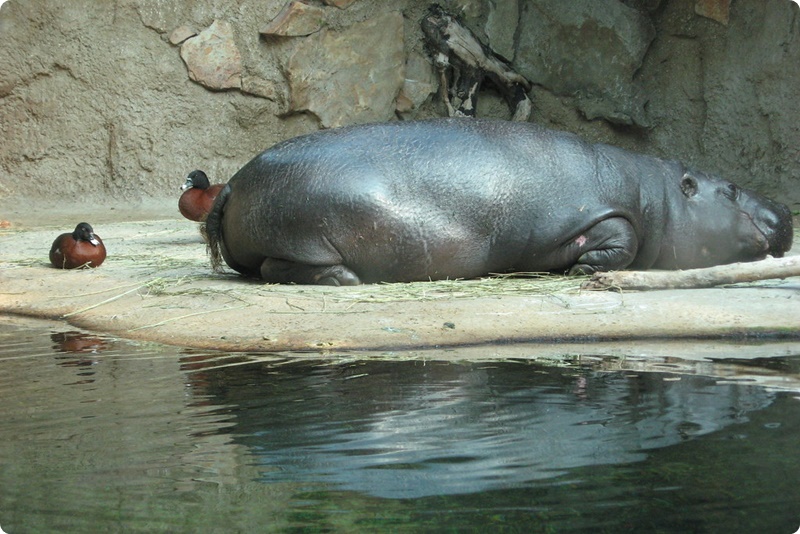
Pygmy Hippopotamus (Choeropsis liberiensis) and Hartlaub's Ducks (Pteronetta hartlaubii)
Zoologischer Garten Berlin, Berlin, Germany
Photo © Albert de Mos
Combined species:
- Pygmy Hippopotamus, Choeropsis liberiensis
- Blue Crane, Anthropoides paradiseus
unknown institution
Combined species:
- Pygmy Hippopotamus, Choeropsis liberiensis
- African Cichlids, Cichlidae
Institution(s): Loro Parque (Puerto de la Cruz, Spain), ZooParc de Beauval (Saint-Aignan, France), Lincoln Park Zoo (Chicago, Illinois, United States of America) (with Zebra Tilapia, Heterotilapia buettikoferi), Singapore Zoo (Singapore), Khao Kheow Open Zoo (Si Racha, Chon Buri, Thailand)
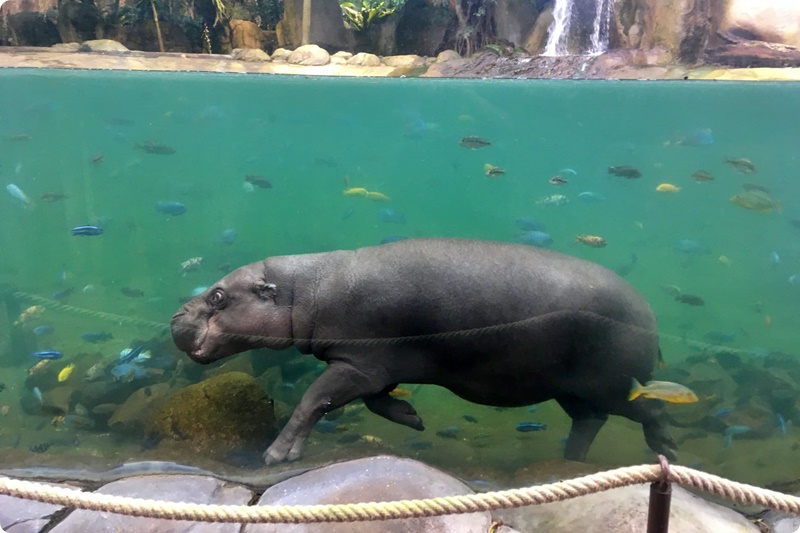
Pygmy Hippopotamus (Choeropsis liberiensis) and African Cichlids (Cichlidae)
ZooParc de Beauval, Saint-Aignan, France
Photo © Wojciech Kopczyk
Pygmy Hippopotamus (Choeropsis liberiensis) and Zebra Tilapias (Heterotilapia buettikoferi)
Lincoln Park Zoo, Chicago, Illinois, United States of America
Photo © www.zoochat.com
Pygmy Hippopotamus (Choeropsis liberiensis) and African Cichlids (Cichlidae)
Singapore Zoo, Singapore
Photo © Fabian Schmidt
Combined species:
- Pygmy Hippopotamus, Choeropsis liberiensis
- Common Carp, Cyprinus carpio
- Grass Carp, Ctenopharyngodon idella
Institution(s): Zoologischer Garten Berlin (Berlin, Germany)
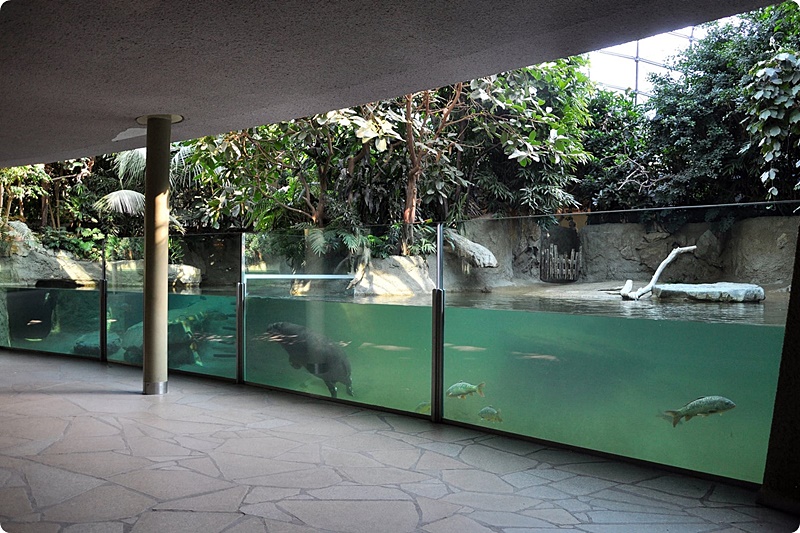
Pygmy Hippopotamus (Choeropsis liberiensis) and fish indoor mixed-species exhibit
Zoologischer Garten Berlin, Berlin, Germany
Photo © Albert de Mos
List of zoological institutes with mixed-species exhibits involving Hippopotamids
Hippopotamus, Hippopotamus amphibius
Australia
Taronga Western Plains Zoo, Dubbo, New South Wales, Australia
Austria
Tiergarten Schönbrunn, Vienna, Austria
Belgium
Monde Sauvage Safari Parc, Aywaille, Belgium
Pairi Daiza, Brugelette, Belgium
ZOO Antwerpen, Antwerp, Belgium
Brazil
Zooparque Itatiba, Itatiba, São Paulo, Brazil
Canada
Calgary Zoo, Calgary, Alberta, Canada
Cuba
Jardín Zoológico de la Habana, Havana, Cuba
Parque Zoológico Nacional, Havana, Cuba
Czech Republic
ZOO Dvůr Králové, Dvůr Králové nad Labem, Czech Republic
Denmark
København Zoo, Copenhagen, Denmark
France
Parc Le PAL, Dompierre-sur-Besbre, France
Zoo du Bassin d'Arcachon, La Teste-de-Buch, France
ZooParc de Beauval, Saint-Aignan, France
ZooSafari de Thoiry, Thoiry, France
Germany
Erlebnis-Zoo Hannover, Hanover, Germany
Kölner Zoo, Cologne, Germany
Zoologischer Garten Berlin, Berlin, Germany
ZOOM Erlebniswelt Gelsenkirchen, Gelsenkirchen, Germany
Indonesia
Taman Safari Indonesia, Bogor, Indonesia
Israel
The Tisch Family Zoological Gardens – Jerusalem Biblical Zoo, Jerusalem, Israel
Zoological Center Tel Aviv – Safari Ramat Gan, Ramat Gan, Israel
Italy
Parco Natura Viva, Bussolengo, Italy
Safari Ravenna, Ravenna, Italy
Zoom Torino, Cumiana, Italy
Kenya
Haller Park, Mombasa, Kenya
Netherlands
Safaripark Beekse Bergen, Hivarenbeek, the Netherlands
WILDLANDS Adventure Zoo Emmen, Emmen, the Netherlands
Poland
Zoo Warszawa, Warsaw, Poland
ZOO Wrocław, Wrocław, Poland
Russia
Yekaterinburgskiy Zoopark, Yekaterinburg, Russia
South Africa
Bothongo Rhino & Lion Nature Reserve, Krugersdorp, South Africa
Spain
Bioparc Valéncia, Valencia, Spain
Switzerland
Zoo Basel, Basel, Switzerland
Zoo Zürich, Zürich, Switzerland
United Kingdom
Longleat, Warminster, United Kingdom
United States of America
Adventure Aquarium, Camden, New Jersey, United States of America
BREC's Baton Rouge Zoo, Baton Rouge, Louisiana, United States of America
Cheyenne Mountain Zoo, Colorado Springs, Colorado, United States of America
Cincinnati Zoo & Botanical Garden, Cincinnati, Ohio, United States of America
Cleveland Metroparks Zoo, Cleveland, Ohio, United States of America
Disney's Animal Kingdom Theme Park, Bay Lake, Florida, United States of America
Memphis Zoo, Memphis, Tennessee, United States of America
Saint Louis Zoo, Saint Louis, Missouri, United States of America
San Antonio Zoo, San Antonio, Texas, United States of America
San Diego Zoo, San Diego, California, United States of America
ZooTampa at Lowry Park, Tampa, Florida, United States of America
 Pygmy Hippopotamus, Choeropsis liberiensis
Pygmy Hippopotamus, Choeropsis liberiensis
Australia
Melbourne Zoo, Melbourne, Victoria, Australia
Belgium
Pairi Daiza, Brugelette, Belgium
Cyprus
Limassol Zoo, Limassol, Cyprus
Czech Republic
Zoologická a botanická zahrada města Plzně, Pilsen, Czech Republic
Zoologická zahrada Jihlava, Jihlava, Czech Republic
Denmark
Aalborg Zoo, Aalborg, Denmark
Givskud Zoo – Zootopia, Givskud, Denmark
France
Le Zoo de La Flèche, La Fléche, France
Parc Zoologique de CERZA, Hermival-les-Vaux, France
Réserve Zoologique de Calviac, Calviac-en-Périgord, France
Zoo du Bassin d'Arcachon, La Teste-de-Buch, France
ZooParc de Beauval, Saint-Aignan, France
Germany
Zoo Leipzig, Leipzig, Germany
Zoologischer Garten Berlin, Berlin, Germany
Zoologischer Garten Halle – Bergzoo, Halle, Germany
Hungary
Nyíregyházi Állatpark, Nyíregyháza, Hungary
Szegedi Vadaspark, Szeged, Hungary
Xantus János Állatkert, Győr, Hungary
Indonesia
Batu Secret Zoo, Batu, Indonesia
Taman Safari Indonesia, Bogor, Indonesia
Netherlands
Koninklijke Burgers' Zoo, Arnhem, the Netherlands
Singapore
Singapore Zoo, Singapore
Spain
Bioparc Fuengirola, Fuengirola, Spain
Bioparc Valéncia, Valencia, Spain
Loro Parque, Puerto de la Cruz, Spain
Switzerland
Zoo Zürich, Zürich, Switzerland
Thailand
Khao Kheow Open Zoo, Si Racha, Chon Buri, Thailand
United Kingdom
South Lakes Safari Zoo, Lindal-in-Furness, United Kingdom
ZSL London Zoo, London, United Kingdom
United States of America
Brookfield Zoo, Brookfield, Illinois, United States of America
Franklin Park Zoo – Zoo New England, Boston, Massachusetts, United States of America
Houston Zoo, Houston, Texas, United States of America
Lincoln Park Zoo, Chicago, Illinois, United States of America
Louisville Zoo, Louisville, Kentucky, United States of America
Montgomery Zoo and Mann Wildlife Learning Museum, Montgomery, Alabama, United States of America
Omaha’s Henry Doorly Zoo and Aquarium, Omaha, Nebraska, United States of America
San Diego Zoo, San Diego, California, United States of America
San Diego Zoo Safari Park, Escondido, California, United States of America
SUMMARIZE THE EXPERIENCES
The study lists species combinations and mixed exhibits with both species of Hippopotamidae. Altogether 116 mixed exhibits with hippopotamids have been collected from 77 zoological institutions worldwide until May 2022.
The results show that Pygmy Hippopotamus has been listed in 63 and Hippopotamus in 54 mixed exhibits.
In regard to species combinations – but not counting fish species – Pygmy Hippopotamus has been socialized with 107 and Hippopotamus with 101 different species.
Hippopotamuses can be very dangerous animals so in former times it was thought that they cannot be combined with other species in captivity (PUSCHMANN 1983). The other basic reason to have not associated them with other taxa was keeping them mostly in small indoors where no space was available for other species. Later on this has changed and huge outdoor enclosures and aviaries as well made it possible to combine them principally with primates and ungulates, but with many species of birds and fish as well. Just as a point of interest GRZIMEK (2000) reported a friendship of an adult female Hippopotamus – which was kept alone in Zoologischer Garten Halle – with a dog which was allowed to crawl into the hippo’s mouth and licked there. Worth mentioning that especially young and playful hippos turn to other species in the absence of playmates and they particularly profit from cohabitations established in mixed exhibits (HAMMER 2002).
There is a known early case of the two hippo species being kept together. A lethal accident has also been registered in reference to that: in 1949 a female Pygmy Hippo was killed by a male Hippopotamus as reported in a former International Studbook (TOBLER 1985).
Hippopotamus
In nature frustrated Hippopotamuses – particularly younger males – have been known to vent their aggression on other species (KINGDON 1979).
According to the Husbandry Guidelines for the Common Hippopotamus any of the species which can be seen together with hippos in their natural habitat – as mentioned above herons, egrets, storks, spoonbills, geese and ducks – or other African species of birds would exhibit well with them in captivity. Another possibility would be exhibiting arboreal primates which would be safe from the Hippopotamuses up in trees (JONES 2008).
The Adventure Aquarium in Camden has successfully mixed Hippopotamuses (0.2) and Cape Porcupine (2.0) together with assorted species of African Cichlids since 2005. Porcupines were introduced to hippos in the holding area via pen while hippos were on the other side of the area. This procedure was done several times until the Hippopotamuses no longer reacted to their presence in the holding area before introducing them on exhibit. There are strategically placed areas of deadfall branches that the rodents can hide behind or under so hippos cannot reach them. A waterfall with a land area also has been created that the porcupines can walk up but the Hippopotamuses cannot access. The institution has had many species of African Cichlids over the years and there was no introductory period for them. The Hippopotamuses do not bother the fish at all: the success is more about selecting cichlids because they are tolerant of the water quality parameters needed to maintain good exhibit clarity. When the exhibit opened in 2005 it also housed many species of African birds. The species that were most successful housed together with the hippos the following: Cattle Egret, Hamerkop, Abdim’s Stork and Taveta Golden Weaver. All of these species tended to stay well away from the Hippopotamuses. The hippos would occasionally go after any species of birds that would tend to spend too much time on the ground, near the water's edge or fell in the pool. When the staff identified a problem with a specific species they would be moved out of the exhibit. These are the following: Crowned-crane, White-bellied Bustard and Purple Swamphen which species would not move away from the Hippopotamuses on land. Combination was not successful with any species of duck as well: at first ducks would actively avoid the hippos, but over time they would eventually become desensitized to the Hippopotamuses and stop moving away from them in the pool. Eventually all of the birds were moved out in 2013 due to an exhibit redesign process (AZA Ungulate TAGs 2017).
Jerusalem Biblical Zoo kept a single female Hippopotamus in a mixed exhibit with other African species, including Grant’s Zebra, Southern White Rhinoceros, Addax, South African Giraffe, Masai Ostrich and Marabou. The hippo was moved there when she was already old and her mobility was limited so the staff felt confident to put her together with the other species. The hippo died two years ago – at the very respected age of over 59 years old – after living for about 9,5 years in the mixed exhibit without any incidents. Since her death the management has been discussing to introduce young Hippopotamuses into the same exhibit, but this is something that the institution has not done yet, as they feel that with younger individuals there will be a need to first make some major adjustments to the yard to guarantee keeper safety and also that of other species (WERNER 2020, pers. comm.).
The Africa enclosure in Zoo Basel was opened in two stages in 1992 and 1993, where Hippopotamuses, Plains Zebras and Ostriches shared the same habitat. First, a young pair of hippos and a small herd of zebras moved in and one year later the ostriches joined them in the 1750 m² exhibit. For feeding and overnight the hippos and zebras were always separated. Since the opening till 2012, 9 hippos and 37 zebra foals have been born and 240 ostrich chicks have hatched. A problem has arisen when all three species have young at the same time. At the beginning it was soon realised that the originally planned combination was more difficult than expected. The first difficulty was the camouflage behaviour of the young ostriches, since they do not run away when threatened, but lie down on the ground and try to look like a tuft of grass. For the curious zebras the temptation was great to take a closer look at them and if they then started to play with them, this could be dangerous for the chicks. Therefore, until they were big enough they were separated from the zebras. Female zebras with new-born foals – as well as young ostriches – were separated for their first weeks of life, too. Hippopotamuses and zebras lived peacefully together for twelve years. Then, in 2004, the zebra stallion had an accident and a natural barrier was erected with piled up branches, so henceforward direct contact between them was no longer possible. Previously the zebra stallion had been in charge of the enclosure for years. He made it unmistakably clear to the hippo bull where the territorial boundary lay by means of a playful ritual every morning at the edge of the pool. One day the zebra slipped and fell into the water, whereupon the hippo fatally injured the zebra stallion. After that, the hippos no longer left their pond only at night when the zebras were in the pen, but also during the day and thus became a danger to the other species and the zookeepers as well (ZOO BASEL). This was not the only fatal incident in the Africa enclosure caused by hippos. In 2008 a sub-adult Ostrich was bitten to death by a Hippopotamus: the bird slipped on the bank of the water basin and fell in, then the hippo immediately fought off the intruder in its territory and bit.
In smaller enclosures it is important to provide retreats that can only be visited by the subdominant animal species. In Zoologischer Garten Berlin the outdoor enclosures of the Hippopotamuses and Nyalas are adjacent to each other. The antelopes can enter the Hippopotamus enclosure, but can retreat into their own enclosure at any time behind a barrier that is insurmountable for the hippos. The aggressive Nyala buck procures escape into the pool by targeted attacks with violent horn blows into the flanks or the hindquarters of the Hippopotamus (ZSCHEILE & ZSCHEILE 2018).
In Safaripark Beekse Bergen Hippopotamuses has been held with Western Sitatunga and Nile Lechwe without any problems, additionally there is an old Marabou in the exhibit as well. No problems, but also no cohesion or social behaviour has been reported between the species (VERSTEEGE 2020, pers. comm.).
Parc Le PAL has a very successful mixed exhibit, where Hippopotamuses and Great White Pelicans coexist together perfectly. Beyond a passive cohabitation there are regular interactions between the species: it is not uncommon to see a pelican on the back of a hippo or even the birds are seeking in the mouths of Hippopotamuses. Whether it is on the water or on their island that they all share together, a negative interaction has never been reported. The size of their enclosure – 1,5 hectare and a lake is 1 hectare – probably contributes to the tranquility of the animals (GÉLI 2020, pers. comm.).
In Disney’s Animal Kingdom Theme Park two groups of Hippopotamuses (1.7 or 5.0) have been successfully mixed with Pink-backed Pelican (9.7.2), White-breasted Cormorant (2.2) and with other birds in the past. Hippos are in two separate exhibits and the birds can all move freely from the two enclosures. There are several islands in the deeper water that it is hard for the Hippopotamus to navigate or approach and several logs have also been placed in the exhibit to provide safe places for the birds away from the hippos; this was the key of the success when pelican chicks were hatched as well. The Hippopotamus often become territorial and a few pelicans have been attacked by the hippos when birds get too close to them. In a smaller exhibit another group of Hippopotamus (2.0) has been successfully mixed with White-eyed Duck (1.1) and Tufted Duck (4.2). Ducks were breeding: nest boxes were placed in the exhibit and fixed to the walls so hippos could not move them (AZA Ungulate TAGs 2017).
It is also worth mentioning that several zoos have positive experience keeping their Hippopotamuses in exhibits with large lakes where they coexist together with different species of waterfowl, i. e. Parque de la Naturaleza de Cabárceno, Longleat or Greater Vancouver Zoo just to name a few which combinations have not always been mentioned in the list of mixed-species exhibits.
In 2004, a baby Hippopotamus – named Owen – orphaned by an earthquake was rescued and brought to Haller Park in Mombasa, Kenya. There were no other hippos there, so Owen was associated with Mzee, the park's 130-year-old Aldabra Giant Tortoise. Shortly they became the subject of media attention after forming an unusual friendship with many interactions between them such as eating, sleeping and playing together. Three years later the tortoise was removed and a female Hippopotamus was introduced.
In Cheyenne Mountain Zoo there are possible future plans for the Hippopotamuses and Common Warthogs to share the outdoor enclosure in the Water’s Edge: Africa exhibit, but that interaction has not yet been implemented (KOCH 2021, pers. comm.).
Pygmy Hippopotamus
In the EAZA Ex-situ Programme (EEP) of the Pygmy Hippopotamus various mixed-species exhibits exist with the hippos and different monkey, antelope and bird species. Most holders report no problems, but the Mandrills – especially the males – can be aggressive towards the hippos. Aggression has also occurred between Pygmy Hippos and Blue Cranes, and between Pygmy Hippos and a castrated male Sitatunga. In both cases, the other species were the aggressors. When Pygmy Hippopotamuses are housed with bird species, the institution has to be aware of the fact that hippos killed and fed on several birds, such as ducks, geese or egrets. As birds are often pinioned, this needs to be taken into consideration. In general it is advised not to keep pinioned birds with Pygmy Hippos (HOUWALD et al. 2020).
Zoologischer Garten Halle has lots of experience keeping their Pygmy Hippopotamuses together with several species of New and Old World Monkeys as well. Since 2000 a mixed group of callitrichids – Saddleback Tamarin (0.0.9), Red-chested Mustached Tamarin (1.1) and Goeldi’s Monkey (1.1) – were associated with Pygmy Hippopotamus (1.1) in a 110 m³ indoor enclosure around a giant artificial tree. Later on a group of Mandrill (2.2) were kept together with the hippos only outdoors. The outdoor enclosure was 220 m² with two separated areas and pools for each Pygmy Hippo so the individuals were kept separately. Mandrills had access to the whole outdoor enclosure which was approximately 1000 m³. Both of the species had their own indoor enclosures. Mandrills approached the hippopotamuses to steal food and mutual threats were realized. In general association was not accompanied by major interspecific but by intraspecific problems: initial cohabitation of the two Mandrill pairs was not successful and animals had to be separated again (ZIEGLER 2002). So because of the aggressive male Mandrill the combination with Pygmy Hippopotamus did not work for a longer time (HEUER 2020, pers. comm.).
In the Tropic World Africa exhibit of Brookfield Zoo a Pygmy Hippopotamus (0.1), Talapoin Monkey (various groups), Sykes’s Monkey (3.2), Red-tailed Monkey (1.3), Sooty Mangabey (1.4), Red-capped Mangabey (5.0 or 4.0 or 2.0), Mandrill (1.3), Guereza (3.4) and birds (23 species) were successfully mixed for 16 years. Hippo was always introduced first to new primate species. The institution has only ever maintained one female hippo at a time, but has had three different hippos there from 1982-2012. The addition or removal of primates had no consequence to that of the hippopotamus at the time. The staff had no problems with hippos, but from time to time the monkeys – i.e. Red-capped Mangabeys – harassed the Pygmy Hippo mildly to which she would go back to the pool until the monkey lost interest. In general, all primates and the hippo coexisted without problem. The institution did not stop exhibiting the hippo in this exhibit for lack of success: the management decided to exhibit the species in just one area of the zoo so the Pygmy Hippopotamus has been moved to the Pachyderm House in 2012 (AZA Ungulate TAGs 2017).
The length of time the above-mentioned mixed-species group has been together in Brookfield Zoo: there has been a consistent core group of species – Sooty Mangabey, Mandrill and Guereza – since 1982. The current Sooty Mangabey and Mandrill groups still include some of the original individuals from the 1982 opening of the exhibit. The Sykes’s Monkeys were a consistent part of the exhibit mix for 13 years, from 1982 to 1995. Talapoin Monkeys and Red-tailed Monkeys were also part of the original mixed exhibit, but were removed in 1985. The Red-tailed Monkeys and the Sykes’s Monkeys were not exhibited together due to the potential of hybridization. The original Pygmy Hippopotamus died in 1991 and was replaced. The number and variety of birds has varied since 1982. The method of introduction was to introduce the “smaller more benign” species first – i.e. Talapoin Monkey and Red-tailed Monkey – and work up through the “larger, potentially more aggressive” species – i.e. Sykes’s Monkey, Sooty Mangabey, Mandrill and Guereza. Almost each species had a few days on exhibit alone before any polyspecifics were added to the introduction. In reference to occurrence of birth all primates were regularly bred in the exhibit. Worth mentioning that all primate and bird interactions were negative; it has been reported that some of the birds were eaten or killey by Sooty Mangabeys and Mandrills. In general, the animals are separated at night by species, using different access doors (STRANGE HONEYCUTT 2013).
In Lied Jungle of Omaha’s Henry Doorly Zoo and Aquarium a successful combination of Pygmy Hippopotamus (0.1), Stuhlmann’s Blue Monkey (1.1), Angolan Colobus (2.0) and African Softshell Turtle (1.1) was created in 2011. The species are exhibited together during the day and are separated in night holding due to ensuring they receive the proper diet. The turtles remain on exhibit continuously. The introduction of primates took place in holding area over five days and then they met the hippopotamus and turtles on exhibit: all went very well and was either positive or no interaction has been reported (STRANGE HONEYCUTT 2013).
San Diego Zoo has established a very successful mixed exhibit with Pygmy Hippopotamus (1.1), Wolf's Monkey (2.1.1), Red-flanked Duiker (1.0) and Cape Blue Duiker (2.0) in 2005. The pair of hippos were the first into the exhibit; they were given access round to the bedrooms and exhibit. The duikers and the hippopotamuses were given access to both the exhibit and the bedrooms at night, while the monkeys were kept in the indoor holding at night. According to the introduction method the hippos were the first ones on exhibit. Once they were trained to re-call, the primates were introduced to the holding area. After a few days the monkeys were given access to the exhibit with the Pygmy Hippopotamuses in the barn. Once the monkeys were comfortable they were introduced to the hippos. The Duikers were introduced shortly thereafter with no special accommodations, except for some safety barriers – shade material fixed to the fence – to prevent injuries. The most notable interaction has been reported was that of the juvenile monkey and the Duikers, whom he has become accustomed to riding. This mixed exhibit was considered as a tremendous success for both the animals and the public, as it is one of the most unique and dynamic enclosures in the zoo. In 2012 the duikers were removed from the exhibit; they were managing well, but not thriving due to young Wolf’s Monkeys jumping on their back (STRANGE HONEYCUTT 2013). This interaction can also be frequently observed in reference to the Pygmy Hippopotamuses: the Wolf’s Monkeys are jumping and travelling on the hippos’ back.
San Diego Zoo Safari Park has previously exhibited Pygmy Hippopotamus together with Grant’s Zebra, Grevy’s Zebra, Northern White Rhinoceros, Eastern Black Rhinoceros, East African Sitatunga, East African Eland, Topi, Defassa Waterbuck, Uganda Kob, Red Lechwe, Nile Lechwe, Common Impala, Thomson's Gazelle, Slender-horned Gazelle, Grant's Gazelle, Fringe-eared Oryx, Angolan Roan Antelope, Eastern White-Bearded Wildebeest, Cape Buffalo and Rothschild's Giraffe in a 36 hectare East Africa Exhibit. Over the years the institution has exhibited many of those species together at one time or another and never had any trouble with the hippos, but to tell the truth they mostly stayed on an island in the middle of the pond that was in the exhibit (BLUE 2008, pers. comm.).
Zoo Jihlava tried to mix their Pygmy Hippopotamuses temporarily with several species of waterfowl – i.e. Greylag Goose, Hawaiian Goose and Egyptian Goose – which has generally worked well (VIDUNA 2020, pers. comm.).
In Franklin Park Zoo's Tropical Forest building Pygmy Hippopotamus (1.1), Hartlaub's Duck (1.1) and Rüppell's Vulture (1.1) have been successfully mixed since 2000. The male hippo is still too young to be introduced to the older female so currently each hippopotamus is rotated to the exhibit every other day for display. The vultures have been housed in this exhibit for a long time but over the past two years, these two specimens have been housed outdoors in the summer months. The exhibit also contains Hartlaub's Ducks which were introduced three years ago; these birds mainly inhabit the exhibit pool and so far have had no negative interactions with either the hippos or vultures. An elevated perching and nesting platform is provided for the vultures which is not accessible for the hippos (AZA Ungulate TAGs 2017).
Certain zoos keep Pygmy Hippopotamuses with several fish species – i.e. with Labeo spp. or West African Cichlids. The fish feed on the faeces but do not succeed in clearing the water from debris. Furthermore fish can feed on the skin and wounds of the hippos. The disadvantage of this is that the fish will keep wounds open for longer so careful monitoring is needed (HOUWALD et al. 2020).
ACKNOWLEDGEMENTS
I would like to thank all the persons very much who helped to improve this short summary with providing information and photographs as well, in particular:
Jörg BECKMANN Chair of Tapir and Suiform TAG and Vice Director/Biological Director (Tiergarten Nürnberg, Nuremberg, Germany), Andy BLUE former Animal Care Manager, Mammal Department (San Diego Zoo Safari Park, Escondido, California, United States of America), Marc DAMEN former Director General/CEO (Diergaarde Blijdorp, Rotterdam, the Netherlands), Dr. Peter DOLLINGER (Zoo Office Bern, Bern, Switzerland), Monika FIBY Landscape Architect, Zoo Designer and Consultant (ZooLex Zoo Design non-profit Organization, Manager and Chief Editor), Nicolas GÉLI Head of Department of Zoology (Le PAL - Parc d’Attractions et Animalier, Saint-Pourçain-sur-Besbre, France), Katharina HERRMANN Conservation Coordinator (Zoologischer Garten Berlin, Berlin, Germany), Jutta HEUER Scientific Assistant (Zoologischer Garten Halle – Bergzoo, Halle, Germany), Sander HOFMAN General Curator (ZOO Antwerpen – ZOO Planckendael – ZOO Serpentarium, Belgium), Ruben HOLLAND Curator (Zoo Leipzig, Leipzig, Germany), Bengt HOLST former Chair of Tapir and Suiform TAG and Chairman of the Danish Nature Foundation (Copenhagen, Denmark), Brent HUFFMAN Lead Keeper & Zoologist, AZA Ungulates Team (Toronto Zoo, Ontario, Canada), Willeke HUIZINGA Curator of Bush, Desert and Mangrove (Koninklijke Burgers’ Zoo, Arnhem, the Netherlands), Ariel JACKEN Senior Curator (Zoo Leipzig, Leipzig, Germany), Alex KANTOROVICH Euroasian Regional Coordinator at Species360 and Curator (Hai Park, Kiryat Motzkin, Israel), Jenny KOCH Marketing Director (Cheyenne Mountain Zoo, Colorado Springs, Colorado, United States of America), Sarah LAFAUT Curator of Mammals (ZOO Antwerpen – ZOO Planckendael, Belgium), Jonas LIVET Chief Executive & Project Officer (Fox Consulting, Haguenau, France), Zsuzsa PETRÓ Head of Department (Nyíregyházi Állatpark, Nyíregyháza, Hungary), Klaus RUDLOFF Curator Emeritus (Tierpark Berlin, Berlin, Germany), Fabian SCHMIDT Curator (Zoo Basel, Basel, Switzerland), Dr. Alexander SLIWA Curator (Kölner Zoo, Cologne, Germany), Dr. Leszek SOLSKI Senior Scientific Assistant and Zoo-Historian (ZOO Wrocław, Wrocław, Poland), Beatrice STECK Scientific Assistant and EEP Coordinator (Zoo Basel, Basel, Switzerland), Elodie TRUNET Veterinarian & Curator (Zoo du Bassin d'Arcachon, La Teste de Buch, France), Lars VERSTEEGE Curator (Safaripark Beekse Bergen, Hilvarenbeek, the Netherlands), Richard VIDUNA Head of Zoological Department (Zoologická zahrada Jihlava, Jihlava, Czech Republic), Dr. Noam WERNER General Curator (The Tisch Family Zoological Gardens/Jerusalem Biblical Zoo, Jerusalem, Israel)
As well as I would like to thank all the persons very much who helped to improve this document with providing further photographs, their names are listed below:
William BEZODIS, Edward BREEZE, Ulrich BRODDE, Kimberly BROWN-AZZARELLO, Stefano CAPOMAGI, Julio Cesar CASTRO GARCIA, Josh CHAMBERLAIN, Davide COLAIANNI, Peter CSANADI, Deane D., Patrick DANNEWITZ, Tom van DEUREN, David EVANS, Zachi EVENOR, Adam FAGEN, Martin FISCH, Joshua FÖRG, David FREELY, Allan GALWAY, Ben GILBERT, Jeremiah GOOD, Nick HADAD, Jerry HENDRICKS, Jiří HLADÍK, Lisa HUBBARD, Kåre JENSEN, Ulli JOERRES, Hector JOZAMI, Asaf KEISAR, D. M. KISTER, Ties KOOISTRA, Wojciech KOPCZYK, Theo LINDERS, Steve MARSHO, Christina MEIER, Nancy MEROLLE, Alexander MEYER, Callum MOORE, Albert de MOS, Antal NAGY, Ruzam NAMOR, Magnus NIEMANN, Eugene, NIKIFOROV, Dustin OLIVER, Keith PARK, Juanjo PO, Eka PRIATNA, Len RADIN, Dan REYNOLDS, Scott RICHARDSON, Judith RICHMANN, David ROBERT, Oren ROZEN, Maarten de RUITER, Alain SECRETAN, Noémi Dalma SOÓS, Robert STREITHORST, Scott THOMAS, Alan TORRES DWYER, Joshua WILKES, Konstantin YORDANOV
References:
AZA Ungulate TAGs 2017. Ungulate Taxon Advisory Groups Mixed-species Exhibit Manual. Association of Zoos and Aquariums, Silver Springs, MD. pp 1031.
BEZUIDENHOUT, J. D., & STUTTERHEIM, C. 1980. A critical evaluation of the role played by the red-billed oxpecker Buphagus erythrorhynchus in the biological control of ticks. The Onderstepoort Journal of Veterinary Research, 47, 51–75.
CURRY-LINDAHL, K. 1961. Contribution á l'étude des vertebres terrestres en Afrique Tropicale. Inst. Parcs Nationaux du Congo Belge et du Ruanda.
DUTTON, C. L., SUBALUSKY, A. L., HAMILTON, S. K., ROSI, E. J. & POST, D. M. 2018. Organic matter loading by hippopotami causes subsidy overload resulting in downstream hypoxia and fish kills. Nature Communications volume 9, Article number: 1951
ELTRINGHAM, S. K. 1999. The Hippos. Academic Press. London, UK.
GAGNON, R., MABIKA, C. T. & BONENFANT, C. 2019. Distribution and density of oxpeckers on giraffes in Hwange National Park, Zimbabwe. African Journal of Ecology 58(1)
GIPPOLITI, S. & LEONI, A. 1999. The Pygmy Hippopotamus at Rome Zoological Garden. International Zoo News, Vol. 46, No. 6. Pp. 335-339.
GRZIMEK, B. 2000. Grzimeks Tierleben. Enzyklopädie des Tierreichs
HAIGWOOD, J. 2005. Pig, Peccary and Hippo TAG Mixed Species Brochure, Los Angeles Zoo
HAMMER, G. 2002. Mixed species exhibits involved mammals: stock report and problems. Dissertation. Naturwissenschaftliche Fakultät Universität Salzburg.
HOUWALD, v. F., WENKER, C., FLACKE, G., STECK, B., OSTERBALLE, R., VIDUNA, R. and MATTHEWS, A. 2020. EAZA Best Practice Guidelines for the Pygmy Hippopotamus (Choeropsis liberiensis). First edition. European Association of Zoos and Aquaria, Amsterdam, The Netherlands.
JOHNSON, A. T. 2019. Biology for Engineers. CRC Press, Taylor & Francis Group
JONES, R. 2008. Husbandry Guidelines for the Common Hippopotamus, Hippopotamus amphibius. Western Sydney Institute of TAFE, Richmond.
KINGDON, J. 1979. East African Mammals, Volume IIIB Large Mammals. Chicago: The University of Chicago Press.
KRAAIJ, E. & MAAT, t. P. 2011. Old World Monkeys in Mixed Species Exhibits. Factors influencing the success of old world monkeys in mixed species exhibits. Leeuwarden
NUNN, C. L., EZENWA, V. O., ARNOLD, C., & KOENIG, W. D. 2011. Mutualism or parasitism? Using a phylogenetic approach to characterize the oxpecker-ungulate relationship. Evolution, 65, 1297–1304.
OLIVIER, R. C. D. & LAURIE, W. A., 1974. General Notes- Birds Associating with Hippopotamuses. Auk 91(1): 169-170.
PLANTAN, T. B. 2009. Feeding behaviour of wild and captive oxpeckers (Buphagus spp.): a case of conditional mutualism. Ph.D. thesis, University of Miami.
POOLEY, A. C. 1967. Bird/crocodile and bird/hippo commensalism in Zululand. Ostrich 38: 11-12.
PUSCHMANN, W. 1983. Wildtiere in Menschenhand; Band Säugetiere. VEB-Dt. Landwirtschaftsverlag Berlin.
RICE, D. W. 1963. Birds associating with elephants and hippopotamuses. Auk 80: 196-197.
SAMISH, M., & REHACEK, J. 1999. Pathogens and predators of ticks and their potential in biological control. Annual Review of Entomology, 44, 159–182.
STRANGE HONEYCUTT, D. (ed.) 2013. Old World Monkey TAG Mixed Species Manual 2013 (unpublished document).
THOMSON, A. L. 1964. Birds associated with elephants and hippopotamuses. Auk 81: 436.
TOBLER, K. 1985. International Studbook for the Pygmy Hippopotamus Choeropsis liberiensis (Morten 1844). 4th edition, Zoological Garden, Basel, Switzerland.
WEEKS, P. 1999. Interactions between red-billed oxpeckers, Buphagus erythrorhynchus, and domestic cattle, Bos taurus, in Zimbabwe. Animal Behaviour, 58, 1253–1259.
ZIEGLER, T. 2002. Selected Mixed Species Exhibits in Zoological Gardens. Primate Report 64. Selected Mixed Species Exhibits of Primates in German Zoological Gardens. Pp. 7-71.
ZSCHEILE, D. & ZSCHEILE, K. 2018. Säugetiere – Zootierhaltung. 6., überarbeitete Auflage.Verlag Europa-Lehrmittel, Nourney, Vollmer GmbH & Co. KG, 42781 Haan-Gruiten
www.zoobasel.ch
www.zoochat.com
www.zootier-lexikon.org
Comment

